Bitcoin Miners Are Making Utilities Power Grids More Safe, Reliable And Secure #GotBitcoin #BitcoinFixesThis
Bolstering power networks against extreme events can require billions of dollars but some utilities are taking smaller measures. Bitcoin Miners Are Making Utilities Power Grids More Safe, Reliable And Secure #GotBitcoin #BitcoinFixesThis
From wind-driven wildfires to massive hurricanes, extreme weather poses challenges for utilities, often causing power networks to fail—sometimes with deadly consequences.
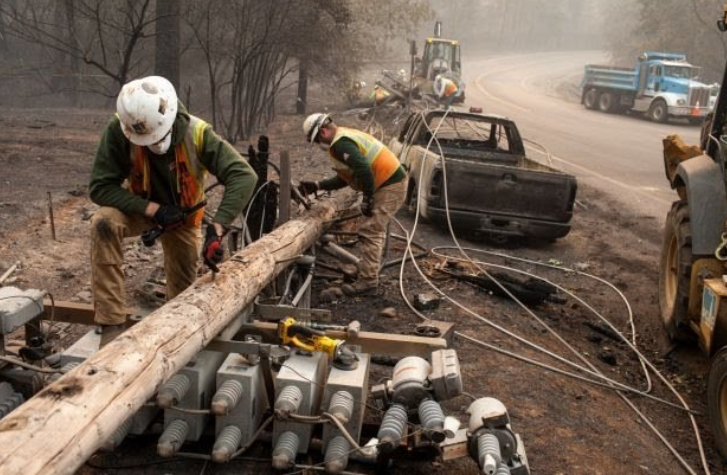
California’s largest utility, PG&E Corp. , says it is planning to file for bankruptcy by month’s end, citing an estimated $30 billion in liabilities it faces from more than 750 lawsuits related to its alleged role in sparking wildfires in recent years.
Related:
Layer1 Stabilizes Texas Grids With ‘Bitcoin Batteries’
Giant Batteries Supercharge Wind And Solar Plans
Regulator Weighs Disclosing Names of Utilities That Violate Grid Security Rules
America’s Electric Grid Has A Vulnerable Back Door—And Russia Walked Through It
Governments Turn Against Deep-Sea Mining In The Face Of Increase In Demand For Metals
Ultimate Resource On Small And Mega-Battery Innovations And Facilities
Homes And Farms Where Families Go Off the Grid
Dropping Off The Grid: A Growing Movement In America Part I
California Wants Its Salton Sea Located In The Imperial Valley To Be ‘Lithium Valley’
Ultimate Resource On Hydrogen And Green Hydrogen As Alternative Energy
“Mining Bitcoin could eventually help the world transition to green energy”. Calling Bitcoin mining “a great stabilizer” for the power grid, the Foundry Digital CEO said the technology could become a “bridge between the current energy production and a world where 100% of our energy is produced from renewables.”
“Bitcoin mining provides a steady base load and yet it’s still intermittent to allow grids stability,” said Colyer. “This creates a really powerful economic dynamic for renewable energy products.”
“Nation-states, they can’t sleep on this, and they’re going to find ways to take advantage of their natural resources to be involved in Bitcoin mining […] At some point Bitcoin mining will look like a utility, and it’s going to be a part of critical infrastructure for countries.” Mike Colyer, CEO of Foundry Digital, a crypto mining subsidiary of Digital Currency Group
————-
Hardening power networks against storms can cost billions of dollars and take years. But there are measures utilities can take to make their systems safer. Here are some of them.
Stronger Utility Poles
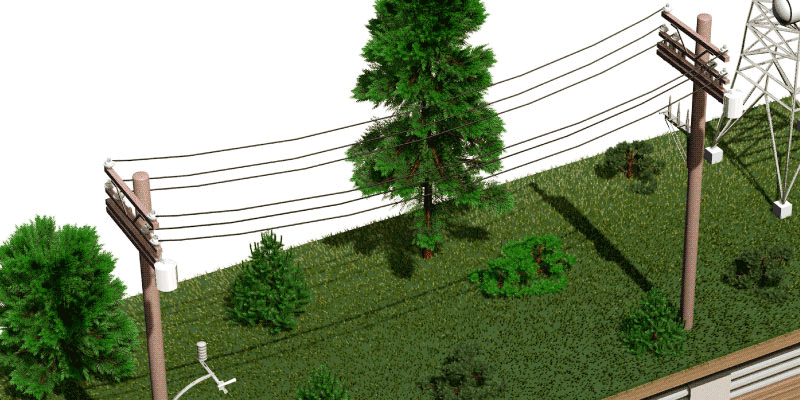
Among the most immediate improvements a utility can make is replacing flammable wooden utility poles with ones made out of concrete, steel or fiberglass, which are less fire-prone and stronger.
Florida Power & Light credits an extensive pole replacement program, begun after the devastating 2004 and 2005 hurricane seasons, with limiting the damage it saw during 2017’s Hurricane Irma. The new poles, many of them concrete, can withstand winds up to 145 miles an hour.
Insulated Power Lines
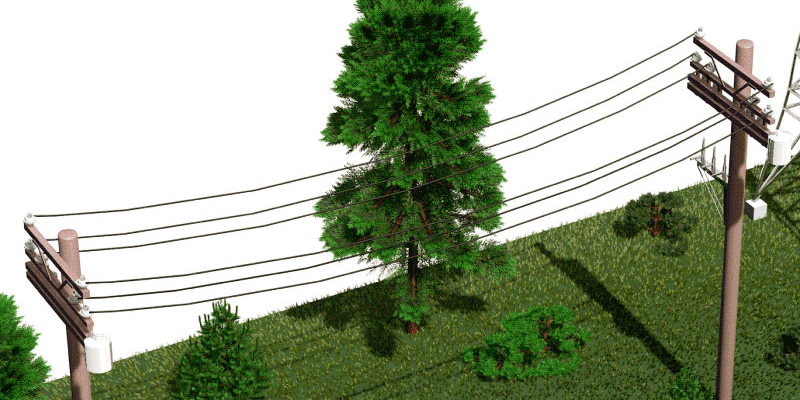
Traditional power lines aren’t insulated except by air, leaving the copper and wire conductors susceptible to damage from tree limbs, wildlife, even stray balloons.
To fix that problem, utilities have begun deploying power lines covered by three layers of insulation.
“These covered conductors are very effective to protect against a potential short circuit or arcing conditions,” said Bill Chiu, managing director of grid modernization and resiliency at Southern California Edison.
Buried Lines
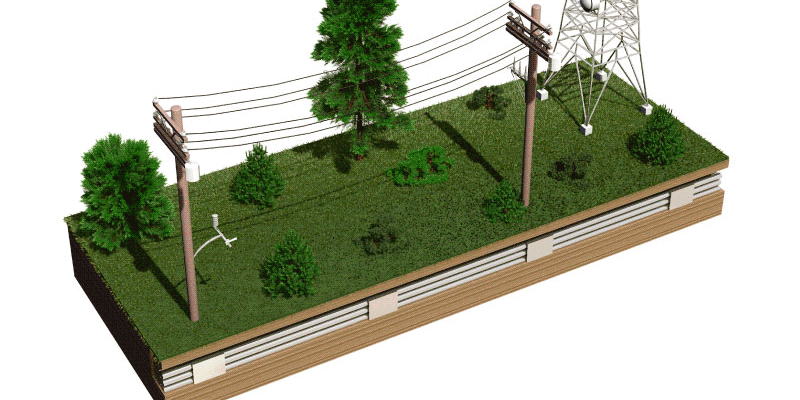
Utilities can protect power lines from dangers like falling trees by burying them underground, but it is expensive and can be difficult in some terrains. Southern California Edison and Pacific Gas & Electric estimate that it costs about $3 million a mile.
Duke Energy , which serves six states, including the Carolinas, has gotten around the cost problem by putting only the most troublesome sections of its lines underground. One drawback: When a problem occurs on an underground line, it can be tough to repair.
Sensors/Reclosers
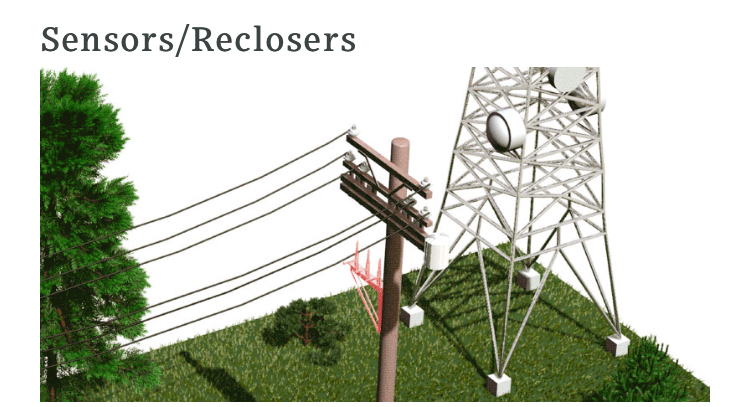
Utilities use sensors and switching technologies to catch and isolate problems on power lines. The sensors can alert a utility when power flow is disrupted or experiences a surge.
A switching technology called a recloser will then temporarily de-energize a line as it remotely tries to detect any anomaly, often automatically. Meanwhile, other switches kick in to reroute power around the trouble spot.
Duke Energy estimates this helped it avoid more than 80,000 extended outages during Hurricane Florence in September.
Weather Monitoring
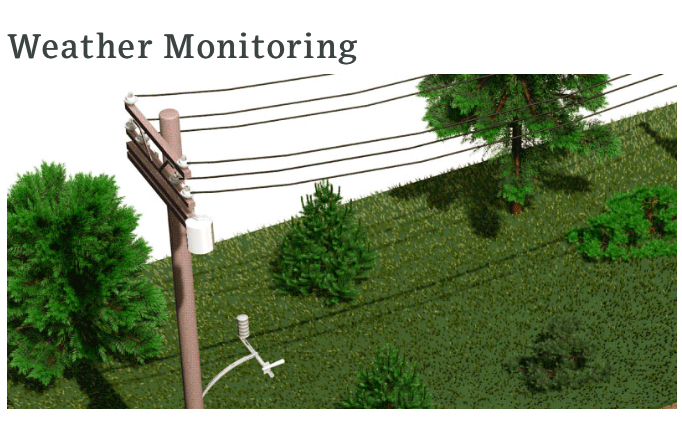
Knowing how weather conditions are playing out locally is critical to knowing how likely it is that a fire might ignite, as well as where and how quickly it might spread.
California utilities have been installing weather monitoring devices on power poles to supplement those used by public weather and fire agencies. The devices, typically installed at a height of 20 feet, measure wind speed, direction and gusts, as well as humidity and temperature.
Since 2010, San Diego Gas & Electric has installed 177 weather stations across an area the size of Connecticut, and has plans to deploy more.
Wildfire Cameras
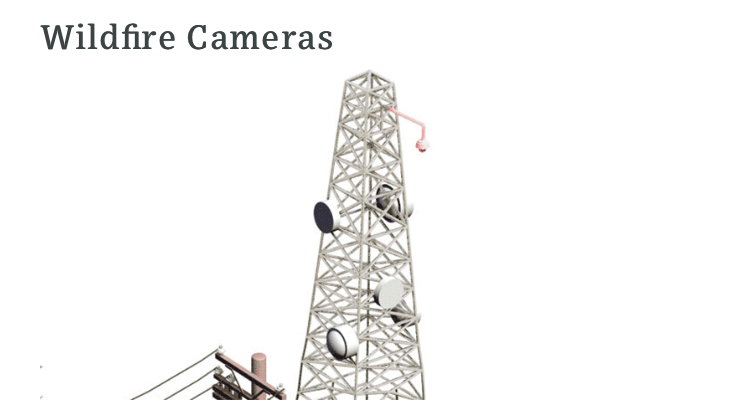
Utilities in the West have built camera networks that help them monitor the remote parts of their service territories. The cameras are often installed on telecommunications towers atop high peaks, and when they spot a fire, they can triangulate to give utilities and firefighting agencies a precise location.
Knowing whether there is a lot of vegetation in the area to fuel a fire, or nearby cities and towns, gives utilities and firefighters a jump start on figuring out how to battle a blaze and repair damage.
“You know what you’re dealing with immediately,” said Brian D’Agostino, director of fire science and climate adaptation for San Diego Gas & Electric.
MicroGrids Threatening The Utility Industry’s 100yr Old Monopoly On Power Generation And Distribution
Distributed Generation Microgrids Will Reach Nearly $13 Billion in Annual Market Value by 2018
You know that experience, when you buy a new car, and suddenly you see the model everywhere? Since Superstorm Sandy I’ve had the equivalent experience with the term ‘micro-grid.’
Policymakers and thought leaders in the US Northeast started talking micro-grid in earnest shortly after the October 2012 storm leveled swaths of their region. Lately, the term seems to arise in almost every interview I do about transmission and reliability – whether about the US, Japan, Sweden, India or other areas of the world.
These small, electricity islands have been around for a long time, but mostly confined to colleges and military bases. Are we about to see more widespread development?
Micro-grids are smaller versions of the larger grid, but the power plants are closer to the customer. Hence, they have fewer miles of wire that is vulnerable to falling trees. They are typically connected to the larger grid. But when the grid goes down, the micro-grid can disengage and keep operating. So micro-grids are used as a way to maintain electric reliability in carved-out areas.
I recently asked three respected smart grid experts for their views on a potential micro-grid boom, and they gave me three different slants.
“Truthfully, I think micrograms are a very good concept – it has certain applications – but not in general,” said GE’s John McDonald, director of technical strategy and policy development for GE Energy Management’s Digital Energy.
He sees micro-grids as successful in rural areas on military bases and at universities. “But you wouldn’t want to have, in the Continental US, the grid be composed of thousands of little micro-grids. It would be very difficult to manage that,” McDonald said.
Bradley Williams, vice president for industry strategy at Oracle Utilities, has a different view. Information technology can solve problems that inhibit more widespread use of microgrids, he says.
“The military bases and campuses are piloting this, but that is just the beginning,” Williams said.
He envisions communities driving future micro-grid development, particularly those with building codes that require solar, wind or other forms of self-generation.
“I do think it is coming: it will not be driven by the utilities,” he said, adding that utilities will get on board once they know micro-grids pose no danger to line workers – an information management issue that Oracle is working on.
Meanwhile, Michael Gordon, CEO of Joule Assets, describes the coming micro-grid as a bundling of distributed generation and virtual power plants, which can serve utility resource needs.
micro-grids will help alleviate a kind of inefficiency beginning to emerge on the grid as more and more consumers and businesses buy their own generators following each big storm, he said.
“People are installing things that are not cost-effective because they don’t want a one week outage,” said Gordon, whose New York company helps create energy reduction assets.
What’s coming are micro-grids made up of consumer-producers who will sell into the various electricity markets, Gordon said. The consumer will finance and build the asset and then sell energy, efficiency or demand reduction. The utility may act as buyer.
It is not only Superstorm Sandy that is spurring talk of micro-grid. Discussion heightened about the concept, as well, after the 2011 earthquake and tsunami in Japan. The Sendai micro-grid at Tohoku Fukushi University continued to provide power while the rest of the grid failed, points out a PWC report, “The Future of micro-grids: Their Promise and Challenges.”
micro-grids are also gaining steam because of the Obama administration’s push for more combined heat and power, which is often included within a micro-grid. Obama wants the US to build 40 GW of CHP by 2020.
Here Are A Couple Of Micro-Grid Developments To Watch In The US.
The Connecticut Department of Energy and Environmental Protection in February announced that it is evaluating 27 micro-grid projects for possible funding. The projects were among 36 that sought $15 million in available state grants. Some of the projects are sizable – as large as 10 MW. Governor Dannel Malloy has recommended an additional $30 million for the program over the next two years.
In nearby New York, Governor Andrew Cuomo has created an energy highway blueprint to modernize the state’s electric system, which has resulted in several proposals, some of them micro-grid.
Micro-Grids
With the launch of dozens of successful pilot programs globally, the adoption rate of micro-grids is expected to accelerate over the next several years. Micro-grids offer greater resilience, a high potential for integrating distributed renewable generation resources, and the ability to isolate themselves, when necessary, from the wider power grid–a capability known as islanding. According to a recent report from Navigant Research, North America is currently the leading micro-grid market and will remain the leader through 2020. Total micro-grid capacity in North America will reach 5.9 gigawatts in 2020, representing 64 percent of worldwide capacity, the study concludes.
“The U.S. has pockets of poor power quality scattered across the country, as well as a structure of behind-the-meter markets for distributed energy resources that favors micro-grids,” says Peter Asmus, principal research analyst with Navigant Research. “The latter has stimulated creative aggregation possibilities at the retail level of power service. Instead of being driven by grid operators or municipal utilities, which is the case in Europe, the micro-grid market in the United States is customer-driven.”
The first U.S. state moving forward with a policy program to promote micro-grids is Connecticut, which is responding to a pair of extreme weather events, according to the report: Tropical Storm Irene in August 2011 and a rare blizzard that hit the East Coast in October 2011. Both events led to massive power outages. This effort — which has authorized construction of up to 27 micro-grid sites as of early 2013 — is supported by an initial grant and loan program of $15 million.
North America Will Lead the Worldwide micro-grid Market With Nearly 6 Gigawatts of Total Capacity by 2020
Whether tied to the larger utility grid or islanded from it, micro-grids are becoming an increasingly common way for campuses, communities, and other large power users to harness the benefits of distributed power generation. Many of these systems are deployed by end-use customers who are not getting the quality of energy services they desire from their host distribution utilities. According to a recent report from Pike Research, a part of Navigant’s Energy Practice, annual revenues from distributed generation micro-grids will reach $12.7 billion in 2018.
“micro-grids represent a fundamental building block of the ultimate smart grid, designed to serve the needs of energy producers, consumers, and distribution utilities,” says senior research analyst Peter Asmus. “Perhaps most importantly, micro-grids are an important accelerator for various kinds of distributed power generation, particularly from renewable sources.”
Some of the technologies that will enable the growth of micro-grids in coming years, such as system controllers, are still immature, while others, such as solar photovoltaics, are already global markets in their own right. The foundation of any micro-grid is distributed generation (such as solar PV or small wind power), but nearly as critical are smart, bi-directional islanding inverters that enable micro-grids to operate in standalone mode, disconnected from the wider grid. Over the course of the next several years, the islanding function of inverters for renewable distributed energy generation, combined heat and power (CHP), fuel cells, and energy storage will become much more prevalent, according to the report.
Standard Solar To Install One of The Nation’s First Commercial Solar Micro-Grids
Standard Solar, a leader in the full-service development, construction, integration, financing and installation of solar electric systems, in partnership with Solar Grid Storage, today announced the installation of a grid-interactive energy storage system co-located with a new photovoltaic (PV) array, creating one of the nation’s first commercial scale micro-grids.
Located at Konterra’s corporate headquarters in Laurel, MD, this innovative, islandable micro-grid system is powered by a 402kW solar PV array. In the event of a grid power outage, the Solar Grid Storage advanced lithium-ion energy storage system allows critical circuits at Konterra to remain energized. The project is financed by the Kingdon Gould Jr. family and supported through a Maryland Energy Administration (MEA) “Game Changer” Grant.
“Widespread implementation of grid-connected energy storage systems is key to solar PV becoming a mainstream energy supplier,” said Tony Clifford, CEO of Standard Solar. “As one of the nation’s first commercial micro-grids, this project can truly be a game changer for PV. Not only does it provide backup power to Konterra, it also supports grid integrity and allows for participation in ancillary markets for electricity. The commercial potential of grid-based solar storage is enormous and we are honored to be leading the way in partnership with Solar Grid Storage, MEA and Konterra.”
The system has the potential to reduce PV project costs and offers new benefits to hosts including backup power, demand reduction and peak shaving. Moreover, the system can enhance grid reliability by helping balance the grid through frequency regulation, volt-ampere reactive (VARs) compensation, and demand response services. The system is scheduled to be operational by the fall of 2013.
MEA’s Game Changer Competitive Grant Program was created to provide cost-sharing grants for innovative clean energy generation technologies and market strategies in Maryland. The winning grantees embrace either a new technology or a new methodology that extends beyond existing renewable energy generation; the Game Changers seek to advance the market into uncharted territory. Winners were evaluated on the merits of their energy production, cost-effectiveness, market potential, project viability, cost share, project performance measurement and verification methodology, and project visibility. The projects are funded based on their ability to help the State meet its renewable energy portfolio standard of 20 percent by 2022, and the grant recipients’ progress towards that goal will be evaluated for two years following their award.
“Advancing our energy storage infrastructure builds greater confidence in Maryland’s grid resiliency,” said Abigail Ross Hopper, MEA Director. “Grid storage technology also improves the delivery service of our first responders, armed services, telecommunications, waste water treatment plants, and emergency shelters.”
Earlier this month, Standard Solar made its second Commitment to Action as part of the Clinton Global Initiative America (CGI America) meeting. CGI is an initiative of the Clinton Foundation that convenes global leaders to create and implement innovative solutions to the world’s most pressing challenges. During CGI America, held this month in Chicago, Standard Solar pledged a two-pronged commitment to address the industry challenge of fully integrating photovoltaics (PV) with the grid. The Konterra system is Standard Solar’s first project under this commitment.
About Standard Solar
Standard Solar, Inc. is a leader in the full-service development, construction, integration, financing and installation of solar electric systems. Dedicated to making solar solutions more accessible to businesses, institutions and governments, the company is leading the way to energy independence. Committed to offering responsible and energy cost-saving solar solutions that conform to the highest standards, Standard Solar is one of the most trusted and respected solar companies. Since 2004, Standard Solar has been the partner of choice to make solar energy financially accessible, helping customers through financing options, including Power Purchase Agreements (PPAs) and navigating expanded federal and state and local tax credits. The company’s Standard Energy Solutions (SES) division provides home energy solutions including home solar, energy efficiency and energy management services. Named one of the Fastest Growing Private Companies in America for three consecutive years by Inc. Magazine, Standard Solar is headquartered in Rockville, MD. For more information, please visit www.standardsolar.com.
About Solar Grid Storage
Solar Grid Storage is a company of experienced solar veterans who have developed a ground breaking business model to allow batteries to be added to commercial solar photovoltaic (PV) installations while lowering costs and adding new benefits. The Solar Grid Storage solution provides all standard PV functions while unlocking innovative new uses of solar energy. Its PowerFactor(TM) systems are deployed at virtually no cost to the host, enable PV systems to operate and provide emergency power during outages, can reduce peak demand charges, and help grid operators balance power on the grid. Solar Grid Storage’s technical expertise, industry insight, and proprietary storage-as-a-service model integrating storage into solar installations while reducing costs is ushering in the grid of the future.
CONTACT: PR Contact for Standard Solar:
Wilkinson Shein
Keira Shein, 410-363-9494
Military Installations Already Using Micro-Grids Successfully
America’s Defense Department is the largest single global consumer of petroleum, and its military operations comprise the largest demand for all forms of energy. In addition, bases located within the United States and abroad depend on aging transmission systems susceptible to cyber-terrorism and unreliability.
This report analyzes the uses and development of the military micro-grids. The report begins with an overview micro-grids and smart grids. It provides case studies of military installations already using micro smart grids successfully.
A micro-grid is a smaller version of the Smart Grid that is localized to a particular area, so its potential use for military functions is vast. Similar to the function of the smart grid, a military micro-grid is also expected to improve the energy efficiency and accelerate the integration of various renewable energy resources.
The DoD moves about 50 million gallons of fuel monthly in Afghanistan, much of which is for power generation. The fuel powers more than 15,000 generators in Afghanistan alone. What if, through use of micro-grid technologies, the military could cut that fuel transportation and use in half?
The Department of Defense is already working on establishing a network of independent micro-grids that integrate distributed renewable generation, electric vehicles, and demand response at its bases. The growth potential for military micro-grid market is anticipated to result in upwards of 54.8 megawatts total capacity by 2018.
According to the Secretary of Defense, 40+ DoD military bases either have operating micro-grids, planned micro-grids, or have conducted studies of micro-grid technologies. The DoD also has 600 forward operating bases (FOBs) and is investigating the deployment of mobile micro-grids in Afghanistan.
This report provides service and technology providers, government contractors, and military installations with a guide to understanding military micro-grids. It acts as a solid start to planning a military micro-grid design and installation, providing case studies of existing military micro-grid systems.
This report profiles major smart grids technology and service providers to the military. Companies profiled in this report include: Honeywell International, Lockheed Martin Corporation, Eaton Corp Plc, General Electric, Skybuilt Power, Sturman Industries, Sandia National Laboratories, and ZBB Energy Corporation.
Many other examples exist of the growing use of micro-grids. Readers, please feel free to use the comment section here to let us know about them.
Is The Utility Industry Doomed?
Utilities seem indispensable. Yet suddenly there is talk on Wall Street of a looming “death spiral” for the business, with solar power being the culprit.
Hyperbole? Yes, but only up to a point. Back in May, the Dow Jones Utility Average came within a whisker of its pre-crisis all-time high set early in 2008. High dividends sell well with investors when interest rates are so low, especially when such payments are backed by something as solid as the electricity grid.
But danger can come out of a clear blue sky or even a cloudy one. Take a look at Germany. Generous subsidies there caused solar panels to sprout all over what is hardly a tropical paradise. As traditional utilities E.ON and RWE have struggled to adapt, their combined market value has slumped 56% over the past four years in a rising German stock market.
The death-spiral thesis runs thusly. Subsidies and falling technology costs are making distributed solar power—panels on roofs, essentially—cost-competitive with retail electricity prices in places like the southwestern U.S. As more people switch to solar, utilities sell less electricity to those customers, especially as they often have the right to sell surplus power from their panels back to the utility.
The result: Utilities must spread their high fixed costs for things like repairing the grid over fewer kilowatt-hours, making solar power even more competitive and pushing more people to adopt it in a vicious circle.
But distributed solar power is still in its infancy. In sunny California, costs shifted onto customers without panels from those with them amounted to just 0.73% of that state’s utilities’ revenue last year, according to Moody’s. So why worry?
The utilities sector divides into two broad camps. Regulated utilities operate integrated networks of power plants, transmission and distribution grids. They agree to spending plans and an allowed rate of return with state regulators, determining customers’ monthly bills. Meanwhile, merchant generators operate power plants selling electricity to the highest bidder.
Despite the perceived threat to regulated utilities, it is actually the merchant generators who look more exposed to distributed solar power for now.
As a rival power source, solar takes market share from traditional generators. And once panels are installed, the sun’s energy is free, so it will displace more expensive sources such as gas-fired plants. This serves to reduce prices overall, so solar power cuts both volume and price for traditional generators. Not the sort of outlook that garners a high earnings multiple.
David Crane, chief executive of merchant generator NRG Energy, calls the spread of distributed energy the biggest change to hit the industry since the grid was built many decades ago. To adapt, NRG is investing in solar and other distributed sources, essentially taking cash generated today by its traditional business and redeploying it into growth opportunities.
For regulated utilities, the idea that solar panels will enable everyone to leave the grid, making such networks redundant, is overstated. Solar power is intermittent. Batteries can help, but ISI Group estimates their price needs to drop by a factor of 10 to be competitive with grid power.
Moreover, distributed energy’s small penetration means the existing grid is needed for a while to come. So regulators have to balance encouraging renewable power with the continuing need to prevent blackouts. Last month, regulators curbed Arizona Public Service’s planned charge to solar-panel owners to mitigate the costs of grid maintenance being pushed onto non-owners—but didn’t reject the idea of that fee altogether.
Even if panels don’t deal regulated utilities a fatal blow, investors still have cause for concern. Solar panels aren’t the only technology out there. For most of the U.S., natural gas from shale is a bigger energy opportunity. Gas isn’t free like sunlight. But it is still cheap—and available day or night. And besides power stations, it can fuel generation equipment that fits in a basement. Stirling engines, for instance, burn gas to make power and also capture useful heat.
Such machines potentially can be used alongside solar panels, allowing owners to switch between different sources. At that point, connection to the grid really can become optional.
Mass adoption is likely years away, but it is no longer over the horizon. NRG is piloting Stirling-engine products now. And while solar and wind power represent just 4.2% of the U.S. generation mix, they were only 1.3% five years ago, and the pace of adoption is accelerating. What looks too expensive or esoteric today can quickly make gains; think mobile versus fixed-line phones.
Distributed power will keep eating away at the traditional utilities’ share of an electricity market that is barely expanding anyway. U.S. electricity consumption this year is forecast by the Energy Department to be 2% below the peak in 2007. Efficiency efforts keep eroding electricity requirements.
“Essentially, we do not see the recent slowdown in electric load growth as cyclical anymore; it is a new and permanent feature of modern life,” says Julien Dumoulin-Smith of UBS.
That structural element is why, even if the sound of bells tolling is faint, the impact on utility stocks will be felt much sooner. Greg Gordon and Jon Cohen of ISI Group point out that absent expected growth in demand, regulators may be reluctant to approve regulated utilities’ investment plans. Why saddle bill payers with the cost of an asset built to last 40 years if it might only be needed for 15 or 20? And in this business, less investment means less allowed return—and, therefore, earnings.
For utility stocks, that squeezes the “terminal value”: the number put on forecast cash flows stretching into infinity that underpins a large chunk of most companies’ valuation. Messrs. Gordon and Cohen calculate a theoretical price/earnings multiple of more than 15 times for a utility with assets expanding at 3% a year, and with a terminal value. Cut growth to zero and take away the terminal value, and that earnings multiple drops by a quarter.
And in contrast to the past decade, U.S. interest rates look set to rise. So utilities will also find their dividends a less effective draw for investors, even as the competitive threat gathers steam.
The gyres may look exceedingly wide, but that spiral is taking shape.
Solar Energy Has Blown Past Grid Parity
For decades, grid parity has been the holy grail of the solar industry. It’s the mythical transition point when solar suddenly becomes cheaper than the grid, opening up a world of new demand and leading to a solar revolution.
As recently as two years ago, the solar industry was fighting the fact that solar power cost significantly more than the grid, requiring subsidies to keep the industry afloat. Today, rapidly falling costs have transformed the industry, and in many locations grid parity is already in the rear view mirror.
US And European Projects Are Already Below Grid Prices
US solar projects aren’t yet being sold to the grid on the spot market, but they are below retail prices and approaching parity with prices on the wholesale market. SunPower signed an agreement to sell power from its 100 MW Henrietta Plant in California for 10.5 cents per kW-hr, well below the state’s retail rate of about 16 cents per kW-hr.
First Solar is also selling power from a Macho Springs project in New Mexico for 5.79 cents per kW-hr. Even when you add in state incentives amounting to about 2.7 cents per kW-hr for the next ten years, the cost of about 8.5 cents per kW-hr is well below the 10.1 cent per kW-hr average cost of electricity in New Mexico during July.
Europe’s feed-in tariffs for solar power are now below 15 Euro cents per kW-hr, well below the 26.5 Euro cents the average retail customer pays.
Residential Solar Is The Game Changer
What has really upset the traditional energy industry is the expansion of homeowners generating their own power. SolarCity (NASDAQ: SCTY) is the industry’s leader, offering $0-down solar leases to customers who then sell excess power back to the grid. Solar leases still benefit from the 30% federal investment tax credit, but there’s no guaranteed rate from the utilities. In that respect, it’s the best judge of grid parity.
What SolarCity (and, to a smaller extent, SunPower) can do is lease panels for a lower cost than the price of retail power. In California, for example, that means leasing a solar system for $0.18 while utilities charge in excess of $0.20 per kW-hr. For SolarCity, payback comes over 20 years — and the payoff is projected to be between $1.50 and $2.70 per watt this quarter, versus a typical installation cost of about $3-$4 per watt.
Residential solar already costs less than the grid, and, considering the high margins SolarCity and SunPower are generating, there’s still opportunity to mover lower.
Solar Power Is Here To Stay
The cost of solar power is moving lower, while the cost of generating electricity from traditional sources typically rises 1%-3% each year. With solar already past grid parity in Chile, on California roofs, and on most utility scale projects, the sky is the limit for the industry.
Grid parity marks the point where solar demand should explode worldwide, and it’s blowing through that point faster than most people think.
To See The Future of Electric Power, Just Travel To Africa
Utilities may soon be obsolete in Hawaii and California. But let’s not forget that some parts of the developing world may simply leap-frog into the future, eschewing centralized grids for solar + storage solutions.
The government of Equatorial Guinea has selected MAECI Solar, a division of Management and Economic Consulting, Inc., in collaboration with GE Power Water and Princeton Power Systems, Inc., to install a 5-megawatt (MW) solar micro-grid system on Annobon Province, an island off Equatorial Guinea in west central Africa. The solar micro-grid will feature 5-MW solar modules and system integration by MAECI, an energy management system and controls from Princeton Power Systems and energy storage from GE. The island-wide micro-grid will provide reliable, predictable power, supply enough electricity to handle 100 percent of the island’s current energy demand and be the largest self-sufficient solar project on the continent of Africa.
“MAECI is fortunate to have witnessed firsthand the development of Equatorial Guinea over the past few years,” said Chris Massaro, senior vice president, MAECI. “We are extremely excited to bring this solar micro-grid solution to Annobon Island as well as support President Obiang Nguema’s vision to raise the quality of life for the people and bring economic diversification to Equatorial Guinea. This project brings both. The Annobon Electrification Project will be the platform for economic growth on the island by bringing a much needed power supply that will enable the development of multiple industries, add 700 to 1,000 direct and indirect jobs to Annobon Island and significantly raise the standard of living.”
Annobon Province has a population of approximately 5,000 residents. Today, the residents have reliable electricity for up to five hours per day and spend an average of 15-20 percent of their income on supplemental power. The solar micro-grid in development will eliminate this expense entirely and provide reliable electricity 24 hours a day, seven days a week. The project is a part of Equatorial Guinea’s National Economic Development Plan Horizon 2020, which aims to make Equatorial Guinea an “emerging economy” and accelerate its development and democratization by 2020.
“We’re excited to be a part of this historic project for Annobon Province and Equatorial Guinea,” said Jeff Wyatt, general manager of GE’s solar and energy storage business. “GE’s energy storage technology will help enable reliable, predictable power for the residents of Annobon through balancing the real-time supply and demand of solar and withstanding extreme heat environments without the need for air conditioning. This is an ideal technology for micro-grids like Annobon Island.”
The Annobon micro-grid is enabled by the Princeton Power Systems’ BIGI-250 energy management platform, the world’s first three-port industrial-scale solar energy management system, with UL listing and thousands of operating hours in commercial applications since 2012. Princeton Power Systems has extensive prior experience working with GE’s energy storage team. GE’s batteries, in addition to providing superior high temperature performance and improved safety, offer environmental responsibility with non-toxic and recyclable materials and worldwide support.
“Today, over 1 billion people are without power. We are taking our experience in micro-grids from Alcatraz Island, the U.S. Department of Defense and private sector customers to now apply it to improving quality of life for people in rural areas where grid power does not exist or is not reliable,” said Ken McCauley, president and CEO, Princeton Power Systems. “We look forward to future global projects across the world to provide power to these areas to have hospitals, lighting and other basic human needs.”
Projects
Nkoilale, Kenya:
PowerGen’s third Kiva funded micro-grid is also in the Maasai Mara. Nkoilale is a commercial center with various businesses catering to both locals and visitors passing through. The 1.4 kW micro-grid installed in May 2014 allows the business owners to better serve their customers while reducing their energy expenses.
Ololailumtia Village, Kenya:
This village on the edge of the Maasai Mara has two PowerGen micro-grids providing electricity to different portions of the town thanks to Kiva and its lenders. The micro-grids bring power for lighting, TV, refrigeration, a medical clinic and other uses of power to over 100 beneficiaries. The first was installed in March and the second in April of 2014. The March grid was the first ever micro-grid loan for PowerGen and Kiva and we are excited to build on the partnership to bring more renewable energy solutions to villages like Ololailumtia across Kenya.
Takawiri Island, Kenya:
This micro-grid in eastern Lake Victoria served 15 customers with a 705W AC grid when it was initially installed in December 2013. Since then, we have expanded the grid to reach 31 customers with a total of 1410W. We installed this grid with our partner, access:energy.
Mageta Island, Kenya:
The micro-grid on Mageta Island is the smallest of our three Lake Victoria grids with our partner, access:energy. Installed in December 2013, it is 360W and connects to seven customers.
Sinda Village, Zambia:
The Zambian micro-grid was installed in July 2013 and is currently bringing power to approximately 35 individuals in the Eastern Province town of Sinda. This project was completed with PowerGen’s partner in Zambia, Zamsolar. The micro-grid features metering technology from an American partner, Lumeter.
Remba Island, Kenya:
Along with our partner, access:energy, a micro-grid was installed in September 2013 on Remba Island in Lake Victoria. The island, known as “Slum Island,” is only a few hundred meters long, yet houses thousands of individuals who rely on generators, batteries, and kerosene as their only sources of power. The micro-grid has over 2 kW of solar and 1 kW of wind power that will provide electricity to hundreds on the island.
Updated: 2-16-2021
We’re Gonna Need A Better Power Grid
Once-in-a-lifetime events like the Texas polar vortex are becoming more routine, and our electrical systems can’t handle them.
Expect More Texas Vortexes
In northern New Jersey, where this newsletter is lovingly hand-carved from a single block of wood each day, there has been roughly a foot of snow on the ground for the past two weeks, with temperatures dipping repeatedly into the teens, with no noticeable effect on background levels of New Jersey-ness. Meanwhile, Texas gets some cold weather and a little snow on the ground, and the state is laid out like Conor McGregor.
Millions of Texans lack electricity after an overwhelmed system buckled beneath the weight of too many people turning up the heat just as icy weather froze all the stuff that makes the heat come on. The difference between New Jersey and Texas, at least on the limited issue of resilience to winter storms, is one of frequency: They just don’t happen that often in Texas.
Many Texans blamed frozen wind turbines, suggesting things would be better if we went back to powering everything with coal and gas. But fossil fuels froze up, too, and not that much wind capacity has shut down this week, Liam Denning notes. And cold weather hobbled Texas power back when wind was much less important. The real issue is an electrical system that’s not up to the task of handling extreme weather events, Liam writes. This is true not only of Texas but also New Jersey, wildfire-wracked California and every state in between.
Such once-per-generation weather crises are becoming annual events. The Jersey Shore faces rising sea levels and devastating hurricanes. California’s wildfire season now runs from January to December. And the polar vortex gripping Texas could become a regular feature as global warming weakens the jet stream. It may cost us, but we need a power system that can handle the punishment without making the underlying problems worse. Read the whole thing.
Updated: 6-13-2021
Is El Salvador Bitcoin’s Green Savior?
El Salvador’s move to make bitcoin legal tender offers an opportunity to prove that cryptocurrency can power renewable energy development, says CoinDesk’s chief content officer.
Well, the giant Bitcoin Miami love fest conference turned out to be more than just late-night beach parties. It actually delivered some news – a bombshell announcement big enough to quell concerns about the event being a COVID-19 superspreader event.
All week, the crypto world has been alight with the news that the Central American country of El Salvador will become the first nation to treat bitcoin as legal tender.
The implications of that announcement dominate this week’s newsletter. In particular, the main column focuses on the prospect of also spurring renewable energy development across the country via a system of bitcoin-funded community microgrids.
Bitcoin And Green Energy: El Salvador’s Leapfrog Chance
Possibly the only thing this week that got bitcoiners more excited than El Salvador President Nayib Bukele’s move to make bitcoin legal tender was his followup that bitcoin miners will get access to geothermal power from volcanoes.
The bitcoin community is not only celebrating a new Central American haven but pointing to El Salvador as a proving ground for “green” bitcoin. Because geothermal plants draw their energy from an existing, naturally occurring heat, their carbon footprint is minimal.
But I think El Salvador (population 6.4 million), one of the poorest countries in the Western Hemisphere, has an opportunity to make a far more groundbreaking energy play than the buzz generated by linking a volcano to a bitcoin mine.
A Humble Proposal: The government should work with miners, local community leaders and foreign investors to strategically fund the expansion of the country’s electricity coverage, specifically via a decentralized network of cheap, clean, cyber-secure, and community-empowering solar or wind-power microgrids.
The best way to overturn the flawed narrative – most recently furthered by U.S. Sen. Elizabeth Warren – that bitcoin will destroy the planet if we don’t curtail it is to demonstrate the opposite: that miners prefer low-cost green sources of power and that they can be a force multiplier for green energy infrastructure at large.
If executed properly, El Salvador’s bitcoin project could achieve a host of the United Nations’ Sustainable Development Goals (SDGs) in one shot. That’s a story I’d love to tell.
Underwriting Green Economic Development
While Warren, Elon Musk and others have been beating the drum about Bitcoin’s energy usage exceeding Sweden’s, bitcoin mines are being deployed in multiple locations across the world, not only to tap existing renewable or stranded energy sources such as wasted natural gas destined for flaring, but to underwrite the development of green electricity infrastructure to serve wider communities.
In a recent episode of our “Money Reimagined” podcast, Harry Sudock, vice president of strategy at mining infrastructure provider GRIID, told us his company is seeing relentless demand from wind, hydro and solar developers for bitcoin mining; co-locating facilities offers revenue guarantees that allow communities to expand renewables to serve local people.
Without those guarantees, these enterprises tend to stall because they depend on bureaucratically administered and sparsely distributed government subsidies to fund their rollout.
In other words, bitcoin mining can serve as that missing piece of risk capital needed to kick-start infrastructure projects, not only to shift the world toward renewable energy but also to foster economic development. There are deep-pocketed companies ready to do this – payments provider Square, for example, which is investing $5 million into a new bitcoin-driven solar facility run by Blockstream.
To maximize the social impact of this effort, we need to look beyond large-scale, state-run, centralized energy projects such as El Salvador’s geothermal plants and seek ways to fund community-based green power projects run as regional microgrids.
A decentralized network of such grids would provide what power experts call “redundancy,” creating multiple backups to offset the vulnerability of the centralized national grid to outages caused by weather or other disruptions. (For a sense of why centralized systems are more vulnerable, think of the tens of millions of people along the U.S. Eastern Seaboard who were impacted by a single ransomware attack on the Colonial Pipeline. A decentralized structure gives hackers a smaller payoff in terms of disruption.)
Most importantly, if bitcoin miners source their power from local, community-based grids, their payments for it – transferred in newly legal tender bitcoin – will go to those communities, providing a steady long-term source of income. (Ideally, microgrids would be governed as cooperatives, or even as distributed autonomous organizations, or DAOs, to ensure wide distribution of proceeds and that there is accountable reinvestment in sustainable development.)
With those funds in hand and new, more widely distributed, reliable, low-cost sources of electricity available, local entrepreneurs could, for example, build out a network of charging stations, creating the foundation for local businessmen to spin up electric vehicle transport services. There’d be power to pump water into farmers’ irrigation systems.
They could expand cell phone services, which are vital for bitcoin payment apps such as Lightning-based Zap, whose CEO, Jack Mallers, was instrumental in President Bukele’s bitcoin awakening.
The geothermal mining proposal is not antithetical to this idea. Bitcoin payments to the national geothermal energy company, LaGeo, would go to upgrading and maintaining the national system into which the microgrids are integrated to provide greater security and reliability. Or, in a direct application of the so-called “money battery” concept, energy tariff payments to the government by bitcoin miners could fund the development and maintenance of the microgrids in other places.
Flip The Debate
For those who believe bitcoin’s offer of a censorship-resistant, programmable, universally accessible source of digital currency is a positive force for the world, projects like this provide an opportunity to sway public opinion and get people to recognize that it can drive sustainable growth opportunities if managed properly.
We need to table the dysfunctional debate about bitcoin’s environmental impact. Critics focus on bitcoin’s energy consumption, but it’s the wrong lens. El Salvador and so many other poor countries need to consume more, not less, energy if they are to prosper. And excessive consumption is only a problem if the resource is finite, which is not the case with solar, wind or geothermal energy.
The problem is bitcoin’s mining’s source of energy. And the reality, one that too many crypto advocates ignore, is that bitcoin does access a massive amount of fossil fuel energy.
Its carbon footprint is by no means small and will grow bigger as usage expands unless deliberate actions are taken to reduce it.
We need policy actions that can put both sides of this debate into a more reasonable context. El Salvador can lead the way – especially given the interest among other Latin American leaders to follow its example.
Still, to ensure the spoils of development are spread among host communities and to keep miners and grid operators in a symbiotic contractual relationship that serves the interests of both, regulation is needed. Rules can be set for minimizing mining activity during peak hours to manage the “duck curve” problem caused by unused solar capacity and for ensuring there is constant reinvestment in capacity for the community at large.
The question is, will Bukele’s government, which has been accused of authoritarianism and has resisted efforts by U.S. President Joseph Biden to expand regional anti-corruption efforts, seize the initiative to spread the wealth? Or will corrupt officials and wasteful state companies monopolize the bitcoin windfall?
Well, here’s an opportunity for the Biden Administration to strike a deal.
Deeply poor El Salvador is one of the biggest sources of undocumented immigrants crossing through Mexico into the United States. If the U.S. sees the big picture here, it should take a more positive stance towards El Salvador’s Bitcoin policy than we’re currently hearing from Washington – the U.S.-dominated International Monetary Fund expressed concerns Thursday about it.
It can help the country leverage the opportunity to develop prosperity among the very communities that are sending their people on those treacherous journeys to the U.S.
This is a unique opportunity for everyone. Let’s not squander it.
Updated: 6-29-2021
Smart Charging Tries To Chill The Summer Power Grid
With a $9 million round, ev.energy seeks to shuffle electric vehicles off of power peaks and onto solar surges.
With summer heat frizzling already frazzled power grids, the California Independent System Operator, which handles the state’s grid and wholesale energy market, took a drastic step June 16: it asked electric vehicle owners to charge before 5 p.m. or after 10 p.m.
Battery-driven cars and trucks, tools to fight climate change, are ironically exacerbating heat-wave power outages. Thankfully, however, there’s a better option than just pulling their plugs.
A London-based startup called ev.energy is selling a software platform that directs a vehicle to chug electrons only at the most propitious times. Plug your Tesla in at 5:30 p.m. on a hot summer day and the system might not start tanking it up until 2 in the morning. The trick, beyond building a slick app where drivers punch in how long the vehicle will be plugged in, is getting an accurate snapshot of the grid.
Ev.energy’s system connects to utilities, electricity distributors and grid operators to forecast demand and nudge its network of 20,000 or so vehicles off the peaks and, when possible, into the troughs. In a best-case scenario, the arrangement cuts carbon emissions associated with a charging session by 20%.
“I know it’s a cliche, but I genuinely talk to my team about scenarios where it is actually a win for the customer, a win for the utility and a win for us,” said co-founder and Chief Executive Officer Nick Woolley. “And don’t forget the big goal, which is we get a faster decarbonization of transportation plus the electricity system as well.”
The system, which prioritizes charging when wind and solar generation is buzzing, will tweak its schedule to consider solar panels on a user’s home. One of its neatest tricks is to knock down the so-called renewable energy duck curve, getting thousands of cars to charge at the end of a particularly sunny or windy day when the grid is surging with green electricity.
To date, an electric vehicle’s charging has been pretty much only as smart as its owner. The greenest drivers try to avoid plugging in on a hot day, lest they siphon from a coal-burning plant that wouldn’t otherwise be running; but generally everyone is kind of fudging it — making a best guess based on weather and, occasionally, alarming warnings from state grid chaperones.
In three years, ev.energy, has signed on 16 energy companies in Australia, Europe and the U.S., while licensing its software to companies that make cars and vehicle-charging hardware. This morning, its staff of about 30 is celebrating $8.8 million in a new round of investment led by Energy Impact Partners, a New York-based firm focused on sustainable energy startups.
The company declined to disclose its valuation in the round or annual revenue. According to Woolley, it is one of the only smart charging startups bridging the gap between the grid and the driver.
The challenge will be signing on utilities. Many of those organizations find it easier to model and serve power demand when consumption is fairly static. And if anyone is going to flex large blocks of power, they like to be the ones doing it. To a power distributor, flipping the “off” switch on a giant factory that has agreed to idle at peak hours is a lot tidier than thousands of Chevrolet Bolts suddenly cutting the power cord.
Still, they’re coming around. In England, ev.energy bids on contracts in which it promises to make flexible a certain share of demand. In a best-case scenario, it also convinces utilities to give electric vehicle owners reduced rates to charge at certain times. “I think that is the window on the future for all utilities,” Woolley said.
The other hurdle, of course, is electric vehicle adoption. A place like Texas, for example, has major grid problems, but not enough electric vehicles, as of yet, to prioritize them as a potential circuit breaker.
To be sure, though, the business case improves by the day, every time an EV rolls out of a factory or a massive automaker pulls the cover off a new electron-driven vehicle. And when the battery-powered pickups finally arrive, a steady stream of them will be heading to Texas.
Updated: 7-21-2021
The World’s No. 1 In Geothermal Electricity, Kenya Aims To Export Its Know-How
By 2030 the country aims to almost double geothermal capacity, to 1.6GW.
When Kenya opened the Olkaria power plant four decades ago, it was considered more research project than commercial venture. Located in Hell’s Gate National Park, a barren zone of volcanic rock permeated by sulfurous gases and populated mostly by warthogs and zebras, the facility generated electricity using steam rising from deep in the ground.
The untested and costly geothermal technology was at best experimental, with the first unit expected to supply power for perhaps 10,000 homes. Today, Olkaria generates more than 50 times that, and the technology is on track to become the backbone of the country’s electricity grid. “Our strategy going forward is geothermal,” says Rebecca Miano, chief executive officer of the state-owned Kenya Electricity Generating Co., or KenGen.
For decades, Kenya and surrounding countries focused on hydroelectric power and oil-fueled thermal stations, but lately they’ve awakened to the potential of their vast underground energy resources. The region sits astride the Great Rift Valley, an area where tectonic plates meet, bringing the magma at the Earth’s core closer to the surface.
It’s one of the world’s most active volcanic zones—Mount Kilimanjaro lies at its heart—with dozens of hot springs hinting at the intense heat lying just below. Kenya gets nearly half of its electricity from geothermal plants, more than any other country, according to researcher Fitch Solutions, and it’s on track to increase that to almost three-fifths by 2030.
Olkaria, the continent’s first geothermal power station, is fed by pipes drilled almost 2 miles into the Earth’s crust. These deliver high-pressure steam as hot as 350C (662F), which is used to propel giant turbines.
Over the next five years, KenGen plans to invest $2 billion in four new plants and other upgrades at Olkaria that will almost double Kenya’s geothermal capacity to more than 1.6 gigawatts—enough to power a city of 1 million. Longer term, KenGen predicts, the country has the potential to generate at least six times that.
The biggest obstacle, in Kenya and across the region, has long been the initial investment. The turbines and other equipment above ground add up to about $3 million per megawatt, but the real expense lies below the surface. A single well can cost as much as $6 million, and each unit typically requires multiple drilling attempts to find sufficient steam to keep the turbines spinning; for the first station at Olkaria, KenGen drilled 33 wells.
Early on, geothermal “was thought of as too risky, and high upfront cost was a hindrance,” says Peter Omenda, a consultant who’s worked on numerous projects in the area. While technological advancements have brought down the price and made it easier to get more steam from each well, the expense of drilling remains a significant hurdle.
To help offset costs, Kenya in 2008 created the state-controlled Geothermal Development Co., which is intended to shoulder the investment risks associated with the technology. Similar to oil wildcatters, the GDC drills wells, and when it discovers a field that has potential, it sells the steam to KenGen or others that build the above-ground infrastructure.
The GDC has raised $746 million, mainly from international lenders such as the World Bank, to develop the Menengai Crater, a site about 60 miles north of Olkaria where three independent power producers expect to open geothermal plants in 2023, after years of delays.
Competition from other renewables, which can be faster to build and promise a more rapid return on investment, is another concern. Kenya gets about 12% of its electricity from wind and solar, up from less than 1% five years ago. Unlike those technologies, though, geothermal doesn’t require a stiff breeze or sunny skies to provide a steady flow of energy.
And when compared to hydropower—which Kenya is also counting on as it seeks to get to 100% renewable sources by 2030—geothermal plants aren’t threatened by droughts or belligerent neighbors that might cut off the water supply. “Geothermal provides clean, non-intermittent baseload electricity that other sources of renewables cannot,” says Derrick Botha, an analyst with Fitch Solutions.
For KenGen, geothermal is becoming a significant generator of revenue from outside the country. In February it won a $6.6 million contract to drill wells in Djibouti, and in 2019 it joined with two Chinese companies on a contract to provide geothermal drilling services in Ethiopia. KenGen says it’s in talks with Rwanda and the Democratic Republic of Congo as governments across Africa embrace geothermal.
“It’s going to be exciting to see that capacity transferred to other countries and a chance to replicate the business,” says Marit Brommer, executive director of the International Geothermal Association, a group that promotes the technology. “Geothermal power will enable access to electricity for many communities at an affordable price.”
Updated: 4-4-2017
Nigerian Scientist Invents Device That Can Supply The Entire African Continent Uninterrupted Power Supply

Nigerian engineer, Obayagbona Emmanuel Imafidon, has stated that he has invented a power-generating device that can solve the power shortage in the country. In an interview with Guardian, the graduate of Electrical Engineering from the Institute of Management and Technology in Enugu said he could generate power from thunder lightning and that he has been working on it since 2006.
He said: “I have been researching on generating constant power from thunder lightning. That is using a strike of thunder lightning to generate power that can serve Nigeria and Africa for five years and 30 days. That means that whenever thunder strike for once, we are sure of uninterrupted power for five years and thirty days.
“One may think it is not possible and if it is possible why the western world has not converted lightning to electricity, but what I have developed so far is a prototype. There are five chambers including the trapping zone which is made of lightning arrestor. There is the storage zone and the conversion zone, which convert static energy into current electricity and transmit the energy into transmission zone.
The transmission zones will first of all step down the power from as high as five mega volts and there are five storage zones that have the capacity of storing over 25 mega volts of power. “When it stores the 25 MV of power, the conversion zone takes one mega vote at a time, send signals to other sensory zones which shut down other sensory zones from discharging at the same time.
Now the transmission zone of the power generating plant will step down the megavolt to whatever Nigerians need. “For instance, Nigeria is generating 330,000 megavolts, but my device generate 5 million volts and then give Nigerians their 330 KV and still have about 4670, 000 megavolts left as reserve.
Nigerian engineer invents power-generating device to end blackout “Taking a look at the prototype, the first time I worked on it was March 10, 2006. I built this prototype with five zones- the power trapping zone, the annexing zone and in between the annexing zone, there is the sensory zone, conversion zone and transmission zone. In Nigeria, we are generating 330,000 volts. Now when thunder strikes, the trapping zone (which is made of trapping arrestor) will trap a maximum of 5 mega volts from 330mgv that comes from lightning.
“Lightning comes with 330 mega volts and the trapping arrestor here is capable of trapping five million megavolts, thereby allowing 330 megavolts to be wasted in the atmosphere for other lightning arrestors to trap and neutralise the energy to the ground through a process called earthling.
If you look at most masts around, you will see something like a Y-metallic shape placed on top of a building, this is called lightning arrestor. “The lightning arrestor is used to trap the power discharged from lightning and this comes with a lightning power of about 20 billion watts, while in Nigeria we are generating 2,600 megawatts of power. The voltage lightning comes along with 330 megavolts, while we are generating 330,000 megavolts.
So you can see that there is a far cry between lightning energy and hydro electricity which the country relies on. “The trapping zone will be built by the Russians, Germany or USA in order to capture a maximum of 5 mega volts and allow 330,000 megavolts to be wasted in the atmosphere for the trapping arrestor.
Now, the five megavolts trapped by lightning will send the signal or energy to the annexing zone. You can see that we have so many trapping zones here and that is because you don’t know the direction lightning may come from. So, we cannot use one lightning director to achieve the purpose and that is why we have several lightning arrestors here.
“We have various strategic places where these lightning arrestors will be mounted because we have some places that are prone to lightning and these include some parts of Enugu State like IMT area and Zik Avenue. When this lightning arrestor traps the lightning, it transmits energy down the annexing zone. Enugu State is going to be one of our trapping zones of lightning energy. We are going to have one in Edo, Cross River, Rivers and Delta states. “These riverine areas are prone to lightning.
After that, the transmission zone captures each storage zone which accommodates five megavolts each. The five storage zones will give 25 megavolts. With this you can move this quantity through the sensory zones, so that when one is discharging energy, signals will be sent to other sensory zones to trap down other capacitors so that they will not discharge at the same time. The reason is that if they discharge at the same time, before we wait for lightning to come again, it may take a longer time and people will say the invention is not complete. “That is why we have to create a control measure to shut down other storage zones when one is working.
For the one that is working the device is built in such a way that only one sensory zone works from the five megavolts stored in the first storage zone. “That one megavolt is being transmitted to the conversion zone and this is transmitting electricity into current electricity.
When lightning comes with static electricity for instance when there is power outage, especially when it is raining. All of a sudden, there is lightning haze and when it is so, you find out that when lightning strikes, the earth wire will absorb the lightening energy and that energy that is being discharged to the ground carries the energy to the house socket through earth wire.
And if the electricity is plugged to the wall socket, the neutral wire will transmit that energy through the wire that is inserted to the plug. When it gets to the electronics, it powers it automatically and that is the moment when it is going off, you will see smoke coming from the socket.
“I have not been able to trap lightning due to insufficient fund to buy the materials. To trap lightning you will need high level energy industrial storage capacitors and this will be built either by Germany, China or USA. It will be built in such a way that when lightning strikes, it will charge the capacitor and the capacitor will retain static energy and this energy that is being retained will be converted through a unit called conversion zone and the conversion zone is an industrialised material that will be built by synergic work of various engineers. It is a project for which the Nigeria Society of Engineers (NSE) needs to support me in order to come up with the work.
The materials to be imported for it are not within the country. “I have done investigations in Lagos, Onitsha and Aba and these things are not within the Nigeria market. We need to build a capacitor and the conversion zone. “Your car for instance, converts static energy to mechanical energy through the ignition system. That is what enables the car to move.
The generator converts static energy from the spark plug through the electrical energy and that is how you have light. The motorcycle converts static energy and that is why you can ride it. So it is possible to convert static energy, stored in the capacitor into electrical energy to give light. “On the other hand, we will consult other research bodies in Enugu like PRODA which is into building of prototype.
The conversion zone is another area where we can source for engineers to build. Currently, what I am doing is incomplete. The prototype cannot generate power, but theoretically it is possible and feasible because it has been proven over and over by professors at the University of Nigeria, Nsukka (UNN.) “There was a time I was interviewed by three professors from the UNN. They called me at a time to come and explain how the strike of lightning could generate electricity in Nigeria and Africa for five years and thirty days. Why I said Africa is because lightning does not only occur in Nigeria alone, it occurs across Africa. So wherever lightning occurs, this power generating plant will be built there.
“The NSE is there to further the experiment, research, inventions to bring them into limelight. I found out that government set aside funds for research but how the funds are being used is a different kettle of fish. I am emphasising on NSE because in the USA, when a young person invents anything, all their engineers gather to give their support. But in Nigeria, they will want you to carry out the research alone so that when you fail, they will say you don’t know what you are talking about.
“One major advantages of generating power from lightning is that it will save Nigeria from constant blackout. Every time you hear that water level has dropped and as such we are not able to generate enough electricity. There is no year that thunder does not strike in Nigeria and one strike of lightning can give power for five years and thirty days, then we will have enough power for our home and industrial needs.”
Updated: 11-6-2021
The Future of Power Is Transcontinental, Submarine Supergrids
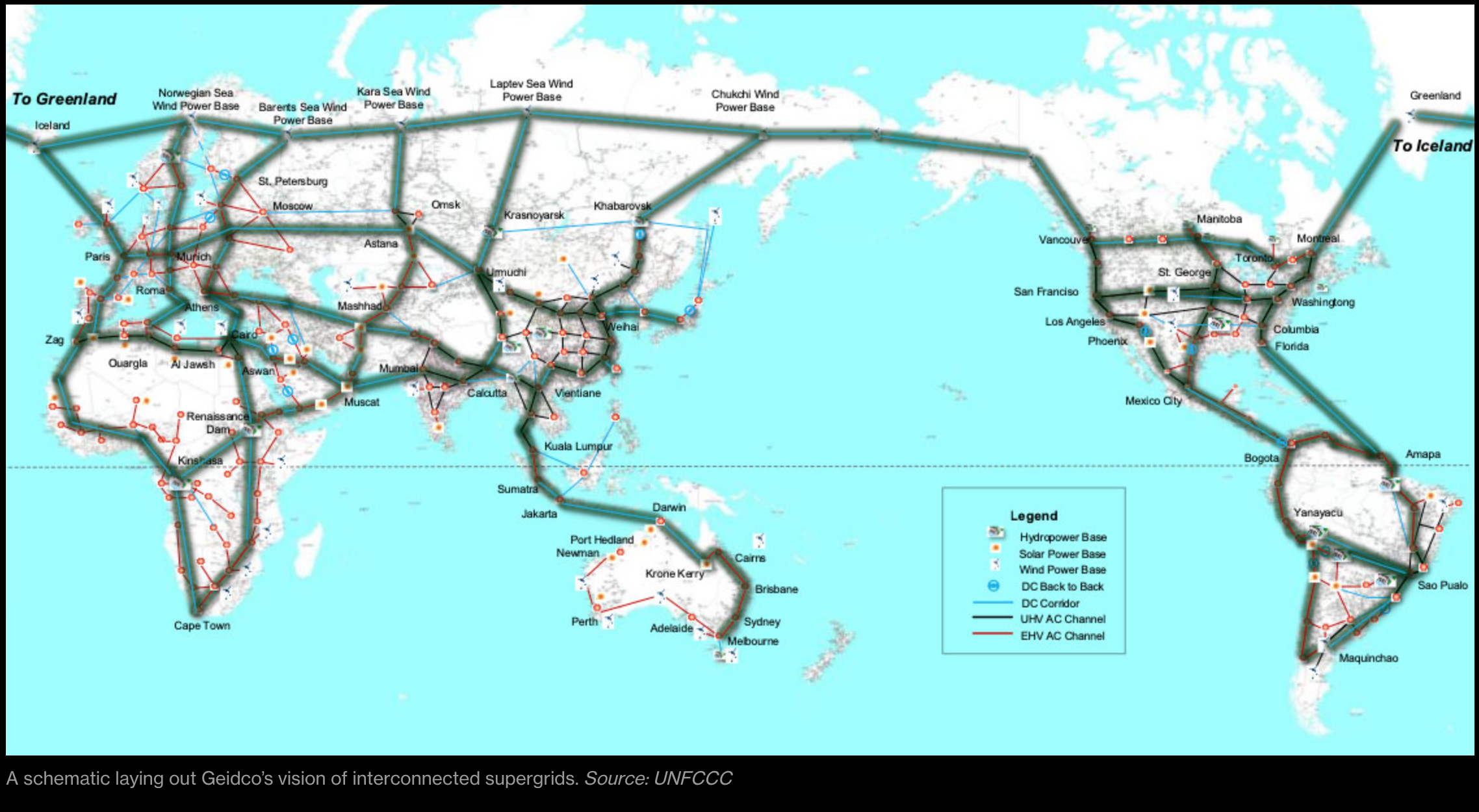
China wants to lead the way in creating a global energy internet.
Ever since President Xi Jinping pitched the idea of a “global energy internet” to the United Nations six years ago, China’s been trying to persuade the world to build the high voltage highways that would form its backbone.
That plan to wrap the planet in a web of intercontinental, made-in-Beijing power lines has gone pretty much nowhere. Yet the fortunes of so-called supergrids appear to be turning, if not on quite the spectacular, Bond-villain scale Xi first envisaged.
China has both a manufacturing and technological edge in ultra-high-voltage direct current (UHVDC) transmission lines, and has taken a lead in proposing global technical standards and governance for them.
If Xi’s plans are ever realized, those are advantages that some believe could have profound geopolitical implications, granting China power and influence similar to what the U.S. gained by shaping the global financial system after World War II.
Yet it isn’t China that’s driving renewed interest in cables that can power consumers in one country with electricity generated hundreds, even thousands, of miles away in another. That’s because carbon-neutrality commitments, technological advances, and improved cost incentives are accelerating a broad expansion of renewable power generation.
Coal, gas and even nuclear plants can be built close to the markets they serve, but the utility-scale solar and wind farms many believe essential to meet climate targets often can’t. They need to be put wherever the wind and sun are strongest, which can be hundreds or thousands of miles from urban centers.
Long cables can also connect peak afternoon solar power in one time zone to peak evening demand in another, reducing the price volatility caused by mismatches in supply and demand as well as the need for fossil-fueled back up capacity when the sun or wind fade.
As countries phase out carbon to meet climate goals, they’ll have to spend at least $14 trillion to strengthen grids by 2050, according to Bloomberg New Energy Finance. That’s only a little shy of projected spending on new renewable generation capacity and it’s increasingly clear that high- and ultra-high-voltage direct current lines will play a part in the transition. The question is how international will they be?
In April, the European Union set up a working group to help supersize its grid, already the world’s most developed international system for trading electricity, with goals including development of a multi-nation offshore network for wind farms.
Denmark in February announced plans to construct one piece, a $34 billion artificial Energy Island that will sit at the heart of a hub-and-spoke transmission system. With an eventual targeted capacity of 10 gigawatts, the project would add two-thirds to Denmark’s total existing generation capacity, too much to serve only its home market.
Even in the U.S., which has lagged on grid integration—as the deadly, multiday blackout in Texas revealed in February—interest is stirring. A March report from Breakthrough Energy, a group funded by Microsoft Corp. founder Bill Gates, offered scenarios for transcontinental HVDC lines to unite the U.S.’s three, still-separate grids.
President Joe Biden’s infrastructure proposal includes $100 billion for power grids and would establish a new Grid Deployment Authority “to spur additional high priority, high-voltage transmission lines” along federal highways, although it isn’t sure how much of that will make it through Congress. And a study commissioned by agencies in Canada, Mexico, and the U.S on the potential to connect their grids is due to be published this year.
For people who’ve been promoting the idea of supergrids for years, it feels as though the winds have turned in their favor. “I think our time has come,” says Mika Ohbayashi, director of the Renewable Energy Institute, a Tokyo-based organization set up in the wake of the 2011 Fukushima nuclear disaster by Softbank Group Corp. founder Masayoshi Son.
Its mission is to promote a Northeast Asia supergrid that would connect China, Japan, Mongolia, Russia, and South Korea. Says Ohbayashi: “I cannot imagine a Japan in 2050 which is still isolated from everywhere else.”
Europe has been building HVDC connectors to allow the controlled supply of power from one nation’s AC grid to another for decades: In 2018, European countries traded just over 9% of their electricity across borders, compared to less than 2% in the Americas and 0.6% in Asia, according to the International Energy Agency.
The trade tends to reduce prices by increasing competition. It also boosts resilience, ensuring that should one nation’s grid suffer a catastrophic outage, it could simply draw from others to keep the lights on.
But it’s the need for long-distance transmission that is driving a lot of the interest in supergrids right now, as the dash to replace fossil fuels with renewable energy gathers pace. That’s especially true for offshore windfarms, seen as a key growth area for renewables.
Although converting from AC to DC and back again at each end of a cable is expensive, lower loss rates mean that HVDC power lines become economical over distances higher than about 500 miles (800km) above ground, and 31 miles (50km) for buried and submarine cables.
Hornsea 1, currently the world’s largest offshore windfarm is 120 kilometers (75 miles) off the U.K. coast. Dogger Bank, an even bigger British project once complete, will be 5 miles further. And with the development of turbines on floating platforms, there are few limits on how far windfarms can be pushed out to sea.
This month Hitachi ABB Power Grids Ltd., a major provider of HVDC technology launched a new line of transformers developed specifically for floating turbines.
HVDC cables can also make viable the construction of remote, power plant-size renewable installations on land. Mongolia’s Gobi desert is at the heart of the Northeast Asia supergrid project promoted both by China and Ohbayashi’s institute.
In theory, the Gobi has potential to deliver 2.6 terawatts of wind and solar power—more than double the U.S.’s entire installed power generation capacity—to a group of Asian powerhouse economies that together produce well over a third of global carbon emissions.
The Gobi’s potential remains largely unrealized, in part because there is currently little means to deliver the power produced there beyond Mongolia’s tiny market.
The same goes for the U.S., where with the right infrastructure, New York could tap into sun- and wind-rich resources from the South and Midwest. An even more ambitious vision would access power from as far afield as Canada or Chile’s Atacama Desert, which has the world’s highest known levels of solar power potential per square meter.
Jeremy Rifkin, a U.S. economist who has become the go-to figure for countries looking to remake their infrastructure for the digital and renewable future, sees potential for a single, 1.1 billion-person electricity market in the Americas that would be almost as big as China’s.
Rifkin has advised Germany and the EU, as well as China; Xi’s vision of a global energy network is straight out of his 2011 book, The Third Industrial Revolution.
Persuading countries to rely on each other to keep the lights on is tough, but the universal, yet intermittent nature of solar and wind energy also makes it inevitable, according to Rifkin. “This isn’t the geopolitics of fossil fuels,” owned by some and bought by others, he says. “It is biosphere politics, based on geography. Wind and sun force sharing.”
If transcontinental, submarine electricity superhighways indeed lie in our shared future, China is showing the way. In December, it completed a $3.45 billion, 970-mile-long, 800-kilovolt UHVDC line to carry solar- and wind-generated power from the high Tibetan plains to China’s center.
That followed construction of a 1.1 million-volt cable that can transmit up to 12,000 megawatts of power—a little more than the entire installed generation capacity of Ireland—from the deserts and mountains of Xinjiang province to the doorstep of Shanghai, almost 2,000 miles east. (High voltage cables are classed as 500 kilovolts and above, while ultra-high voltage—a Chinese specialty—operate at 800 kilovolts or above.)
The global supergrid effort has been spearheaded by Liu Zhenya, a former head of the State Grid Corp. of China (SGCC), who chairs the Global Energy Interconnection Development and Cooperation Organization, a UN-backed body based in Beijing.
Geidco’s phased plan starts by strengthening national grids and moves on to building regional networks, before finally—around 2070—completing construction of a full 18-channel Earth-spanning grid.
SGCC, which is the world’s largest utility, has been on a buying spree that’s enabling it to do some of that first-stage strengthening. Since 2008, it has acquired stakes as high as 85% in electricity distribution companies in the Philippines, Portugal, Australia, Hong Kong, Brazil, Greece, Italy, and last year, Oman. Other Chinese companies have also been buying shares in foreign grids.
“From a U.S. perspective, this is something to be worried about,” says Phillip Cornell, an energy specialist at Washington’s Atlantic Council. “It isn’t that ‘I will cut off your power,’ like Russia cut off gas supplies to Europe in 2006, or like OPEC in the ‘70s.
But the equation with the global financial system is a good one. You are laying down the backbone of countries’ power systems, and there is a lot of hardware and software involved. All of a sudden, you are in a Chinese ecosystem.”
Such ecosystem concerns led the U.S. to pressure allies to bar China’s Huawei Technology Co. Ltd from participating in the building of 5G networks. In the age of the Internet of Things, electricity grids and communications networks will increasingly provide access to each other, an assumption that lies at the heart of Xi’s global energy plan.
“Is there potential for backdoor access by the Chinese state?’’ asks Cornell. “There is certainly a lot of access to consumer information—and you can imagine that, in future, would create a lot of leverage.”
If the U.S. hasn’t voiced the kinds of security concerns over Xi’s global grid push that it has over Huawei, that’s probably because China has struggled to get its ambitions off the ground. Of the 125,000 km of high-voltage grids Geidco mapped in a 2019 report, very little has been built. The first stage of a Pakistan-China link, due to go live later this year, marks an exception.
The Northeast Asia supergrid, for now, remains a desktop project. The Asian Development Bank’s seven-nation Greater Mekong Subregion Power Trading and Interconnection initiative has made slow progress since its launch in 1992.
After some heavy-handed selling of supergrids in speeches and conferences—Liu Zhenya has likened them to intercontinental ballistic missiles and boasted that China would set global technical standards—officials in Beijing have begun to soft-pedal some of the more controversial proposals.
One example: to create a centralized international body that would direct and oversee the operation of a global grid. A spokeswoman for Geidco declined to discuss the supergrid plans.
Instead, she provided Liu’s speeches and reports describing the potential for a Global Energy Interconnection to end the climate crisis and produce a “global win-win.”
Ohbayashi says Japanese politicians still don’t dare even hint at the possibility that they might volunteer to hook the nation’s energy system to China’s. A Japanese energy plan released in April would double power flows between the nation’s still siloed domestic grids—a potential start—but said little about connecting to other countries.
If these supergrids don’t get built, it will be because their time has both come and gone. Not only are they expensive, politically difficult, and unpopular—they have to cross a lot of backyards—their focus on mega-power installations seems outdated to some.
Distributed microgeneration as close to home as your rooftop, battery storage, and transportable hydrogen all offer competing solutions to the delivery problems supergrids aim to solve.
In China’s vision of an energy internet, these aren’t mutually exclusive. Jan Vande Putte, a Brussels-based energy analyst for the environmental lobby Greenpeace, concurs. “All this will be needed, but none will be enough,” he says.
“To integrate such large amounts of renewables into the grid, you can talk about battery storage and other things, but grid transfer is still the most cost-effective and efficient,” he says, adding that the EU and others are likely to move incrementally, with recognizable supergrids emerging only after 2030.
Gerhard Salge is chief technology officer at Hitachi ABB Power Grids, formed last year when Japan’s Hitachi bought 80% of Swedish-Swiss ABB’s power grid business for $6.85 billion. He has no doubt that demand for the multi-thousand ton AC/DC converters his company builds will grow.
“We need to go massive into wind, into the best solar locations, and also the best onshore wind—to the desert in Chile or to Northern Russia in the Arctic wind zones, where you have permanent wind blowing all year,” Salge says. In the U.K., ABB Hitachi is building a cable from Yorkshire to a unit of the Dogger Bank offshore wind farm.
Other mega-projects may take a while, though. For Mongolia, becoming the Saudi Arabia of wind and solar power might seem an irresistible opportunity.
The government is publicly in favor, but after it moved the regulatory goal posts on early investors, efforts to build more renewable generation there have stalled, says Aida Sitdikova, director for energy and natural resources in Russia, the Caucasus, and Central Asia at the European Bank for Reconstruction and Development, which has co-invested in several Mongolian wind and solar projects.
“For a supergrid to take off, the country has to show that it can build renewables, can attract investment, and has the appropriate regulatory environment,” says Sitdikova. Mongolia has yet to meet those tests. Last year, it did agree to develop new power generation capacity for export to China—but by building a new coal-fired plant.
More cross-border networks of high-voltage power lines are likely to get built, despite all the obstacles and competition from new technologies, says Josh Novacheck, a researcher in the grid systems group of the U.S. Department of Energy’s National Renewable Energy Laboratory.
Yet that’s more likely to happen along the incremental, organic model that historically was followed by the U.S. electricity grids, he says, rather than any Chinese long march.
“I definitely see that path forward happening,” says Novacheck, “instead of any large centralized plan of: ‘Let’s globalize this.’”
Updated: 1-31-2022
Texas Beginning Of The Year Deep Freeze Brings A Fresh Test To The Power Grid
* Dallas Likely To Get Snow, Permian Basin Gets Deep Freeze
* Frigid Conditions Likely Won’t Rival February 2021 Crisis
Texas is facing an Arctic blast this week that threatens to leave Dallas blanketed in snow, freeze oil and natural gas production areas and will test the state’s power grid.
The cold will whip temperatures in Dallas from a high of 67 degrees Fahrenheit (19 Celsius) Monday to a low of 20 Thursday night, with ice and snow starting late Wednesday, according to the National Weather Service. Temperatures in Midland — business center of the Permian Basin — will drop to 15 degrees Wednesday and then plunge further Thursday night.
“Combined with the ice and snow, unseasonable cold temperatures will impact the region,” the weather service said. “Temperatures will fall below freezing Wednesday and may not rise above freezing until the weekend.” Wind chills will make temperatures feel below zero for much of the area.
The weather will challenge the state’s energy infrastructure, though it currently looks less likely to lead to a repeat of last February’s cold snap that took down scores of power plants, triggering catastrophic blackouts that left more than 200 people dead.
Natural gas production has dipped twice already in January because of freezing temperatures. On Jan. 20, output fell 6.2%, according to preliminary BloombergNEF data based on pipeline flows. A cold blast also disrupted supplies to start the year. Production shut-ins can happen across Texas in cold weather.
A winter storm watch was issued for parts of central and eastern Texas. The weather is part of a larger storm set to sweep across the central and eastern U.S., which has prompted additional watches from Oklahoma to New York’s Lake Ontario coastline. Parts of Illinois, Indiana, Michigan, and northwest Ohio may get as much as 10 inches (25 centimeters) of snow.
While the cold will be driven by a blast of Arctic air, similar to last February, “it will not be of the same magnitude,” said Judah Cohen, director of seasonal forecasting at Atmospheric and Environmental Research, part of the risk analytic firm Verisk.
Water vapor is the enemy of gas producers in frigid weather because it can turn to ice inside equipment, wreaking havoc on operations and disrupting flows. But the industry is not defenseless.
In addition to simple measures such as insulation, operators often use external heaters and line heaters to prevent water from freezing inside lines. Others keep chemicals such as methanol and glycol on standby to inject into lines to prevent freezing.
“This doesn’t look like it will be as extreme as the last event in February 2021,” said Rich Otto, a forecaster at the U.S. Weather Prediction Center.
High temperatures across northwest Texas that are usually about 55 degrees at this time of year will dip 30 to 40 degrees below normal, Otto said.
Once the cold front moves through, parts of the state could face frozen precipitation that could impact wind farms in West Texas starting as soon as Wednesday night, according to Ercot, the power-grid operator.
Ercot plans to manage the grid more aggressively than it has in the past, officials said at a meeting Monday. Asking the public to conserve by delaying running dryers or dishwashers is a valuable tool that probably won’t be seen as a big imposition. Ercot, formally the Electric Reliability Council of Texas, is also asking generators to include how much capacity may be offline because of fuel limitations when they submit outage updates.
“We are going to continue to operate as conservatively as we have been,” Dan Woodfin, Ercot’s vice president of operations, said at the meeting.
Average temperatures throughout the state will linger 5 to 8 degrees below normal through Feb. 9, and start to moderate only slightly through Feb. 14, according to the Commodity Weather Group LLC.
“We continue to monitor the Texas story later this week with the potential for natural gas freeze-offs and winter precipitation, as well as a major winter storm with heavy snow and icing potential for the Midwest,” Matt Rogers, president of the Commodity Weather Group, wrote in a note to clients.
Updated: 2-18-2022
America’s Power Grid Is Increasingly Unreliable
Behind a rising number of outages are new stresses on the system caused by aging power lines, a changing climate and a power-plant fleet rapidly going green
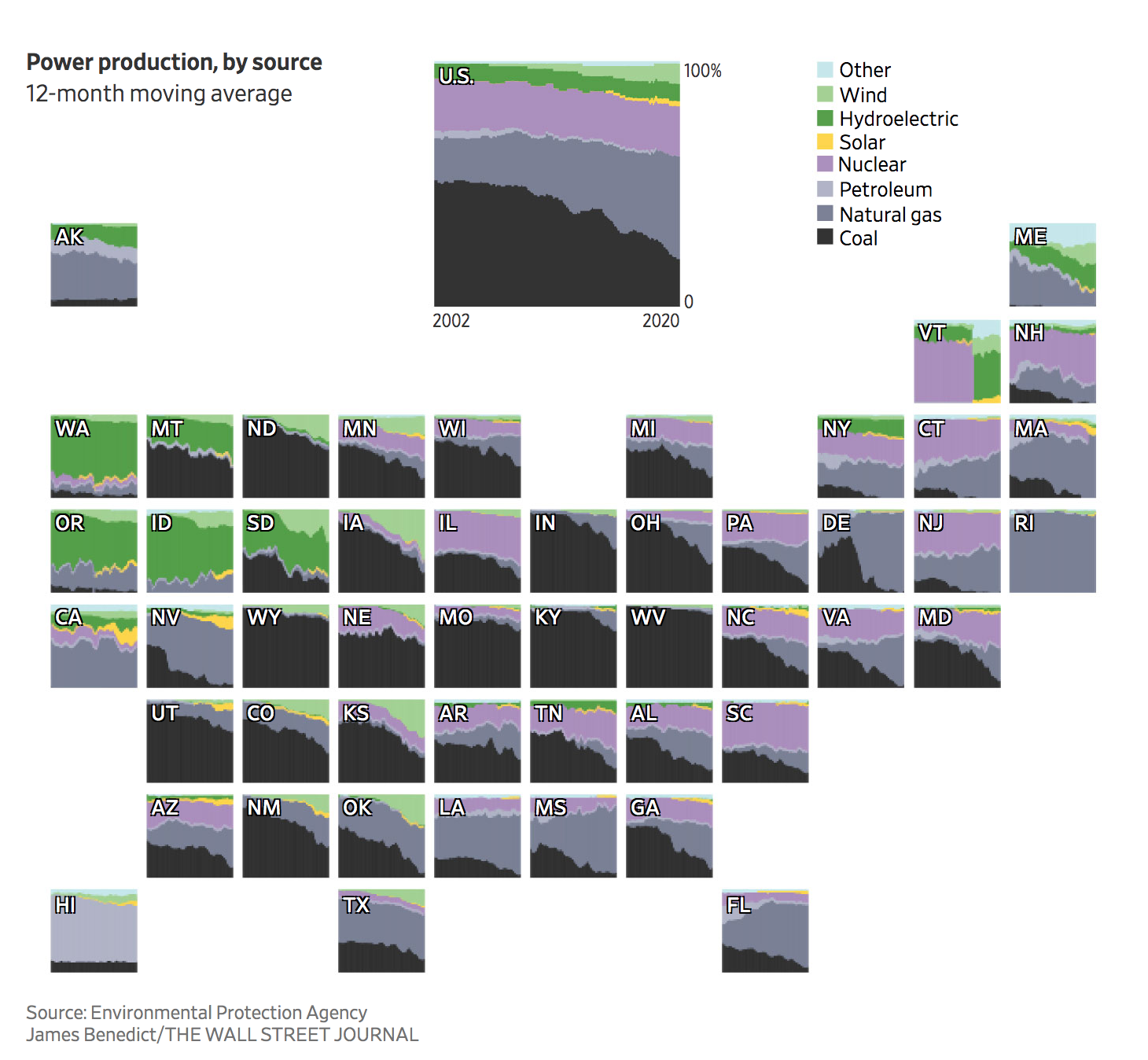
The U.S. electrical system is becoming less dependable. The problem is likely to get worse before it gets better.
Large, sustained outages have occurred with increasing frequency in the U.S. over the past two decades, according to a Wall Street Journal review of federal data. In 2000, there were fewer than two dozen major disruptions, the data shows. In 2020, the number surpassed 180.
Utility customers on average experienced just over eight hours of power interruptions in 2020, more than double the amount in 2013, when the government began tracking outage lengths. The data doesn’t include 2021, but those numbers are certain to follow the trend after a freak freeze in Texas, a major hurricane in New Orleans, wildfires in California and a heat wave in the Pacific Northwest left millions in the dark for days.
The U.S. power system is faltering just as millions of Americans are becoming more dependent on it—not just to light their homes, but increasingly to work remotely, charge their phones and cars, and cook their food—as more modern conveniences become electrified.
At the same time, the grid is undergoing the largest transformation in its history. In many parts of the U.S., utilities are no longer the dominant producers of electricity following the creation of a patchwork of regional wholesale markets in which suppliers compete to build power plants and sell their output at the lowest price.
Within the past decade, natural gas-fired plants began displacing pricier coal-fired and nuclear generators as fracking unlocked cheap gas supplies. Since then, wind and solar technologies have become increasingly cost-competitive and now rival coal, nuclear and, in some places, gas-fired plants.
Regulators in many parts of the country are attempting to further speed the build-out of renewable energy in response to concerns about climate change. A number of states have enacted mandates to eliminate carbon emissions from the grid in the coming decades, and the Biden administration has set a goal to do so by 2035.
The pace of change, hastened by market forces and long-term efforts to reduce carbon emissions, has raised concerns that power plants will retire more quickly than they can be replaced, creating new strain on the grid at a time when other factors are converging to weaken it.
One big factor is age. Much of the transmission system, which carries high-voltage electricity over long distances, was constructed just after World War II, with some lines built well before that. The distribution system, the network of smaller wires that takes electricity to homes and businesses, is also decades old, and accounts for the majority of outages.
A report last year by the American Society of Civil Engineers found that 70% of transmission and distribution lines are well into the second half of their expected 50-year lifespans. Utilities across the country are ramping up spending on line maintenance and upgrades. Still, the ASCE report anticipates that by 2029, the U.S. will face a gap of about $200 billion in funding to strengthen the grid and meet renewable energy goals.
Another factor is the changing climate. Historically unusual weather patterns are placing great stress on the electric system in many parts of the U.S., leading to outages.
Weather-related problems have driven much of the increase in large outages shown in federal data, topping 100 in 2020 for the first time since 2011. Scientists have tied some of the weather patterns, such as California’s prolonged drought and wildfires and the severity of floods and storms throughout the country, to climate change.
They project that such events will likely increase in years to come. Unlike electric systems in Europe, distribution and transmission lines in the U.S. were typically built overhead instead of buried underground, which makes them more vulnerable to high winds and other weather.
Those weather extremes are raising the costs of power network upgrades for utilities all over the country. That in turn is set to raise power bills for homeowners and businesses.
Public Service Enterprise Group Inc., which serves 2.3 million electric customers in New Jersey, plans to invest as much as $16 billion in transmission and distribution improvements over the next five years to replace aging equipment and make the grid more resilient to extreme weather events, such as a highly unusual spate of tornadoes that swept the state last year.
Ralph Izzo, PSEG’s chief executive, said the plan is critical to ensuring reliability, especially as customers become more dependent on the grid to charge electric vehicles and replace traditional furnaces and gas appliances with electric alternatives.
The movement toward electrification is in part driven by consumers, amid mounting concerns about climate change, as well as initiatives among cities and towns to enact mandates aimed at phasing out natural gas for cooking and heating.
“That resiliency needs to be further enhanced, because the solutions to climate change are going to put more challenges on the grid,” Mr. Izzo said. “Those are the kinds of things that really keep you awake at night.”
The historic shift to new sources of energy has created another challenge. A decade ago, coal, nuclear and gas-fired power plants—which can produce power around the clock or fire up when needed—supplied the bulk of the nation’s electricity. Since then, renewable energy sources, including wind and solar farms whose output depends on weather and time of day, have become some of the most substantial sources of power in the U.S., second only to natural gas.
Grid operators around the country have recently raised concerns that the intermittence of some electricity sources is making it harder for them to balance supply and demand, and could result in more shortages.
When demand threatens to exceed supply, as it has during severe hot and cold spells in Texas and California in recent years, grid operators may call on utilities to initiate rolling blackouts, or brief intentional outages over a region to spread the pain among everyone and prevent the wider grid from a total failure.
Companies around the country are rapidly adding large-scale batteries to store more intermittent power so it can be discharged during peak periods after the sun falls and wind dies. But because such storage technology is somewhat new, and was, until recently, relatively expensive, it remains a small fraction of the electricity market, and grid operators agree much more will be needed to keep the system stable as more conventional power plants retire.
The problem could soon threaten New York City. The New York Independent System Operator, or NYISO, which oversees the state’s power grid, last month warned of possible supply shortages in the coming years as several gas-fired power plants close or operate less frequently in light of stricter state air quality rules.
New York, which has set a goal to eliminate emissions from its electricity supplies by 2040 and no longer has any coal-fired power plants, also recently shut down a nuclear plant some 30 miles north of Manhattan after critics for years called it a safety hazard.
NYISO said its reserve margins—how much electricity it has available beyond expected demand—are shrinking, increasing the risk of outages. A 98-degree, sustained heat wave could result in shortfalls within New York City as soon as next year, a circumstance that would likely force NYISO to call for rolling blackouts for the first time ever.
“We already foresee razor-thin margins,” said Zach Smith, NYISO’s vice president of system and resource planning. “The risk is compounded when we take into consideration unforeseen events.”
New York is adding substantial amounts of new wind and solar generation, as well as battery storage, and NYISO has said that it is critical that the projects remain on track to improve the stability of the system in the coming years. Already, wind and solar developers across the country are facing headwinds related to supply-chain issues, inflation and the amount of time it often takes to get approval to connect to the grid.
The North American Electric Reliability Corp., a nonprofit overseen by the Federal Energy Regulatory Commission that develops standards for utilities and power producers, warned in a report last month that the Midwest and West also face risks of supply shortages in the coming years as more conventional power plants retire.
Within the footprint of the Midcontinent Independent System Operator, or MISO, which oversees a large regional grid spanning from Louisiana to Manitoba, Canada, coal- and gas-fired power plants supplying more than 13 gigawatts of power are expected to close by 2024 as a result of economic pressures, as well as efforts by some utilities to shift more quickly to renewables to address climate change.
Meanwhile, only 8 gigawatts of replacement supplies are under development in the area. Unless more is done to close the gap, MISO could see a capacity shortfall, NERC said. MISO said it is aware of this potential discrepancy but declined to comment on the reasons for it.
Curt Morgan, CEO of Vistra Corp. , which operates the nation’s largest fleet of competitive power plants selling wholesale electricity, said he is worried about reliability risks in New York, New England and other markets as state and federal policy makers pursue ambitious goals to quickly phase out fossil fuel-fired power plants.
His concern is that the plants will retire before replacements such as wind, solar and battery storage come online, he said, given the cost and challenge of quickly building enough batteries to have meaningful supply reserves.
“Everything is tied to having electricity, and yet we’re not focusing on the reliability of the grid. That’s absurd, and that’s frightening,” he said. “There’s such an emotional drive to get where we want to get on climate change, which I understand, but we can’t throw out the idea of having a reliable grid.”
Serious electricity supply constraints have historically been rare. Most recently, the Texas grid operator called for sweeping outages during an unusually strong winter storm last February that caused power plants and natural gas facilities of all kinds to fail in subfreezing temperatures. Millions of people were in the dark for days, and more than 200 died.
California, which experienced outages during a West-wide heat wave in the summer of 2020, also called on residents to conserve power several times last summer amid a historic drought that constrained hydroelectric power generation across the region.
The state is now racing to secure large amounts of renewable energy and batteries in the coming years to account for the closure of several conventional power plants, as well as potential constraints on power imported from other states when temperatures rise.
California state Sen. Bill Dodd, Democrat from Napa, recently introduced legislation that would require the state’s electricity providers to offer programs that compensate large industrial power users for quickly reducing electricity use when supplies are tight, helping to ease strain on the grid.
“We just can’t go down the road of having rolling blackouts again,” Mr. Dodd said. “People expect their government to keep the lights on, and our reliability situation in California still isn’t where it needs to be.”
Similar challenges have emerged elsewhere in the West. PNM Resources Inc., a utility that provides electricity for more than 525,000 customers in New Mexico, has warned that it would likely have to resort to rolling blackouts this coming summer, following the June retirement of a large coal-fired power plant.
It has recently proposed keeping one of the generating units online for an extra three months to help meet demand during the hottest months of the year.
Tom Fallgren, PNM’s vice president of generation, said the company faced significant delays in getting regulatory approval for several solar projects to replace the coal plant’s output, as well as construction delays tied to supply-chain issues. A spokeswoman for the New Mexico Public Regulation Commission said the agency does its best to address all utility proposals in a fair and timely manner.
Mr. Fallgren said he anticipates even steeper challenges in the coming years as the company works to replace output from a nuclear plant with a combination of renewable energy and battery storage.
“We used to do resource planning on a spreadsheet. It used to be very simple,” he said. “The math is just astronomically more complicated today.”
One of the biggest challenges facing grid operators and utility companies is the need for better technology that can store large amounts of electricity and discharge it over days, to account for longer weather events that affect wind and solar output. Most large-scale batteries currently use lithium-ion technology, and can discharge for about four hours at most.
Form Energy Inc., a company that is working to develop iron-air batteries as a multiday alternative to lithium-ion, recently announced plans to work with Georgia Power, a utility owned by Southern Co., to develop a battery capable of supplying as many as 15 megawatts of electricity for 100 hours.
It would be a significant demonstration of the technology, which the company is aiming to broadly commercialize by 2025.
Form Energy CEO Mateo Jaramillo said the U.S. has ample capability to produce power, but increasingly finds itself short on electricity during periods of high demand and low production as the generation mix changes.
“That’s sort of a feature of this new grid that we find ourselves with today,” he said.
Other outage risks are mounting as extreme weather events test the strength of the grid itself. A spate of strong storms in Michigan last summer left hundreds of thousands of residents in the dark for days as utility companies rushed to make repairs.
DTE Energy Co. , a utility with 2.2 million electricity customers in southeastern Michigan, had more than 100,000 customers lose power.
CEO Jerry Norcia called the storm barrage unprecedented, and said the company needed to invest more heavily in reliability. DTE now plans to spend an additional $90 million to keep trees away from power lines and is working to hire more people to help maintain its system. But it may take time for such utility improvements to fully materialize, and meanwhile, consumers may suffer further inconveniences.
Michael Fuhlhage, a professor at Wayne State University who lives just outside of Detroit, hadn’t thought much about the power grid until a few years ago, when he began noticing an uptick in the number of times severe weather caused his lights to go out. He has since started measuring outage length by the number of trash bags it takes to clean out his fridge.
In August, a storm caused a dayslong outage while he was visiting family, and he returned home to find a mess of spoiled food.
“That was probably a three-garbage bag storm,” he said. “We worry every time there’s some kind of weather coming in now, and that’s not an anxiety we had to deal with before.”
Updated: 3-7-2022
Building A Power Grid To Span The World
Sending green energy through networks stretching thousands of miles? The dream faces steep political and technical hurdles but many energy experts argue super grids’ time is coming.
Aline to share solar power between the deserts of northwest India and Oman, more than 600 miles west, could be the first step in an electricity network that might one day span the globe.
The second leg would go a couple thousand miles east, from India through Bangladesh, Myanmar and Vietnam. A few more links between already existing energy grids in the Middle East, Europe and Africa could produce a network that stretches across 10 time zones, powering one part of the world with juice from another, says Jagjeet Sareen, assistant director general at the International Solar Alliance near Delhi, which is spearheading the project. The goal is to get the entire network linked up by 2050.
“The sun never sets practically, you know—it’s setting here, rising somewhere else,” Mr. Sareen says. “If we could connect, voilà! You would have green electricity everywhere.”
Such is the promise of transnational super grids—the vision of globe-girdling power networks that could ship electricity, particularly renewable energy, from areas where it can be produced in abundance to wherever it is needed—across continents, weather systems and oceans.
The grand idea has been around for decades—and has always run up against daunting technical, economic and political barriers. Even now, turbulence around Ukraine has quickly changed the energy landscape, highlighting the huge challenges of such transnational efforts.
Among efforts that never got off the ground: In the mid 2000s, officials in Germany and Jordan pitched a plan that would power Europe with solar energy collected in the Sahara. In 2011, Japanese billionaire and SoftBank Group Corp. CEO Masayoshi Son proposed an Asian supergrid that would funnel renewable energy from Mongolia, through China, South Korea and Japan.
One of the most ambitious proposals came from China’s state utility, State Grid Corp., whose former chairman Liu Zhenya in 2016 unveiled a plan to pull power from solar and wind installations in the arctic and at the equator, and send it around the world in ultra-high-voltage cables. The estimated price tag: $50 trillion.
Nevertheless, many energy experts argue supergrids’ time is coming, driven by technological advancement, declining costs and the growing determination of governments to shift from fossil fuels to renewable energy in their quest to curb global warming.
“We need the supergrids both to deliver the bulk clean energy but also to make sure it’s cheap,” says Nicholas Dunlop, secretary-general of the Climate Parliament, a network of legislators focused on climate change that has long championed its own Green Grids Initiative for transnational renewable power.
At the November Glasgow climate summit, that U.K.-backed initiative joined with the India-led ISA project to become the Green Grids Initiative-One Sun One World One Grid. Their ultimate aim is to create a network to connect the power markets of 120-plus countries.
Around 90 countries have endorsed the project, the World Bank has signed on as a partner and French electricity supplier Electricité de France SA, or EDF, is conducting a study on how best to put it in place.
If regulators, governments and development banks like the World Bank can be persuaded to underwrite the risks of various legs of the project—each of which could cost billions of dollars when the price of adding renewable-energy installations is included—private financiers will jump in, ISA’s Mr. Sareen says.
Cross-border power trading in relatively small quantities is common now—between the U.S. and Canada, for instance, or within Europe. But the prospect of supersizing such linked electricity grids is becoming more important, those in the industry say, because it could help mitigate the inherent capriciousness of power sources that depend on the weather.
A grid that stretches past local weather systems could potentially ship electricity to areas whose supply has been hit by disasters. It could absorb surplus energy from a region with lots of wind farms on gusty days, for instance—and tap the greater network to supply that region with electricity when turbines are becalmed. Such flexibility is becoming especially important as the percentage of renewable power in the energy mix goes up.
“I see long-distance electrical transmission as part of the energy-storage system,” says Steven Chu, a Nobel Prize-winning Stanford University physicist and former U.S. Secretary of Energy who has long championed transnational grids.
The ability to send electricity long distances is also important for tapping resources in the often-remote areas where renewable energy is best produced—like uninhabited, windy plains that can host acres of windmills or scorching deserts that can be sites for solar panels.
Countries with that type of topography and small populations, like Mongolia, see the growing global demand for green power as an export opportunity. Places with big energy appetites and no space for solar sprawl, like Singapore, are looking to import.
In the past, shipping electricity many hundreds of miles over conventional alternating-current lines wasn’t economical because of power losses that mounted rapidly the longer the distance. But improvements in the technology, hardware and cost needed for ultra-high-voltage direct-current lines, where losses are radically lower, have made trans-continental power shipment much more economical than in the past, industry experts say.
At the end of 2018, China’s State Grid, the world leader in stringing long-distance cables, announced it had powered up a 1,100-kilovolt, 2,000-mile line running diagonally across the country, from the Xinjiang region in the northwest to Anhui Province in the east.
Long-distance undersea cables are trickier and more expensive. Laying the lines in deep water is costly. The cables must be insulated, and no materials currently exist that can handle the heat from the highest-voltage lines, transmission experts say. That means developers have to make do with lower-voltage cables and larger power losses.
Some are taking the plunge anyway. Australia- and Singapore-based Sun Cable has proposed a 2,600-mile undersea line that would ship solar power from northern Australia to Singapore; U.K.-based Xlinks Limited is planning a line nearly as long to ship power to the U.K. from Morocco. Both companies are private, and say they plan to raise money largely from private investors.
Going The Distance
Sun Cable, an energy-grid developer, is proposing to send power to Singapore from a massive solar farm it plans to build in northern Australia.
Politics remain a huge obstacle to cross-continental power trading. Governments would need to agree how to pay for and manage any long-distance electric lines or new connections between their current grids—complex topics that run up against vested interests.
Sharing power is harder when countries aren’t close allies.
“People get very nervous about their supply of electricity” because you can’t effectively store large quantities of it, so any disruptions hit the local grid immediately, says Mr. Chu. “It’s in a totally different realm than the supply of oil or the supply of natural gas.”
Today’s supergrid planners, who have learned from years of stalled ideas, make the case for building large networks by using what already exists. Many of South Asia’s power grids are linked together already; ditto the Gulf nations of the Middle East; and Africa has several regional networks, says Philippe Lienhart, an expert on power grids at EDF who is leading the interconnection study for the project formed at the Glasgow summit.
By adding lines strategically between regions and bolstering grids where connections are weak, you could potentially patch together something very big, he says: “It’s a story of interconnection of regional interconnections.”
It’s also important to look at the path of least resistance. Take the power line between India and Oman.
There are two ways to link the countries: a cheaper route, largely overland, through Pakistan, Afghanistan and Iran, and a more expensive and technically difficult route straight across the Arabian Sea.
The land route is much less costly, says ISA’s Mr. Sareen. “But you won’t find a single expert—technical or non-technical—telling us that it is doable.” Supergrids will have to start, he says, where “political will is the strongest.”
Updated: 4-6-2022
Storms Batter Aging Power Grid As Climate Disasters Spread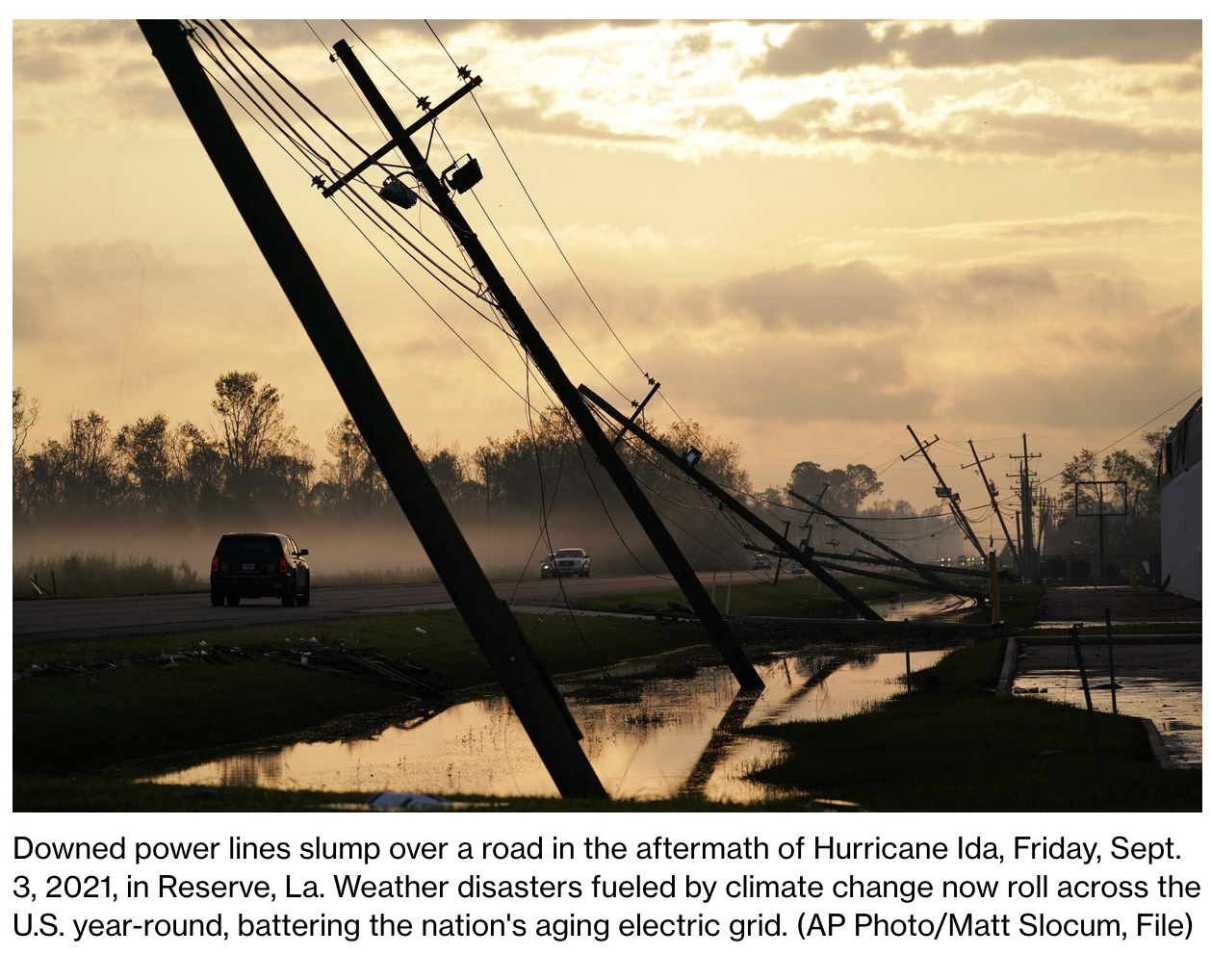
(AP) –– Power outages from severe weather across the U.S. have doubled over the past two decades, as a warming climate stirs more destructive storms that cripple broad segments of the nation’s aging electrical grid, according to an Associated Press analysis of government data.
Forty states are experiencing longer outages — and they’re worst in areas where weather is getting more extreme, data shows. The blackouts can be harmful, even deadly, for the elderly, disabled and other vulnerable communities.
And power grid maintenance expenses are skyrocketing as utilities upgrade decades-old transmission lines and equipment. So customers hit with more frequent and longer weather outages also are paying more for electricity.
“The electric grid is our early warning, ” said University of California, Berkeley grid expert Alexandra von Meier. “Climate change is here.”
The AP Found:
— Outages tied to severe weather rose from about 50 annually nationwide in the early 2000s to more than 100 annually on average over the past five years.
—The frequency and length of power failures are at their highest levels since reliability tracking began in 2013 — with U.S. customers on average experiencing more than eight hours of outages in 2020.
—Maine, Louisiana and California each experienced at least a 50% increase in outage duration.
—In California alone, power loses have affected tens of thousands of people who rely on electricity for medical needs.
The AP analyzed electricity disturbance data submitted by utilities to the U.S. Department of Energy to identify weather-related outages, including how long they lasted and how often they occurred.
Driving the increasing blackouts are winter storms called nor’easters that barrel into New England and shred decrepit electrical networks. Summers bring hurricanes that pound the Gulf Coast and Eastern Seaboard, plunging communities into the dark sometimes for months.
And in fall, West Coast windstorms trigger forced power shutoffs to protect against deadly wildfires.
Maine
The grid’s fragility hit home for Lynn Mason Courtney, 78, a blind cancer survivor in Bethel, Maine. When her retirement community building lost power and heat for three days following a 2020 winter storm, the temperature inside fell to 42 degrees (6 degrees Celsius). She developed hypothermia.
“Two people on oxygen had nowhere to go. They just stayed in the apartment and hoped like hell that the power would come back on,” Courtney said. “If you’re disabled, it’s scary. You’re not safe.”
Maine suffered record numbers of weather-related interruptions in recent years. Storms left more than 500,000 customers without power in winter 2017 — more than a third of the state’s population.
As the planet warms, extreme weather that threatens power reliability will likely hit some areas harder, said Penn State University meteorologist Colin Zarzycki.
A warmer atmosphere holds more moisture, increasing energy packed by storms. The phenomenon produces more destructive tropical hurricanes in the Southeast and storms that cause flooding on the West Coast.
“Those really high-end nor’easters, the ones that take over CNN for days, those are going to occur with the same or increased frequency,” Zarzycki said.
Louisiana
After Hurricane Ida knocked out power in coastal Louisiana last year, heat killed or contributed to deaths of at least 21 people, local coroners reported.
David Sneed, 65, died in the 12th-floor apartment where he’d been without power for several days after the storm hit Aug. 29.
Sneed was obese and had a cognitive impairment, so he usually used a wheelchair, said Rev. Ken Taylor at New Orleans Baptist Theological Seminary, where Sneed was a doctoral student.
Taylor checked on Sneed after the storm and said his apartment felt like 100 degrees (38 degrees Celsius). Six days after the storm, the power was back but when Taylor visited he got no answer.
Sneed’s body was found in his apartment, slumped in his wheelchair. He died from the heat, the coroner ruled.
“I speculate that he had rolled into his bedroom to put on some pants to go downstairs,” Taylor said.
The financial toll is steep. Louisiana regulators approved $3.2 billion in charges from hurricane damages in 2020 and 2021, which utility Entergy Corp. estimates will cost the average residential customer almost $100 annually for 15 years.
Most U.S. power transmission facilities are at least 25 years old. Utilities have quadrupled spending on them since 2000 to about $40 billion annually, according to Department of Energy data.
Billions more are set to be spent, with costs borne by consumers. Yet the effort won’t keep up with climate change, said U.C. Berkeley’s von Meier.
“Rates will go up, reliability will go down,” she said.
California
Almost 200 California wildfires over the past decade were traced to downed power lines. Among them, a 2018 fire that ripped through the Sierra Nevada foothills town of Paradise and killed 85 people, resulting in criminal convictions of Pacific Gas and Electric Co., the nation’s largest utility.
Now when windstorms and dry conditions are forecast, utilities cut power preventively. That’s potentially life-threatening for people with medical equipment that requires electricity.
An AP review of California utility filings found almost 160,000 power shutoffs to customers with medical needs since 2017.
Utilities have sought to lessen the impacts by distributing portable batteries and setting up centers where people can charge essential devices.
PG&E Vice President Sumeet Singh said shutoffs are a last resort and have been reduced in size in part through better forecasting of hazardous weather. “We know there has been a trade-off between safety and reliability,” Singh said.
By year’s end, PG&E expects to have spent almost $15 billion since 2020 on wildfire prevention. It’s cutting back vegetation near equipment and plans to bury 10,000 miles (16,000 kilometers) of lines over 10 years so they won’t be exposed to falling trees.
For now the shutoffs are set to continue.
Richard Skaff, a paraplegic and advocate for the disabled in Northern California, said he endured two forced outages each lasting five days. He had a generator to keep his electric wheelchair powered and house heated, but said others with disabilities live on minimal incomes and struggle during outages.
“If we’re going to allow PG&E and others to de-energize the grid…you have to determine the effects on the most vulnerable people,” Skaff said.
Updated: 6-5-2022
China’s Renewable Energy Fleet Is Growing Too Fast For Its Grid
(Bloomberg) — China is wasting more and more clean energy as it adds wind turbines and solar panels faster than its grid is able to digest them.
Nearly 12% of power generated by wind turbines in Inner Mongolia this year has been wasted because the grid couldn’t take it, along with 10% of solar power in Qinghai, Economic Information Daily reported, citing government data.
In sunny and windswept but sparsely populated Gansu province, the utilization rate of wind and solar power could drop below 90% this year from nearly 97% in 2021.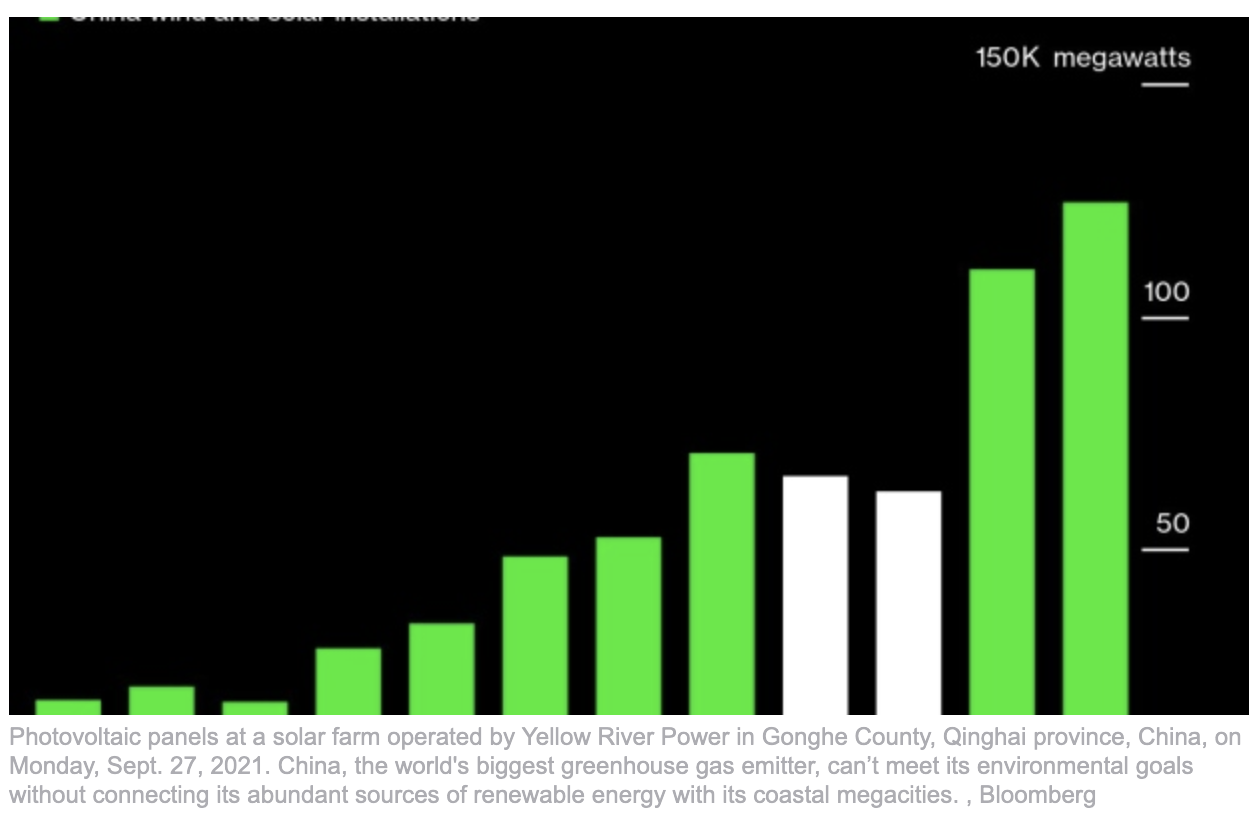
While China’s slowing economy and energy use amid Covid-19 lockdowns has something to do with it, the main culprit is the blistering pace of renewable energy installations. China set a record for wind capacity additions in 2020 and for solar in 2021, and is set to double that mark this year.
But unlike with mounds of coal, you can’t just save breezes and sunshine for when you need them, so all the extra capacity is generating more power than the grid can use and has to be cut off to avoid overloading it.
That’s bad for utilities who aren’t getting paid for that power, and bad for the environment as the wasted clean energy could have reduced emissions from burning coal.
China was plagued by high curtailment rates last decade and in late 2017 introduced a quota system to force regions to slow new projects until all their power was being used. That resulted in solar and wind additions dropping in 2018 and 2019, reversing a half decade of increasing gains.
The good news is that China has developed more tools for dealing with its overabundance of wind and solar power — namely building long-distance power lines to ship it to places where it can be used, and developing energy storage systems that can absorb the power and redistribute it later when it’s needed.
Investments in both technologies will likely increase after China’s two main utilities recently promised to boost capital spending to help stimulate the economy.
Scaling up those solutions will be of utmost importance. Because with the world already well behind the eight-ball in its fight against climate change, another slowdown in clean energy adoption in the world’s biggest emitter would be a disaster.
Updated: 8-30-2022
Negative Power Prices? Blame The US Grid For Stranding Renewable Energy
Bottlenecks are preventing cheap wind and solar energy from reaching high-demand areas.
As energy costs soar around the world, a curious thing is happening with increasing frequency in power grids in certain corners of the US: Prices are plunging below zero.
So much wind and solar have been added that power is getting stuck where it’s generated because there aren’t enough high-voltage lines to move it to where demand is highest.
That’s forcing power plant owners to pay users to take the excess electricity.
Wholesale prices went negative about 200 million times across the seven US grids in 2021, more than twice as often as five years earlier, according to Yes Energy, a data and analytics provider.
(All seven US grids price electricity at five-minute intervals across 41,000 nodes that are the equivalent of on-ramps and exits on a highway). That record will be broken this year as bottlenecks worsen on three renewable-rich grids in Texas, California, and the Southwest, the data show.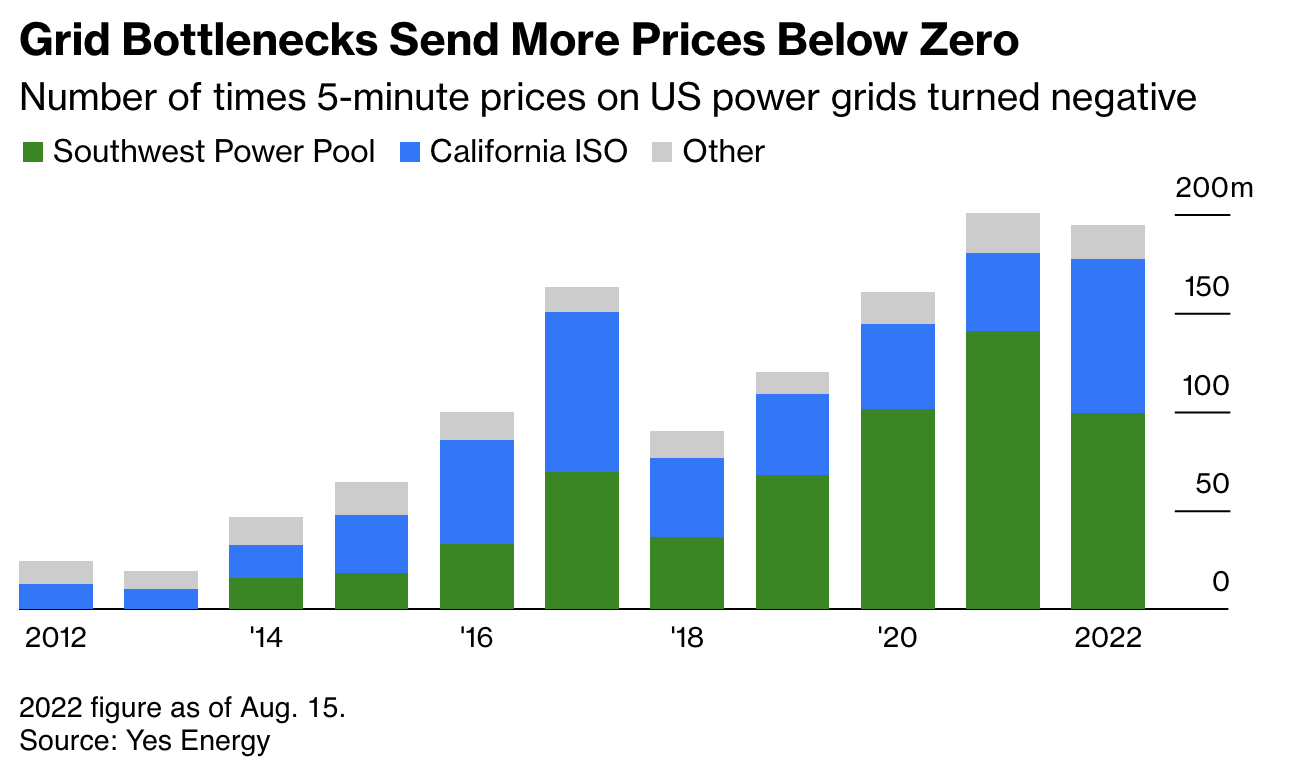
Prices aren’t falling below zero often enough to meaningfully dent wholesale power costs. But the phenomenon is a warning sign that grids aren’t anywhere near ready for a broad shift to renewable power.
The US needs to spend $360 billion through 2030 and $2.4 trillion by 2050 to expand transmission systems enough to handle the expected onslaught of renewables, according to a Princeton study.
Otherwise, power will keep getting stuck where no one needs it. “We don’t have the right big transmission infrastructure,” says Cliff Rose, product manager at Yes Energy, who performed the analysis for Bloomberg News.
The more than $400 billion allocated for clean energy infrastructure and climate initiatives in last year’s infrastructure bill and this month’s Inflation Reduction Act are significant, but many efforts are being pursued in isolation from one another and fall short of the economywide transformation that’s needed, says Jeremy Rifkin, an economist who’s advised Democrats and Republicans on power infrastructure.
In Rifkin’s view, Congress squandered an opportunity to galvanize the nation with a grand vision like President Dwight Eisenhower did in the 1950s with his plan to create a system of interstate highways.
The success of clean energy will require sharing solar and wind across the continent from both large-scale plants and millions of homes producing their own power.
“The narrative got lost,” he says. “It’s not about putting in solar and wind, it’s about ‘How do you transform this country?’”
Negative prices aren’t new, but they’ve been on the rise as construction of wind and solar has picked up speed. This year prices fell below zero for 6.8% of the time, as of Aug. 15, up from 4.6% last year, Yes Energy data show.
The incidence of negative prices would be even greater if grid operators didn’t order renewable plants to shut down during periods of excess supply to help keep grids stable.
Those subzero prices in areas where there’s too much supply are being countered by surging costs in areas where there are grid bottlenecks.
Both situations give rise to congestion charges—the equivalent of Uber surge pricing—that totaled a record $99.7 billion as of Aug. 26, higher than the total for all of 2021 and roughly double the level seen in each of the four years prior to that, Yes Energy data show.
Homes and businesses ultimately pay for those inefficiencies on their utility bills.
Renewables became the driver of negative prices in the past decade, in California and Texas especially, with the help of state and federal tax credits.
California’s grid formed an alliance with utilities beyond its borders to create a real-time market to more easily move power from renewable sources across the West.
Texas squashed an early surge of negative prices by preemptively building a massive transmission corridor that would transport wind power from the western part of the state to cities to the east, like Houston and Dallas.
The epicenter of negative prices is the Southwest Power Pool grid, which serves almost 19 million people from New Mexico to Montana. Wholesale prices there were negative about 17% of the time during the first seven months of this year, compared with more than 7% of the time on the main Texas grid and in California, according to Yes Energy.
Wind is already the No. 1 electricity source in the Southwest Power Pool. Turbines were spinning so much this spring that nearly 25% of all real-time prices were negative in the second quarter and more wind generation than ever had to be curtailed to keep the grid stable, according to a report from SPP’s market-monitoring unit.
In Texas, which is seeing the fastest growth in new wind and solar projects in the country, other plants, such as those running on coal, natural gas, or nuclear fuel, “could be dispatching at zero or even negative prices” at times, Jim Burke, chief executive officer of Vistra Corp., the largest US independent power generator, said on an Aug. 5 analyst call.
Prices on the Texas grid fell as low as -$8,977.46 a megawatt-hour on May 7 at 10:55 a.m. Central time for CPS Energy’s J.K. Spruce coal-fired power plant, according to Electric Reliability Council of Texas data compiled by Bloomberg.
(A megawatt is enough to supply 200 Texas homes for an hour.) Fossil fuel plants may keep running through these transitory price drops because it’s cheaper to stay online and avoid costs for restarting the plant later.
Negative prices are becoming more frequent in the Eastern US for different reasons. An unusually pleasant spring day in Boston one May weekend while the rest of New England sweltered sent prices across the six-state grid to -$150 per megawatt-hour for several hours.
Prices have been frequently dipping below zero in parts of Delaware and Maryland, because work on transmission lines there has stranded power that usually flows to Washington and Baltimore.
This all should be a wake-up call to policymakers. “Building out transmission should be one of the biggest national priorities that we have to eliminate or minimize those bottlenecks and to allow for more economic transfer of that electricity to places that can use it,” says Mona Tierney-Lloyd, head of USA state policy at Enel North America, a leading developer of renewable projects. —With Dave Merrill
Updated: 9-7-2022
Bitcoin Miners Can Strengthen Electricity Grids
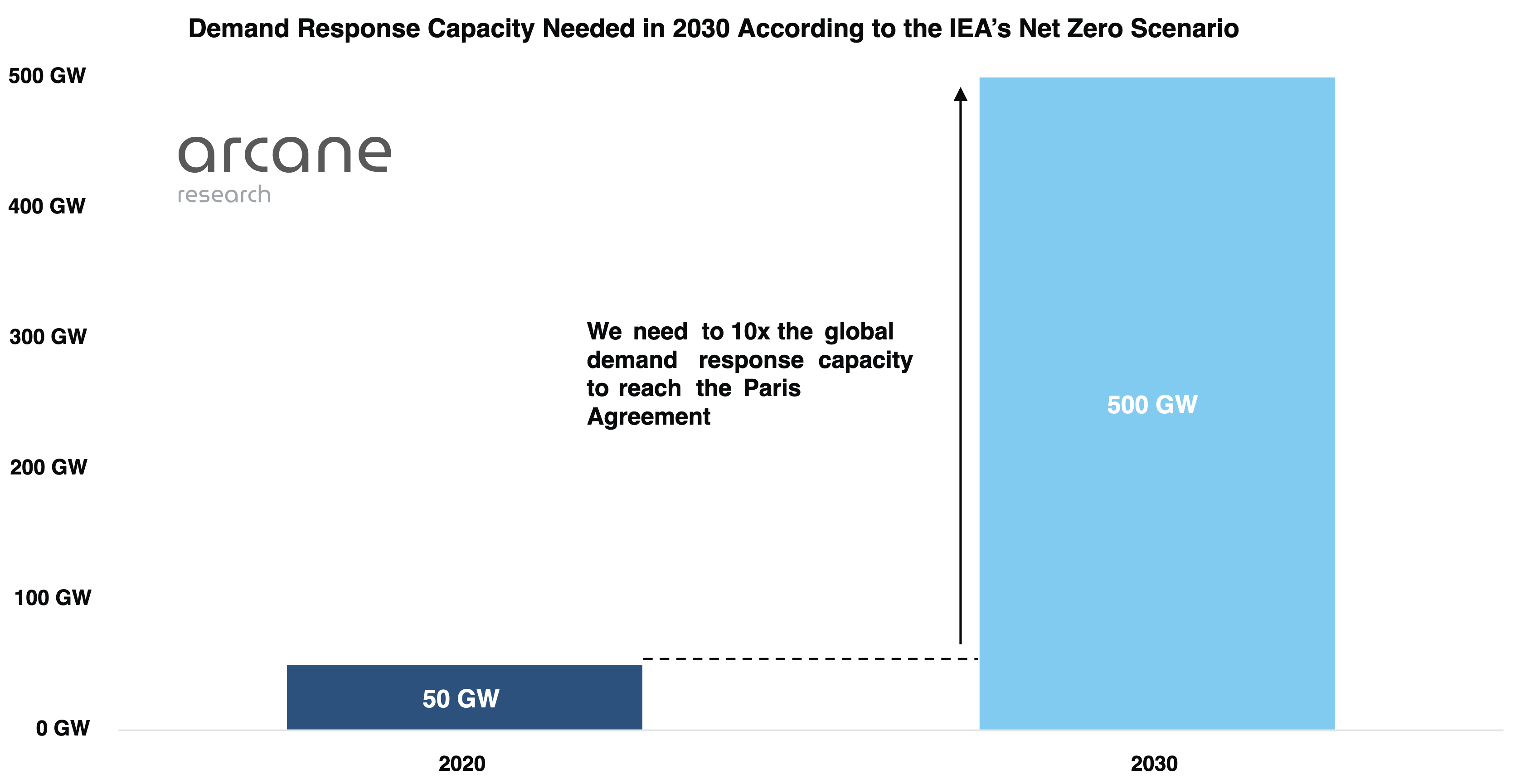
To safely integrate more wind and solar into electricity systems, the electricity demand must become more flexible. This article explains how the unique flexibility of bitcoin mining allows it to help strengthen electricity grids.
This article is an excerpt from our research report titled “How Bitcoin Mining Can Transform the Energy Industry” .
The research report lays out five characteristics of bitcoin miners, which make them uniquely flexible energy consumers, and explains four energy problems bitcoin miners can help solve. This article explains one of these problems: How bitcoin mining can strengthen electric grids. Let’s get into it.
Electricity Grids Are Becoming More Fragile
The demand must always match the supply in electricity systems since even a slight imbalance can affect the system’s reliability. In addition to altering the electricity supply or demand, energy storage and transmission lines can provide system flexibility.
Historically, we have relied mainly on the supply side to adjust power generation to the expected demand.The different energy sources for electricity vary significantly in their controllability.
Natural gas and hydropower are the most controllable energy sources since the energy producer can easily adjust their production up or down. Coal and nuclear are also controllable but to a lesser extent.
They are very reliable, but granularly changing their production is inefficient. Coal and nuclear plants traditionally provided the baseload, letting natural gas or hydro plants fine-tune production to accommodate demand swings.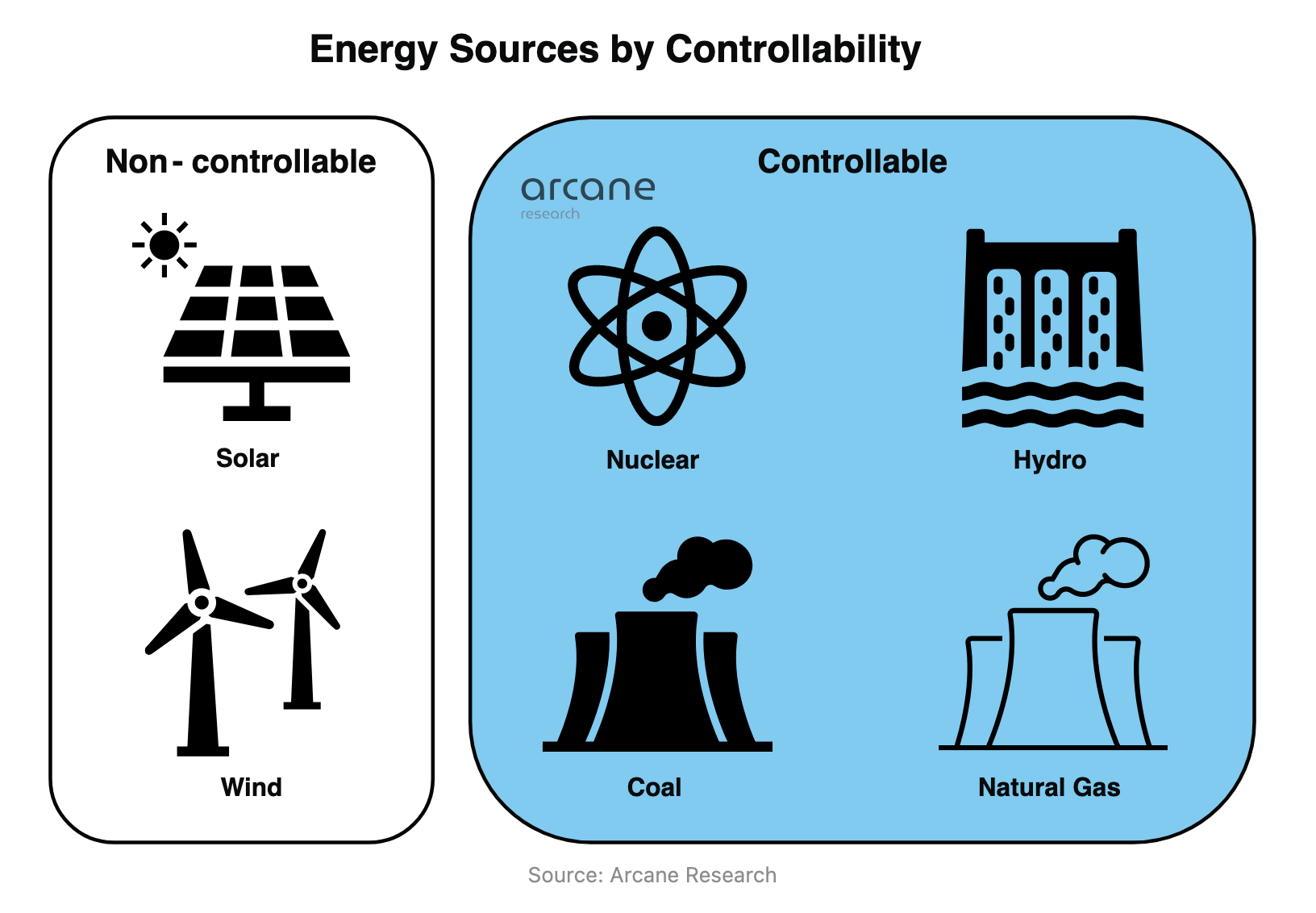
One of today’s biggest energy challenges is that the supply side’s ability to provide system flexibility is decreasing. We are in the middle of an energy transition, replacing fossil fuels with renewable energy sources like wind and solar.
These are non-controllable energy sources since their ability to generate electricity depends on weather conditions.
Non-controllable energy sources can not be relied upon for system flexibility. The International Energy Agency (IEA) operates with several scenarios for the energy transition.
The Sustainable Development Scenario represents a gateway to the outcomes of the Paris Agreement, entailing massive growth in non-controllable energy sources as a share of the generation mix from 11% to 42% in 2040.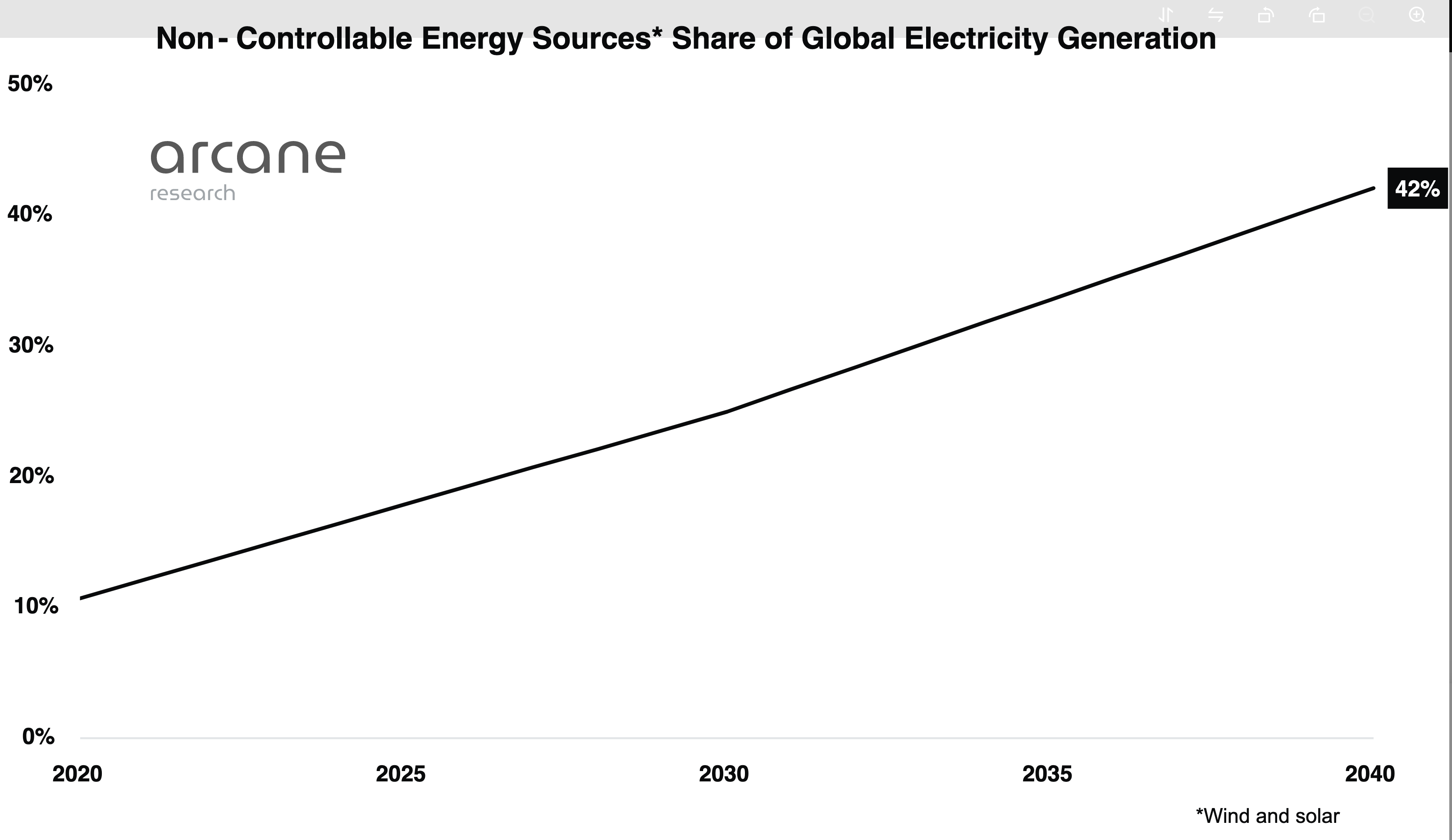
This scenario assumes a massive replacement of controllable with non-controllable energy sources. How do we replace this lost system flexibility? Our options are increasing the demand side flexibility, energy storage capacity, or transmission lines’ capacity.
We will need a combination of these options, but taking advantage of the demand side’s flexibility stands out since it’s cheaper and more scalable than the other alternatives.
Flexible Electricity Consumers Can Provide Demand Response
Demand response is a change in consumption by electricity consumers to match the electricity demand to the supply. The process typically involves payment or other financial incentives to consumers for agreeing to reduce their electricity use when supply is low.Demand response exists in most developed electricity systems globally.
ERCOT, the electricity system in Texas, is at the forefront of demand response, and bitcoin miners have become one of their most trusted sources for system stability.The electricity system in Texas is called ERCOT, which is also the system operator’s name.
ERCOT faces a unique combination of challenges, incentivizing them to look for innovative ways to keep the electricity system reliable.
The ERCOT electricity system is islanded, with almost no connections to other electricity grids. Importing or exporting electricity through transmission lines to provide system flexibility is, therefore, not possible.ERCOT has a high share of wind and a rapidly growing share of solar power, as Texas has among the best wind and solar conditions on the planet.
The heavy reliance on wind and solar power means that the supply side is volatile, and they must increasingly rely on demand-side flexibility.
Not only is the Texas grid islanded and has a high and rapidly growing share of wind and solar, but the Texas weather can be extreme and unpredictable, leading to volatile demand. An example is the winter storm in February 2021, which led to skyrocketing demand and supply outages.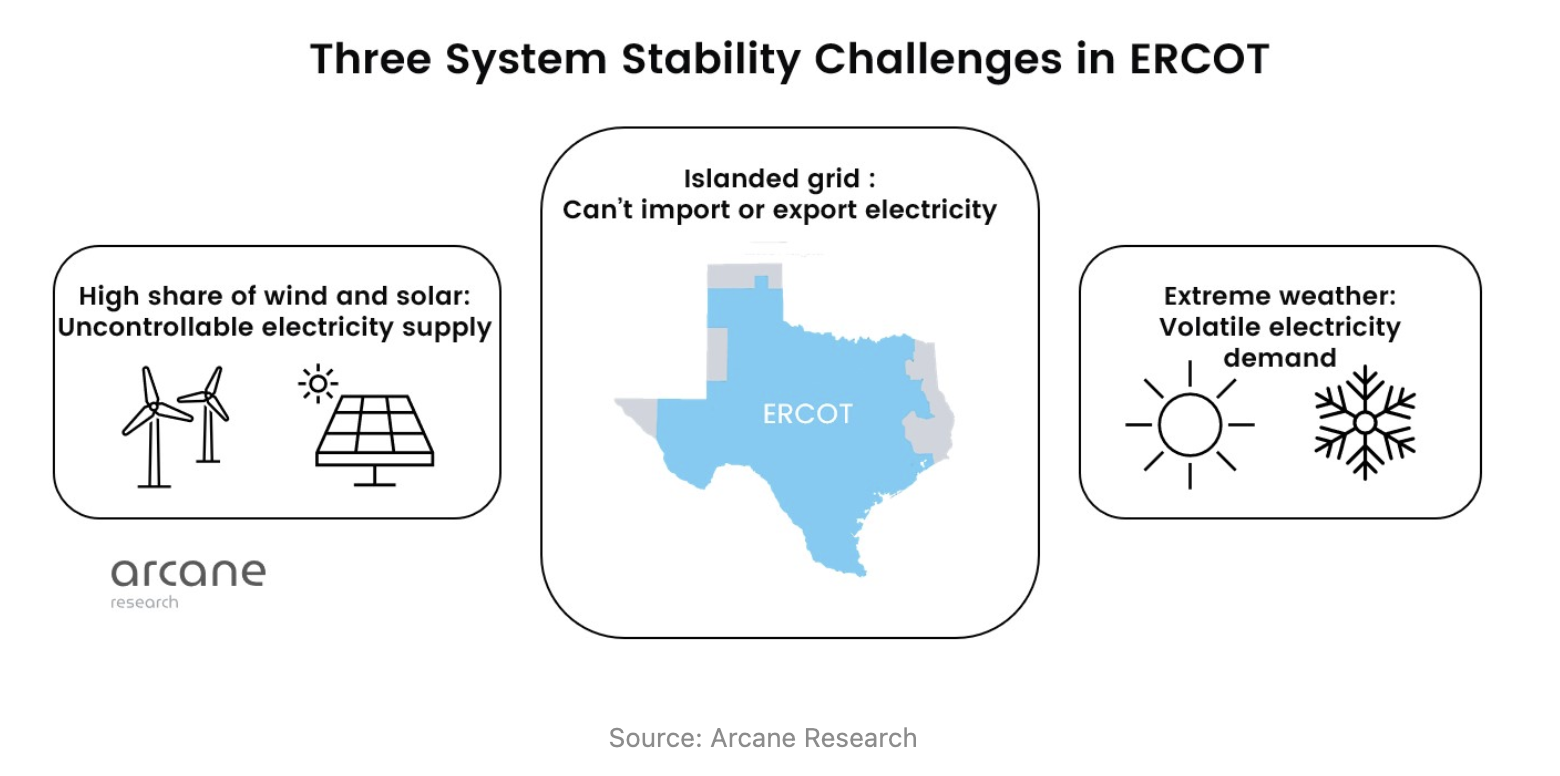
This combination of system stability challenges has incentivized ERCOT to develop one of the most advanced demand response markets globally.
ERCOT has two main categories of demand response depending on how fast the demand response resource must adjust its electricity consumption. The first category is called load resource, and the other is emergency response service.
The load resource designation allows eligible demand response resources to help stabilize the grid’s frequency. The frequency fluctuates around 60 Hz in North America, and keeping it as close as possible to this level is essential.
A high load relative to generation decreases the frequency, while the opposite increases it. The system operator continuously monitors the frequency and employs various tools to stabilize it.
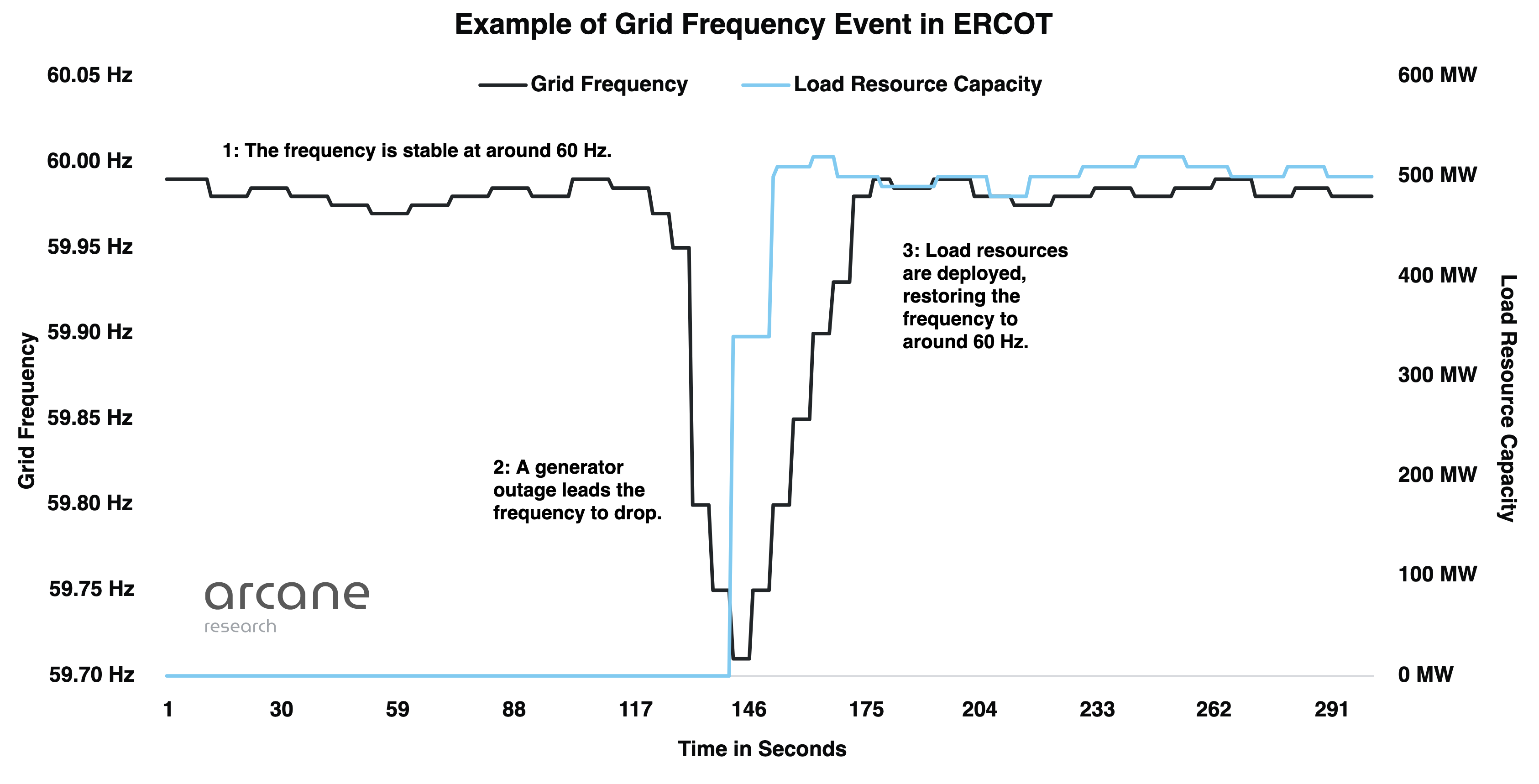
We can break the load resource designation into two types: Controllable Load Resource (CLR) and Non-Controllable Load Resource (NCLR). To earn these designations, loads must pass several tests regarding their controllability.
As the names suggest, the controllable load resource designation has higher entry requirements than the non-controllable load resource.
Controllable load resources are loads that can granularly adjust their load within seconds, allowing them to take active roles in balancing the grid’s frequency.
Non-controllable load resources also help stabilize the frequency, but only in a binary way by tripping the whole load offline if the frequency drops below a certain level.
The higher controllability of controllable load resources means that these demand response resources are much more efficient in stabilizing the grid than non-controllable load resources. So far, only crypto miners have earned the controllable load resource designation.
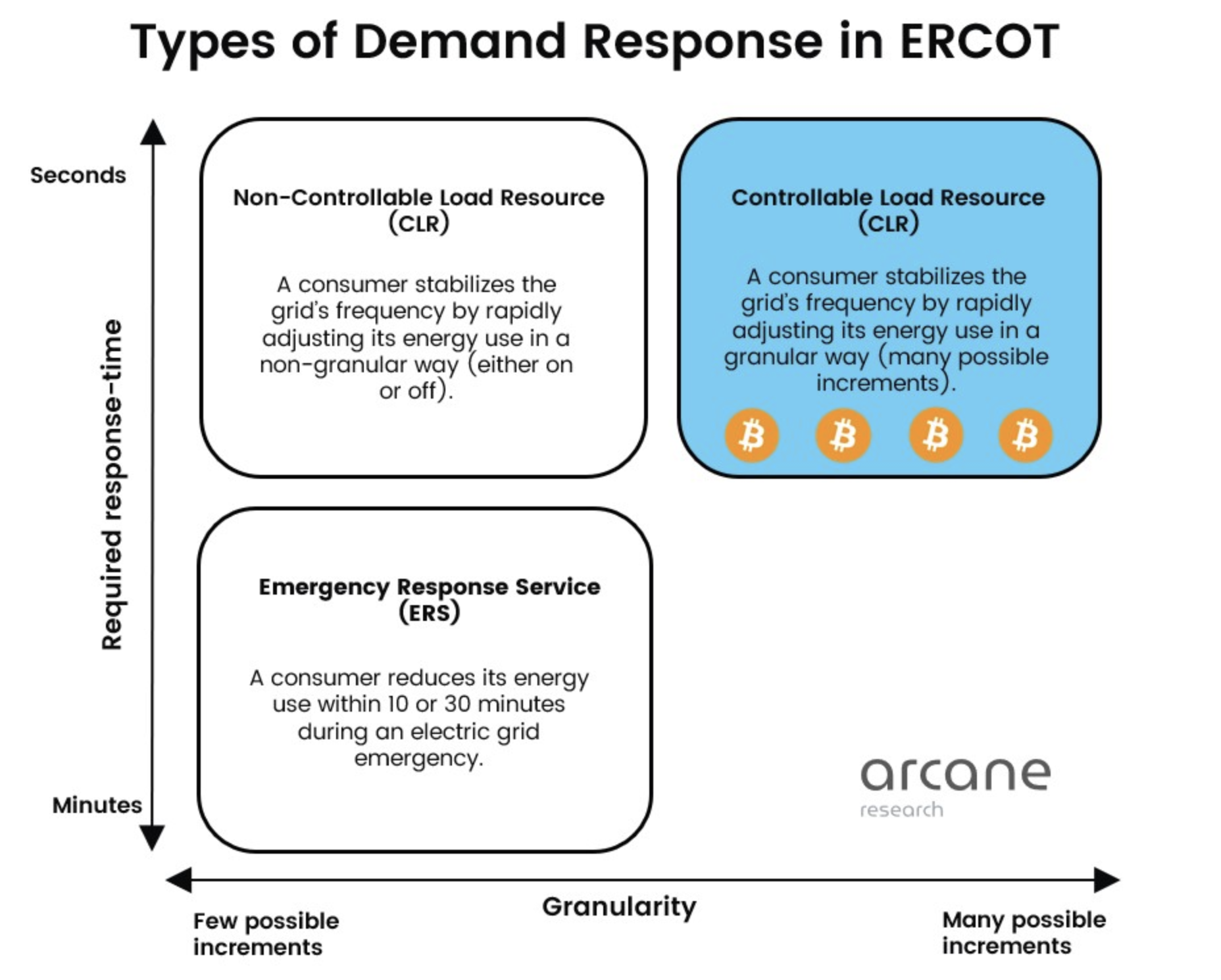
While load resources provide the first layer of protection for the grid by regulating their load to stabilize the frequency in seconds, one additional layer of protection is employed if the load resources are insufficient.
This final level of grid insurance is called Emergency Response Service (ERS) and consists of loads that can reduce their electricity usage within 10 or 30 minutes, depending on agreements.
Demand response generally works by electricity consumers selling their ability to shut down operations in various day-ahead markets for ancillary services.
They then reduce their electricity consumption per this agreement if the system operator orders them. We can view this arrangement as demand response resources selling insurance to the grid.Demand response can also be provided simply by reacting to price signals.
If the electricity price is high during specific periods, flexible consumers can restrain from buying during these times. By avoiding consumption during expensive hours, a consumer effectively acts as a demand response and alleviates pressure on the system.
Bitcoin Mining Is The Best Alternative For Demand Response
ERCOT created the controllable load designation in 2004. No electricity consumers fulfilled the requirements until 2020, when the demand response technology company Lancium and a bitcoin mining load passed the necessary tests. Lancium’s patented Smart Response® software allows bitcoin miners to act as controllable load resources.
Bitcoin miners designated as controllable load resources are allowed to participate in all of ERCOT’s ancillary services markets, where they sell their ability to regulate their power consumption following instructions from ERCOT.
They can also participate in real-time power markets, allowing them to include a clause in their power purchasing agreements to power down and “sell” power back to the grid for the real-time price of electricity.
According to ERCOT, there are currently eight crypto miners with a total capacity of 750 MW designated as controllable load resources, with an additional 2600 MW awaiting approval.
However, Rich Godwin, a Texas bitcoin miner, tracks the real-time participation of controllable load resources daily and has only seen about 130 MW. This difference might be due to not all controllable load resources participating in the market simultaneously.
Why have only crypto miners passed ERCOT’s controllable load resource requirements? It all comes down to bitcoin mining’s uniqueness as an interruptible load, which we explained in this article.
We will now build on that analysis by dissecting four factors that make a load interruptible, comparing bitcoin mining’s score on these factors with that of two other energy-intensive consumers: A conventional data center and a steel plant.
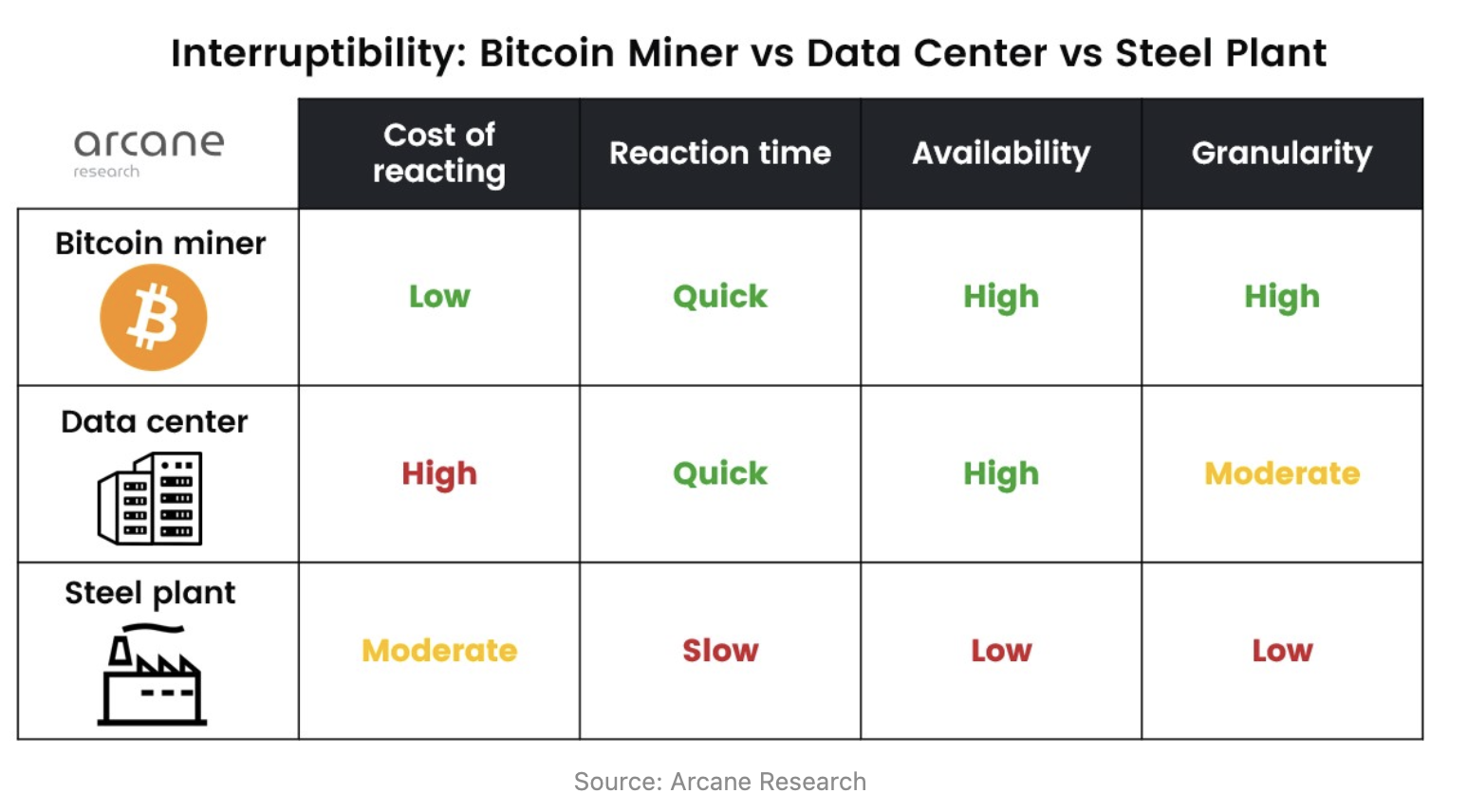
Cost Of Reacting: The cost of reacting refers to a demand response resource’s costs of powering down its operations. This number is very high for a conventional data center since it serves clients that depend on available data, making it unsuitable for providing demand response.
For bitcoin miners, the only cost of reacting is the alternative cost of not producing bitcoin, giving them high economic incentives to provide demand response.
Suppose the price per MWh exceeds what the miner could have earned by dedicating this MWh to mining bitcoin. In that case, the miner should stop mining since it will gain more by turning off its machines than by mining bitcoin.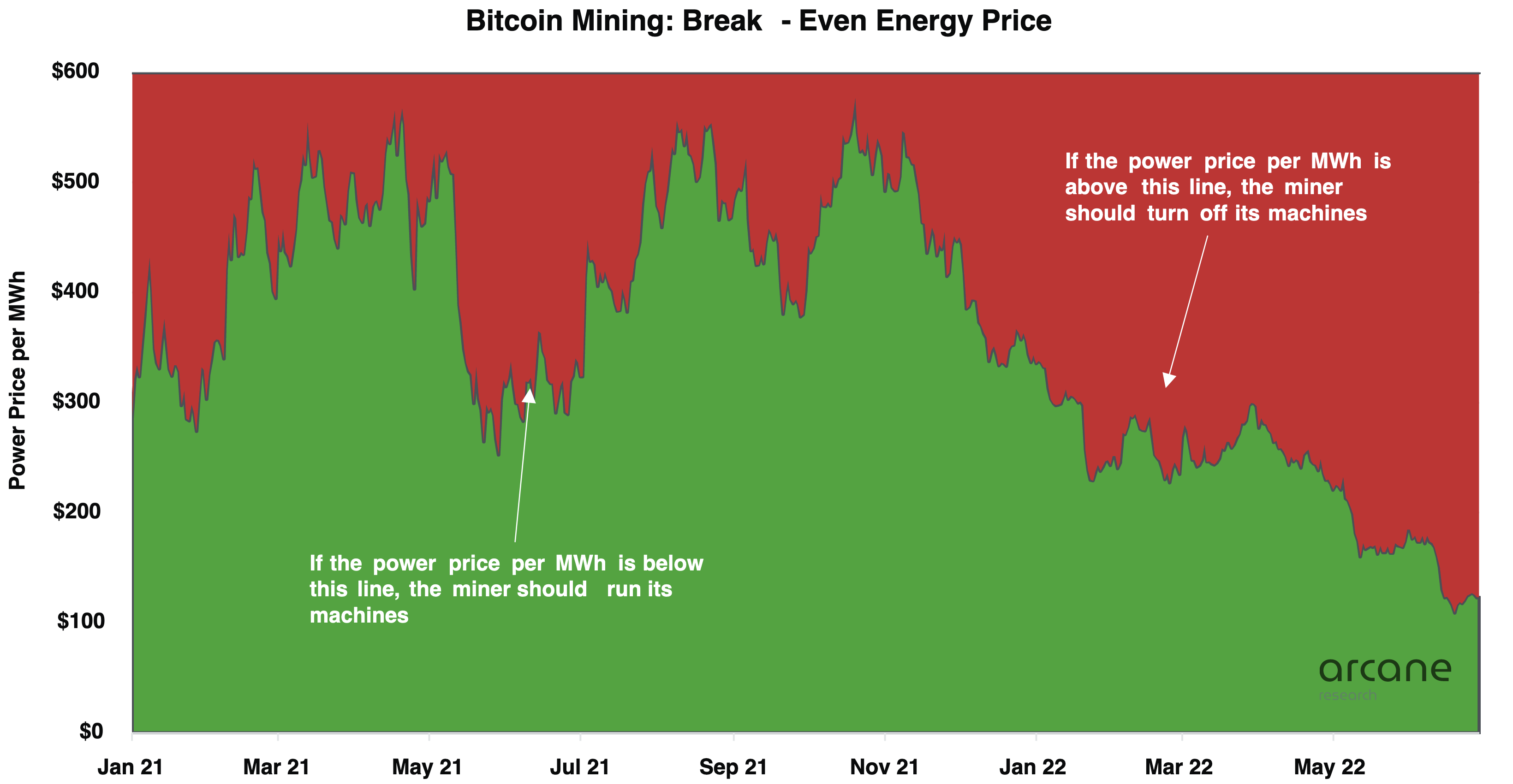
The chart above shows that in 2022, the alternative cost of not dedicating a MWh to bitcoin mining has fluctuated between $150 to $300.
In times of grid stress, when demand response is needed, the real-time power price can reach thousands of dollars per MWh, substantially higher than this alternative cost, meaning that economically rational bitcoin miners will turn off their machines.
Reaction timeThe second factor, reaction time, is how fast the demand response resource can power down its operations. A steel plant has a slow reaction time since it takes a lot of coordination to power down a factory with many different processes and employees.
On the other hand, a bitcoin mining facility only does one function, solving the SHA-256 hashing algorithm.
This single process can rapidly be interrupted, allowing bitcoin miners to participate in demand response programs requiring the fastest reaction times.
AvailabilityBecause of the stability of a bitcoin miner’s load, a system operator can always rely on the bitcoin mining load to be available to provide demand response when needed. An example of an industrial load with low availability is a steel plant.
Steel production consists of many processes; only a few are energy-intensive enough to provide demand response. Since these processes demand different amounts of energy, a steel plant’s load will fluctuate daily and weekly.
It can not always be relied on to provide demand response.GranularityGranularity refers to how many increments the demand response resource can adjust its load.
A bitcoin miner can adjust its load in almost infinite increments and is therefore highly flexible in the amounts of electricity it can sell to the grid. The high granularity of a bitcoin miner stays in stark contrast to a steel plant, which either runs its electric arc furnace or not.
Scoring high on reaction cost, reaction time, availability, and granularity makes bitcoin mining a highly interruptible load, which is why it is the only controllable load resource in ERCOT.
Examples Of Bitcoin Miners Stabilizing The Grid
The point of demand response is to protect the grid during high-stress events when there is not sufficient generation compared to the load. Then it makes the most sense to look at what bitcoin miners did during the most high-stress event on the Texas grid in history: the winter storm Uri in 2021.From February 13th to 19th, a severe winter storm hit Texas.
ERCOT had not prepared for such a black swan event, and the winter storm led to widespread outages of generation and natural gas supply.
The combination of generation outages and skyrocketing electricity demand from homes needing heating caused a severe imbalance between supply and demand.
Real-time electricity prices soared to more than $9,000 per MWh.To reduce electricity demand and mitigate the impacts of the catastrophe, ERCOT deployed all its demand response resources, of which many were bitcoin miners.
These bitcoin miners voluntarily turned off their machines and sold their unused power back to the grid. Meanwhile, the state’s conventional data centers didn’t turn off.
The chart above compares West Texas’s average real-time power price for each day in February 2021 with the turn-off points for bitcoin mining and residential customers.
Residential customers are non-price responsive since they need the energy for essentials like heating, meaning that they will generally not stop consuming energy even when prices soar.
On the other hand, Bitcoin miners are very price responsive since they know precisely how much they earn per MWh.During the 7-day winter storm, the average ERCOT power price was $5,972 per MWh, far above the bitcoin mining revenue per MWh of $480. T
he economic incentives are clear: A bitcoin miner that didn’t turn off his machines during the winter storm would have spent nearly ten times more on electricity than this electricity would have earned him in revenue.
ERCOT also suffered a winter storm in 2022, which was not nearly as bad as the year before, but the system operator still had to deploy some of its demand response resources.
Riot Blockchain was among the miners that powered down its operations.20 Bitcoin miners have become ERCOT’s most trusted demand response resources, confirmed by the interim CEO of ERCOT, Brad Jones, saying in an interview with CNBC that “crypto miners help ERCOT keep renewable energy operational.
Bitcoin Mining Provides The Demand Flexibility Needed To Integrate Renewable Energy Safely
Demand response will be an integral tool to secure the reliability of electricity systems as we continue integrating variable renewable energy sources like wind and solar.
The IEA estimates that to reach the Paris Agreement, we must bring a total demand response capacity of 500 GW to market by 2030, corresponding to a 10x growth from 2020.
Bitcoin mining is an energy-intensive and stable load that can be rapidly adjusted up or down with extreme precision at no extra cost other than the alternative cost of not mining bitcoin.
The combination of these traits makes bitcoin mining a uniquely interruptible load and our best alternative for demand response, providing the demand flexibility needed to integrate variable renewable energy safely.
Updated: 7-17-2023
Can Solar Energy Save The Crumbling Electric Grid During Heat Waves?
As extreme temperatures strain electric grids in the U.S., many parts of the country could face blackouts. Solar energy can help protect the grid during extreme heat, but it comes with the added cost of increasing climate waste and decreasing efficiency. Photo illustration: Xingpei Shen
Updated: 7-31-2023
Extreme Heat And Aging Power Grids Are A Deadly Combination
As temperatures hovered over 110F (43C) for a fourth consecutive week in Phoenix, heat-related illness calls for emergency services spiked to more than double the level seen at this time last year.
The numbers illustrate just how fragile humans are in extreme heat. And this single indicator showing the limit of human endurance shot up at a time when power systems functioned well and no blackouts occurred.
Last year, Europe experienced over 60,000 heat-related deaths due to uncharacteristically hot weather, according to a recent analysis. The problem was, in part, a lack of cooling infrastructure. But it suggests the fatalities that might occur in the US after a prolonged grid failure.
In other words, things could be much worse.
Blackouts and heat are a deadly combination. Half the population of Phoenix would land in the emergency room if a multi-day blackout struck during a heat wave, and nearly 13,000 people would die, according to a study published in May in the journal Environmental Science and Technology.
Most people in the US tend not to worry about blackouts because they still tend to be fairly uncommon and brief. Even in Phoenix, with its record-breaking stretch of daily highs at or above 110F, the grid is holding.
But that’s not a sure thing going forward. Last week the largest US grid — serving 65 million customers from Washington, DC to Illinois — issued an emergency alert raising concern about its ability to maintain enough power reserves as people crank up their air conditioners.
Fragility is commonplace across US energy infrastructure. “The wires and poles are getting older, and the weather is getting more difficult, and the population’s getting bigger,” says Michael Webber, a professor of energy resources at the University of Texas at Austin.
Most big blackouts in the US are triggered by storms physically damaging the grid — ripping down power lines, snapping poles or flooding substations. But extreme temperatures, hot or cold, can turn out the lights, too.
Winter Storm Uri in February 2021 froze gas pipelines across Texas and knocked out power plants whose owners had ignored prior warnings to weatherize their gear.
Roughly 4.5 million homes and businesses went dark in sub-freezing temperatures, many of them without electricity for days. More than 200 people died.
Federal data shows that in recent years, as increasingly extreme weather driven by climate change collides with an aging grid, blackouts have been happening more often and lasting longer.
A decade ago, the average US home experienced a sustained outage 1.2 times per year, lasting three hours on average, according to the US Energy Information Administration.
In 2021 — the most recent year for which data is available — the average number of blackouts per customer had risen to 1.4, with the power out for more than 5 hours.
Emergency managers are acutely aware of the threat. “Electricity is really the cornerstone of disaster recovery,” said Bryan Koon, vice president of homeland security and emergency management at IEM, a disaster management consulting firm.
“When you don’t have it, everything is hard. When you have it, everything becomes a little bit easier.”
That said, it’s not the government’s job to restore power, it’s utilities’. While they do their work, most of us rely on backups that kick in in stages.
Immediately after an outage, the first and foremost line of protection is privately owned small generators. Many hospitals and nursing homes are required to have their own.
This is in part because of Hurricane Irma in 2017, which knocked out power to more than 6 million Floridians. A dozen people died in a Hollywood, Florida, nursing home due to lack of air conditioning.
There are a lot of generators out there, but still not nearly enough to keep an entire city cool in the midst of the kind of heat waves that are fast becoming the new normal.
And most generators still burn fossil fuels, which not only contribute to global warming that is making the heat worse in the long run, but may be hard to acquire in an emergency situation.
Most localities also have some backup generators, or contracts for private generators and fuel suppliers to come to their aid if necessary.
However, getting this system into place can take hours or days. And once it’s deployed, officials have to make decisions on which critical infrastructure to prioritize.
Power at this point is very limited and competition for it is steep. Cooling centers for the general populace have to fight it out with water and sewage plants and law enforcement.
The next biggest challenge, says Ron Coleman, a spokesman for the emergency management office of Maricopa County, Arizona, is reaching unhoused and low-income residents, who may not have the resources to help themselves.
County data from 2022 shows that the biggest culprit in that year’s indoor heat deaths wasn’t a lack of air conditioning, but AC units that were broken.
This month emergency rooms in Arizona have seen an influx of patients with burns from falling on scorching asphalt. Many were elderly or unhoused or were working outside and overcome by the heat. Hospitals in Phoenix are also treating some people with heat illness by immersing them in body bags filled with ice to lower their body temperature.
Maricopa County experienced some of the highest temperatures in the nation in July, joined by Arizona’s Yuma, La Paz and Pima counties, Eddy County in next-door New Mexico and most of southern Texas along the border with Mexico.
And Maricopa is one of the fastest-growing places in the US — meaning that, worryingly, more Americans are moving into harm’s way.
If an urban area’s power outage were to extend over a long period of time, more resources could be brought to bear. Both state and federal emergency management services could be called in and would have enough generators at their disposal that they could power a stadium-sized cooling center.
And though it would take far longer, the US Army Corps of Engineers could be tasked with building a backup emergency power system.
After Hurricane Maria knocked out power to 1.5 million people in Puerto Rico, the Corps assisted local authorities with rebuilding the grid, supplied generators and even erected microgrids in remote parts of the island. But the power was still out for months.
In theory, in Maricopa, healthy people with resources have the ability to flee if the situation is life-threatening. “Flagstaff is only two hours away,” Coleman says, referring to the city which has a higher elevation and therefore is usually cooler than greater Phoenix.
It’s likely that many would do just that, but fleeing requires forethought. Many home garage openers and pumps at gas stations are powered with electricity. And how Flagstaff or other Western cities would manage hundreds of thousands of refugees from Phoenix is anyone’s guess.
As heat danger spreads, there are fewer safe harbors to run to. Where heat mortality is worse does correlate with high temperatures — but not precisely. Multiple other variables are likely at play, including demographics and built environment factors such as the extent of tree cover in neighborhoods.
While the American emergency response system is robust, it still might not be adequate to the task. “We are not anywhere prepared enough,” says Samantha Montano, an assistant professor of emergency management at Massachusetts Maritime University.
“On an individual level, if you lose electricity, there is not a lot you can do to mitigate the problem.”
Whether it is fire or hurricanes or flooding or heat that poses danger, emergency management professionals advise that it is always better to make your own preparations. Have adequate insurance, water on hand, gas to fill the tank and a personal plan for staying cool if all else fails.
Updated: 9-28-2023
U.S. Races To Fortify Power Grid Against Extreme Weather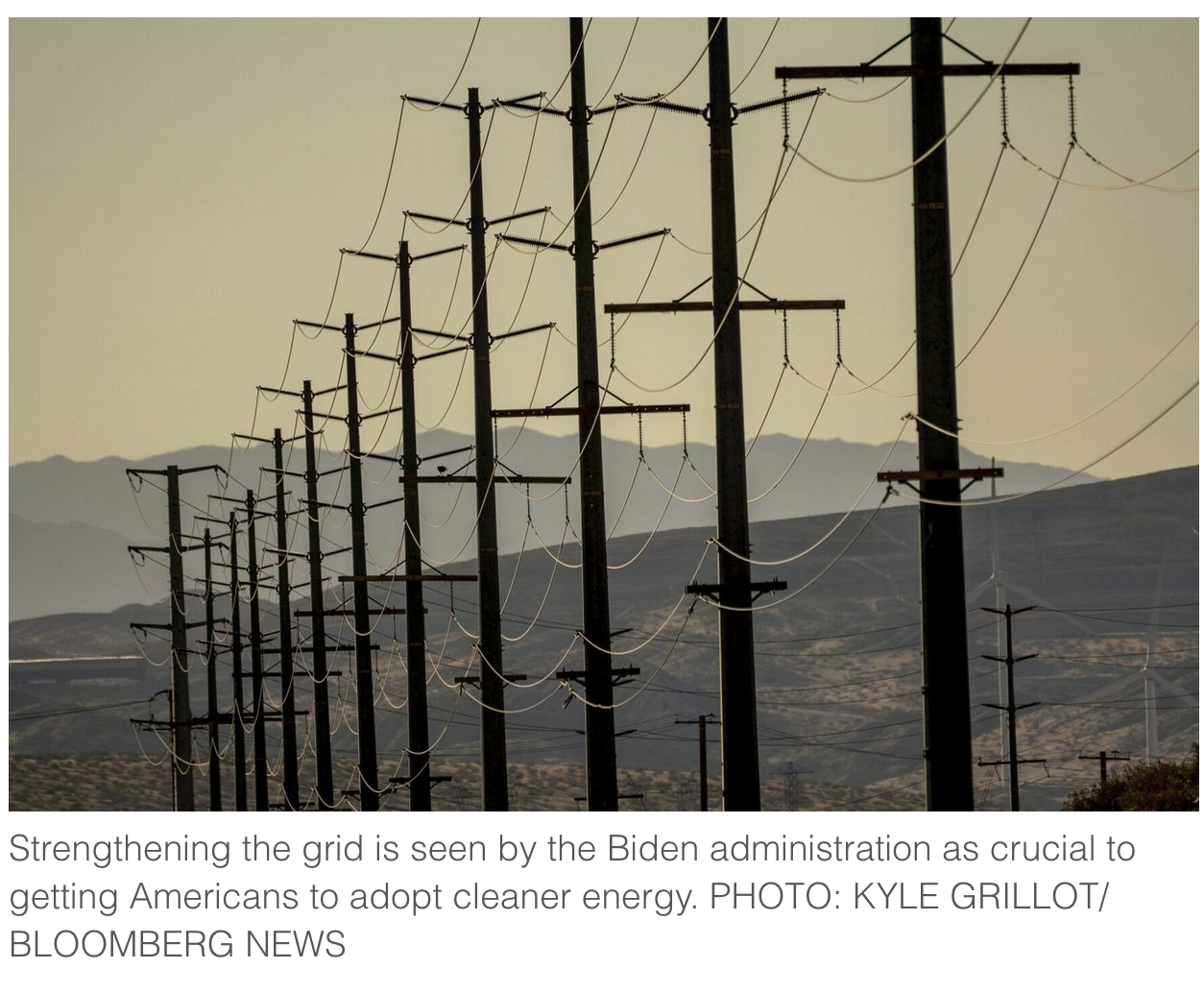
Energy Department has announced more than $1 billion in grants this year.
WASHINGTON—A gusher of cash is starting to pour out of Washington to carry out the Biden administration’s plan to strengthen the U.S. power grid and make it more resilient to outages and extreme weather.
The Energy Department on Thursday announced a new round of grants to tribes, territories and 11 states including Arizona, Florida and West Virginia as part of a $2.3 billion program designed to advance a key piece of the White House’s clean-energy drive.
It is a fraction of the amount the government plans to spend on the grid in coming years.
The administration sees strengthening the grid as crucial to getting Americans to adopt greener alternatives such as electric vehicles that rely on the network, especially as harsher weather conditions from global warming make utilities more vulnerable.
Increasing capacity also would help transmit the growing amount of wind and solar energy the government is encouraging as part of a shift away from coal and natural gas.
John Podesta, White House clean-energy adviser, said this week that the country needed to accelerate work to reach the administration’s goal of 100% clean electricity by 2035.
“We need to deploy transmission lines at twice the current pace than we’ve experienced in the last couple years,” he said at an Energy Department conference in Washington, D.C.
Already this year, the department has announced more than $1 billion in funding for power-grid projects.
The amount includes the roughly $170 million in grants unveiled Thursday, which is part of a program to make the grid more resilient to extreme weather and natural disasters.
The $2.3 billion plan was included in the 2021 infrastructure law; so far nearly $750 million in grants from the program has been announced. The funds will help support projects including infrastructure upgrades.
Another $300 million in grants was announced in August for states, tribes and local governments to help advance projects to build and upgrade transmission lines as part of the Inflation Reduction Act.
Both programs are overseen by the Energy Department’s Grid Deployment Office, which was started about a year ago and manages about $25 billion from the infrastructure legislation and the Inflation Reduction Act, according to department officials.
Researchers have found that if the U.S. continues to expand transmission at the average 1% a year pace of recent years, much of the potential emission reductions from the climate provisions of the Inflation Reduction Act would be lost.
That is because coal and natural gas would need to provide the added power for the growing number of EVs and other electric devices spurred by the legislation.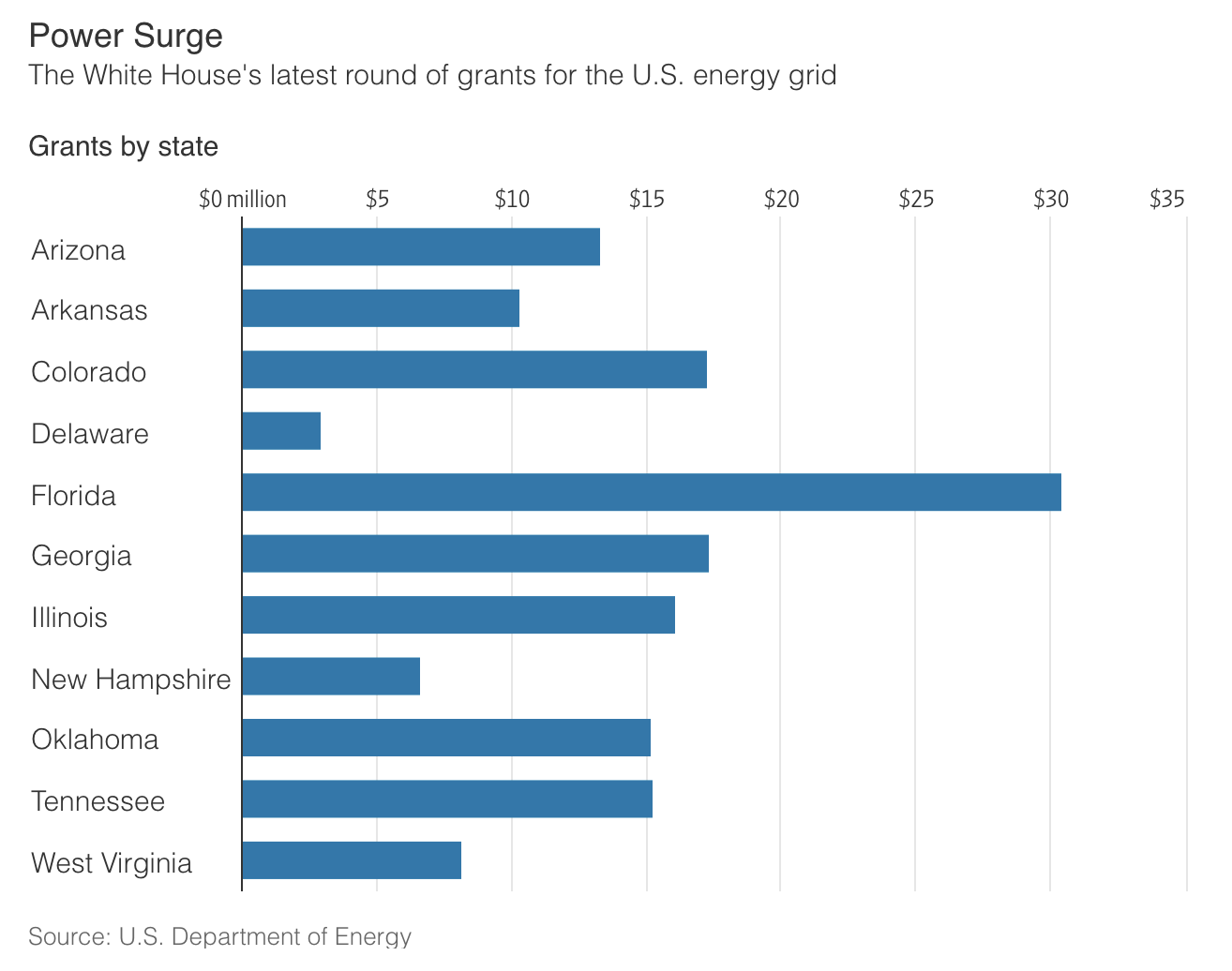
Clean-energy advocates have made expanding transmission capacity a priority, especially for long-distance power lines that can move renewable energy state to state.
Nationwide, renewables now produce 21% of electricity, while coal produces 20% and natural gas produces 39%, according to the Energy Information Administration.
Some members of Congress are pushing to expand transmission capacity. Earlier this month Sen. John Hickenlooper (D., Colo.) and Rep. Scott Peters (D., Calif.) introduced legislation that would require big power regions to be able to transfer 30% of their peak electrical loads to nearby regions, which supporters say would give them more flexibility to move renewable power to areas where it is needed.
The legislation faces an uphill battle among Republicans, who control the House.
An agreement on further boosting transmission expansion could be combined with goals typically favored by Republicans, such as easing permitting rules for infrastructure projects. Democrats have opposed rolling back oversight of such projects, largely because of environmental concerns.
But policy experts say the urgency regarding clean energy efforts could make lawmakers reconsider their positions.
“The world has totally changed, the things we want to build are clean,” said Xan Fishman, director of energy policy at the Bipartisan Policy Center. “Clean things are getting held up more than dirty projects. It’s a complete shift in the political sands.”
Updated: 2-14-2024
Unpredictable Power Surges Threaten US Grid — And Your Home
The US power grid is struggling to maintain an even flow of electricity — and putting homes at risk.
Paul LeBlanc was barefoot when he stepped outside that morning.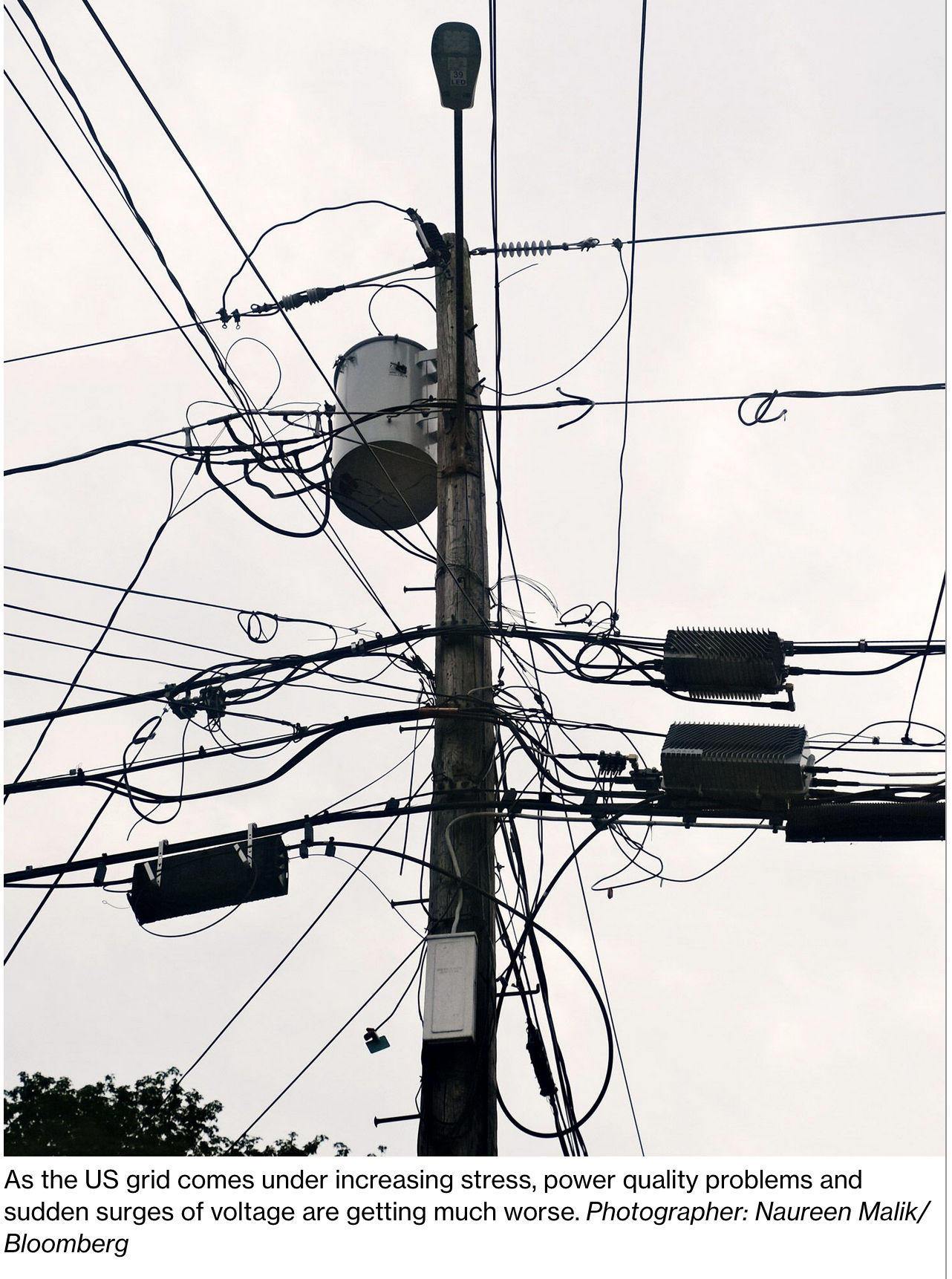
He was taking the trash out when he saw the red glow of flames engulfing a nearby home. A former firefighter, LeBlanc grabbed his shoes before racing across the street. He smashed a window, then rushed inside.
The only person believed to be home was a teenage boy who had already escaped, luckily with just minor burns. Alarms blared “fire” loudly, again and again, blasting from homes through the area.
“I’ve been in buildings without protection before — I just wanted to make sure no one was stuck in there,” said LeBlanc, who spent more than three decades as a firefighter before retiring.
The damage to the Alonge family’s four-bedroom home built in the early 1800s was so bad they haven’t been able to return since the blaze in June. The source of the conflagration in Waltham, Massachusetts, came from a facility about 2 miles west of the home.
An electric substation, which had been dealing with a rodent infestation, had a sudden, unstable surge in voltage.
At least 1 million US homes are at risk because of something most Americans don’t have much knowledge about: dangerous power quality.
When homes experience good, or stable, power quality, it means that the flow of electricity powering lights and appliances is being delivered at an even and predictable pace, ensuring electricity consumption is perfectly matched with supply every minute of the day.
It’s the sudden surges or sags of voltage that can lead to disaster.
In Waltham, there was a problem at the substation. The blaze there stands out as a rare case where a fire was identified as being connected to a sudden voltage surge.
Typically, utilities, municipalities and regulators lack the technology and reporting mechanisms for finding and disclosing that connection. In some ways, the lack of knowledge and public reporting around this threat makes it appear more menacing.
Interviews with more than two dozen experts, along with exclusive data, public reports and regulatory filings, paint the picture of a country dealing with power quality that’s rapidly worsening, with potentially deadly consequences.
These issues have existed for decades, with grid operators responsible for minimizing and controlling the danger. But as the US grid comes under increasing stress, the problems are getting much worse.
“Waltham is significant and a horrific example of what bad power quality can do,” said Jon Wellinghoff, former chairman of the Federal Energy Regulatory Commission who’s now chief executive officer of consultant GridPolicy Inc.
“The same thing could happen in Chicago or Houston or San Francisco or a myriad of other communities where poor power quality exists.”
Eversource Energy, the utility that operates the grid in Waltham, contends that the surge and an earlier one in October 2022 were unrelated and shouldn’t be considered indicative of broader power quality issues on its system.
The incidents were “caused by unrelated, isolated and separate mechanical equipment issues that have since been identified and addressed to the satisfaction of both the city and our regulators,” Eversource said in an emailed statement.
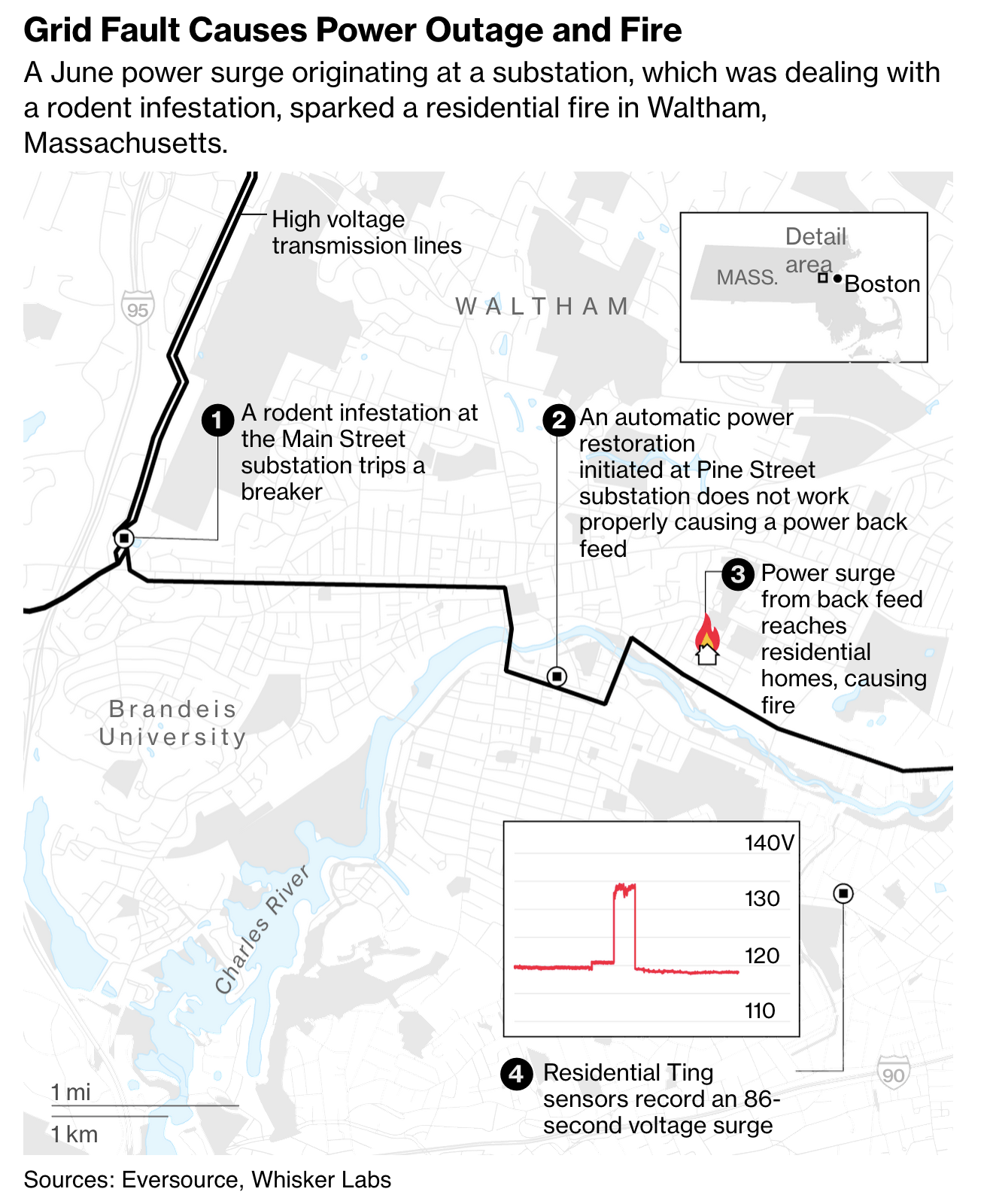
Stress on the nation’s electric grids is accelerating at an unprecedented clip. Demand is climbing just as aging infrastructure strains under the massive overhaul needed to adapt to renewable energy.
This convergence is making it harder to maintain safe, reliable power quality, and some regulators and utilities aren’t tracking the problem.
It’s an issue that has a potential national price tag of hundreds of millions of dollars, if not more. Fire departments responded to an average 46,700 home fires a year involving electrical failure or malfunction in 2015-2019, according to the National Fire Protection Association.
These blazes caused about $1.5 billion annually in property damage along with being responsible for 390 civilian deaths and more than 1,300 injuries. While it’s unknown how much of that can be directly connected with power quality issues, the worse the problem gets, the more those overall figures are likely to keep rising.
It can be hard to pinpoint the exact cause of fires when they are linked with electric lines and other equipment. Many utilities in the country don’t have the technology or data to determine whether the issues stem from power quality, or some other problem.
Volatile weather is also a contributing factor to power quality problems, and the more resilient a grid is, the more it is able to withstand extreme conditions.
Data from Whisker Labs Inc., which developed smart-home sensor technology to monitor surges and power quality, can help show when fire risk is building.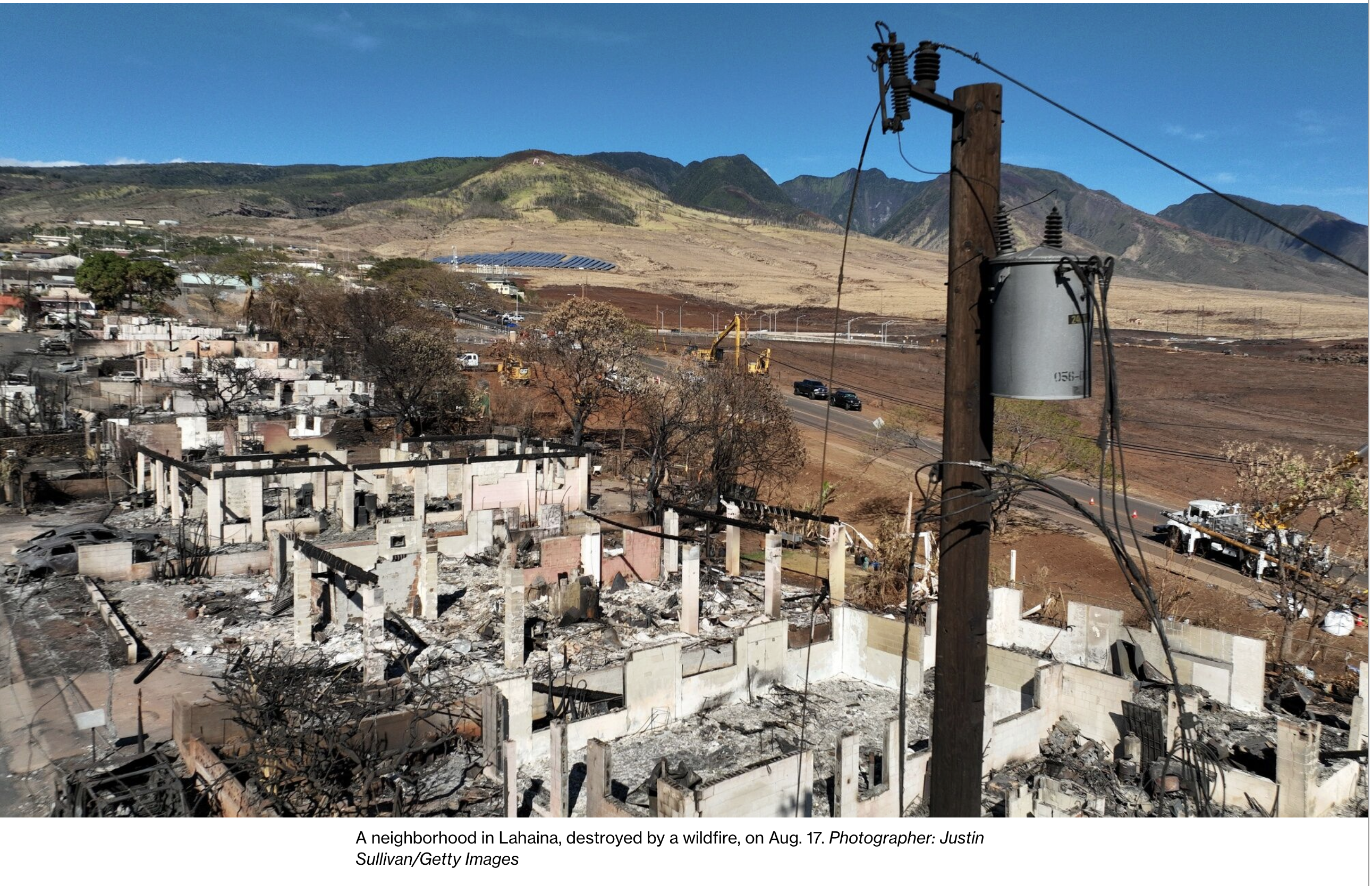
A grid fault, or power quality issue, occurs when the voltage surges (or sags) more than accepted by industry standards. Individual homes that experience repeated swings over days or even hours are under more serious threat — even if the fault is the symptom of larger forces, rather than the cause of the problem.
Take the case of the devastating August fire in Maui. The blaze razed the historic seaside town of Lahaina and killed at least 101 people, the country’s deadliest wildfire in more than a century.
Investigations are still ongoing into the cause of the fire, and the local utility, owned by Hawaiian Electric Industries Inc., has repeatedly said the company isn’t to blame.
Leading up to the fire, the biggest danger to the electric system came from extreme winds that were blasting through Maui. Ultimately, it may prove to be the case that the source of ignition was a downed power line.
But for hours before the devastating blaze, there were signs of voltage swings. Those faults weren’t likely the cause of the disaster, but they did signal the growing threat to the power system.
As the gusts picked up overnight in Maui, conditions on the grid started to deteriorate, said Bob Marshall, chief executive officer of Whisker Labs.
The company’s network of more than six dozen sensors around Maui detected about 122 grid faults starting just before midnight and into the next morning, before the blaze began.
The most-intense readings were concentrated around Lahaina, he said. Typically, the island sees less than a dozen faults a day.
Hawaiian Electric declined to comment on the fault data.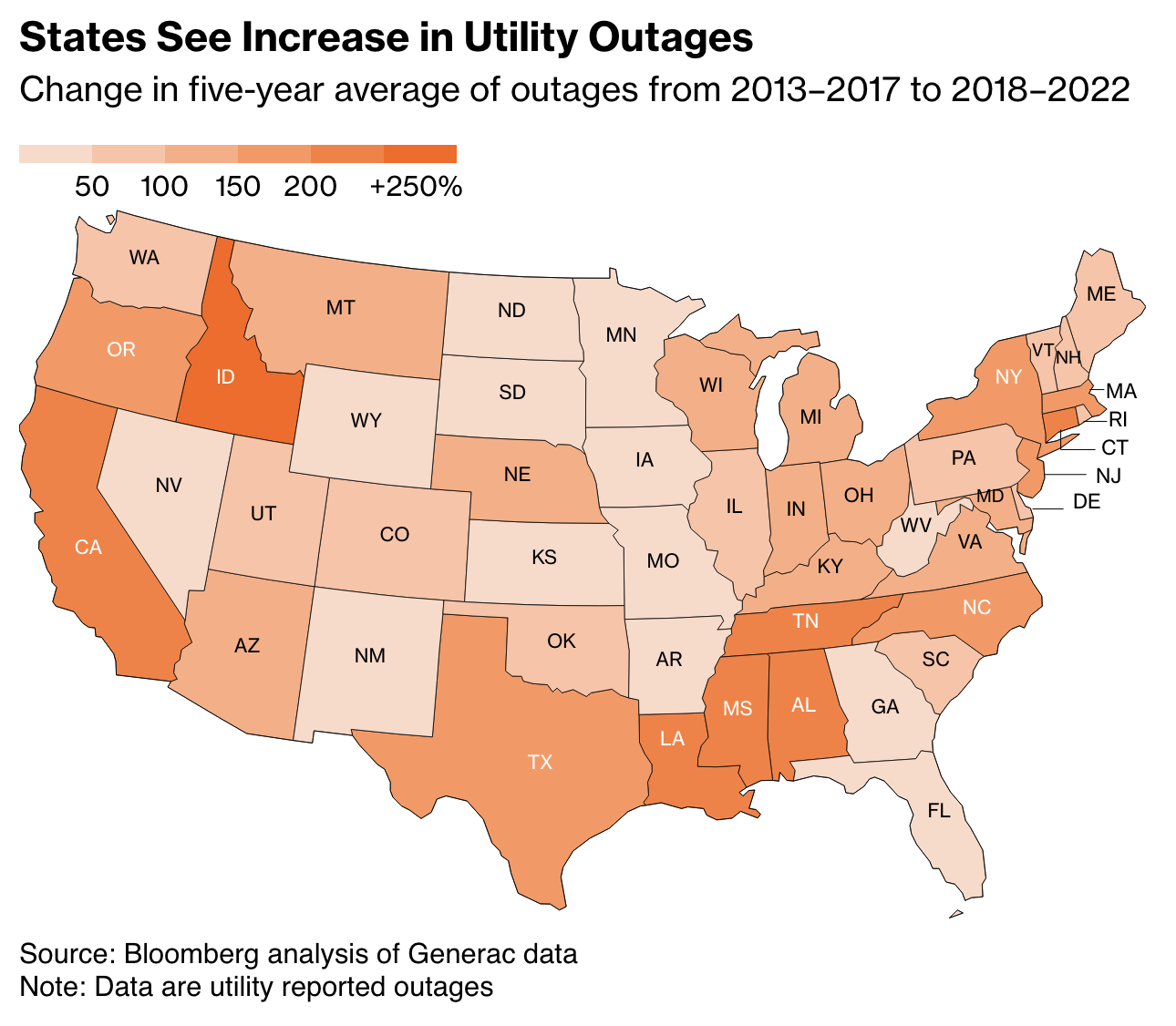
Threats from the electric system are especially dangerous in dry regions, where the environment becomes kindling to even the smallest of sparks, and strong winds, like the gale forces seen in Maui, can spread the embers.
“Anything that creates heat is susceptible to ignition,” said Paul Way, an expert with fire protection engineering firm Jensen Hughes who has served as an investigative engineer for three decades.
Way was retained to investigate the cause of the Maui fire on behalf of a group of insurance companies.
In addition to weather-driven events, voltage can also swing if a squirrel eats through wiring, or falling tree branches take out poles and wires: Last year in northern New Jersey, 2,000 people lost power after a bird reportedly dropped a fish on a transformer located atop a pole.
Still, while voltage surges can stem from weather events or animal interferences, it is largely the responsibility of utilities to maintain and repair facilities, power lines and other equipment to make their systems more resilient.
The hurdle is that most utilities don’t have the sensors that would “enable them to know that stress and faults are building on the grid,” Marshall of Whisker Labs said. “How do utilities not know how their grid performs and how resilient the grid is?
Obviously, there are gigantic consequences to a grid that lacks resiliency.”
Think of the power system in the US like a system of roadways. There are highways, where electricity moves fast at high voltages, to transport power produced at plants.
To get off these highways, the electricity moves through places called substations, which act like an exit ramp where power can be downgraded to lower voltages.
At the lower voltages, it can flow through into smaller systems, like the wires connected to the electric poles on the streets of neighborhoods. When everything is working properly, electricity flows to all the places it’s needed at an even rate and at the proper voltage.
Whisker Labs has deployed more than 500,000 plug-in sensors, called Ting devices, in homes across the country, to help detect voltage swings.
The pace of new installations is expected to jump from the current rate of 50,000 units per month to 80,000 by this December, Marshall said. Insurers such as State Farm have provided Ting sensors to customers to act as detectors for electrical anomalies.
The Chicago area has been a persistent hot spot for power quality issues, measuring voltage swings 10% above or below the levels deemed safe for household usage by industry standards, Whisker Labs data show.
In recent months, Louisiana, Florida and Georgia have seen disturbances jump as well. Households outfitted with sensors experienced an average fault rate in 2023 that was 18% higher than the 2022 average, according to the company.
Parts of Texas are also areas of concern. The combination of “explosive” power demand growth and extreme weather in the winters and summers brought on by climate change are increasingly stressing the network serving the Texas state capital, Austin Energy Spokesman Matt Mitchell said.
Marshall estimates that about 1% of homes have dangerous power quality problems, representing fire hazards. That’s extrapolated from current Ting installations, meaning the real number could be much higher.
Power quality issues are likely to “only get worse” with larger adoption of electric vehicles and “other migration to full electrification,” said Wellinghoff of GridPolicy, who also serves as a non-paid member of an advisory board of experts for Whisker Labs.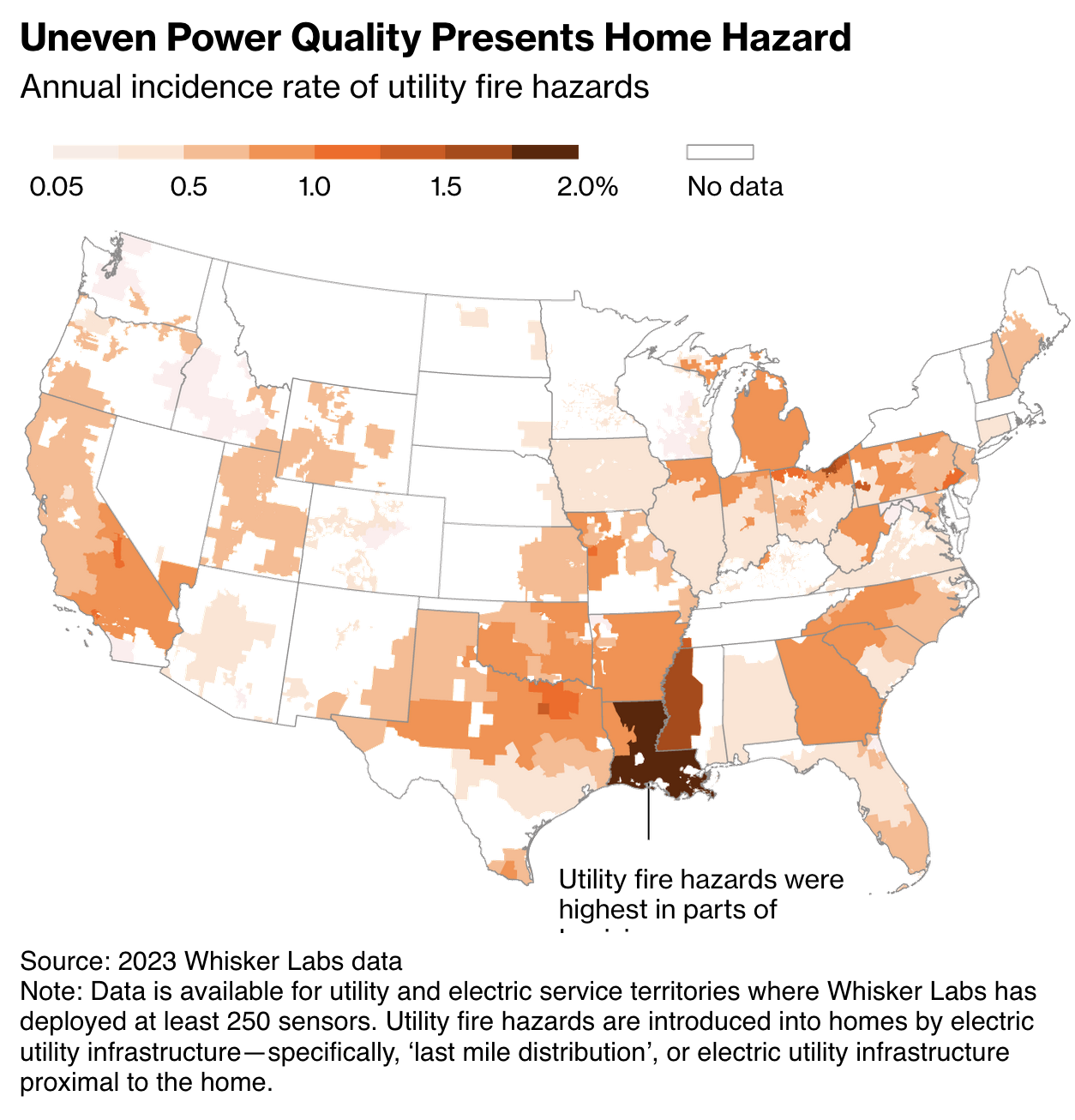
For those who don’t have a Ting device installed, the main indicator of a power quality issue might be flickering lights — a mundane occurrence that might be masking a deeper threat.
In Waltham, on that balmy June morning, the fire at the Alonge home wasn’t the only one.
A shed next door to LeBlanc’s home caught flame and was just inches from igniting a lawnmower’s fuel can before it was contained by firefighters. Throughout the neighborhood, surge protectors blew while appliances including water heaters and air conditioners became inoperable or were damaged.
LeBlanc was up by his typical 6 am. Before the chaos began, he’d noticed a few brownouts lasting 5 to 10 minutes.
“I’m usually up by 5:30 or 6 because my granddaughter, my three-year-old granddaughter, lives here — so I’m up,” he said. “It happened several times through the morning.”
He didn’t think much of it. That kind of flickering isn’t too uncommon, after all.
It was, however, a warning.
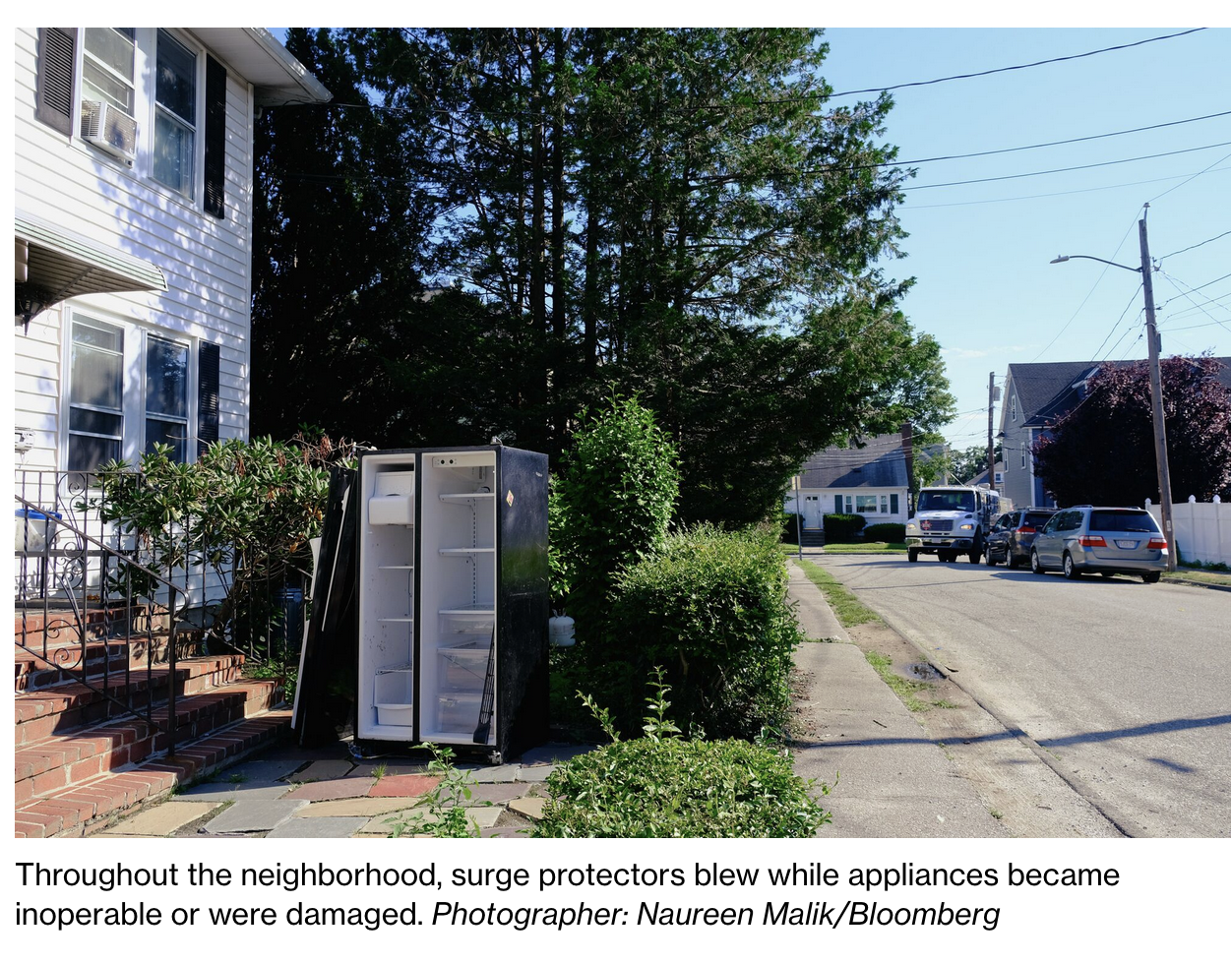
Breakers, used to control power quality disruptions, had failed at the nearby substation. The facility experienced a voltage surge, according to utility Eversource.
Eversource said that the surge and an earlier one in October 2022 were unrelated.
“It is irresponsible to extrapolate two isolated instances of temporary overvoltage in Waltham as indicative of broader power quality issues on our system,” the utility said.
“There were no reported power quality issues in the area prior to or following these incidents, which were caused by unrelated, isolated and separate mechanical equipment issues that have since been identified and addressed to the satisfaction of both the city and our regulators.
The safety of the electric system is always our priority and we have highly skilled engineers and lineworkers who monitor the system around-the-clock and are always ready to address any system issues that arise.”
The power disruption was the result of issues originally stemming from a rodent infestation inside an electrical conduit, James Van Nostrand, chair of the Massachusetts Department of Public Utilities, said in a letter to city officials.
“The isolated mechanical issues — one of which was caused by rodents — that took place in Waltham are not examples of what would be commonly referred to as ‘power quality’ issues, and there are not any widespread power quality issues within our electric service territory,” Eversource said.
Ultimately, the surge caused fire damage so bad that the Alonge home was ravaged. Its iconic New England white side paneling had melted off the sides of the structure.
After the June fire, the local regulator said it was satisfied by Eversource’s move to redesign parts of the substation and install new breakers, forgoing the need for a formal investigation.
Of course, flickering lights and other grid disturbances are challenges that have been around for decades. Utilities have had protections in place, such as breakers, to isolate problems.
What’s happening now is different.
Rising electricity use, the digitization of the economy and the complete overhaul of grids taking place across the country amid the energy transition are stressing the electric system to an extreme, making it harder to control power quality and ensure its reliability.
Volatile weather also adds to the pressure. And because of a lack of large-scale energy storage, the supply being pumped out of power plants has to be kept in balance with households and businesses every minute of the day.
“It’s becoming more challenging for utilities to understand what their loads are, and how to manage them,” said Rob Hovsapian, a research advisor at the National Renewable Energy Laboratory who is working with the US Energy Department and Atomic Computing to use quantum computers to improve grid management.
Traditionally, utilities and regulators have looked at power quality narrowly through power-outage metrics. But a more expansive view that includes the overall impact on households from surges reveals the threats.
There have been warnings from federal agencies and power industry groups that these issues need to be addressed. But figuring out how much to invest in an area’s grid is also a delicate balance between strengthening infrastructure and keeping those investments affordable.
Costs for grid upgrades are typically passed on to consumers through monthly rate increases, and many households are already struggling with higher bills after a jump in energy inflation in recent years.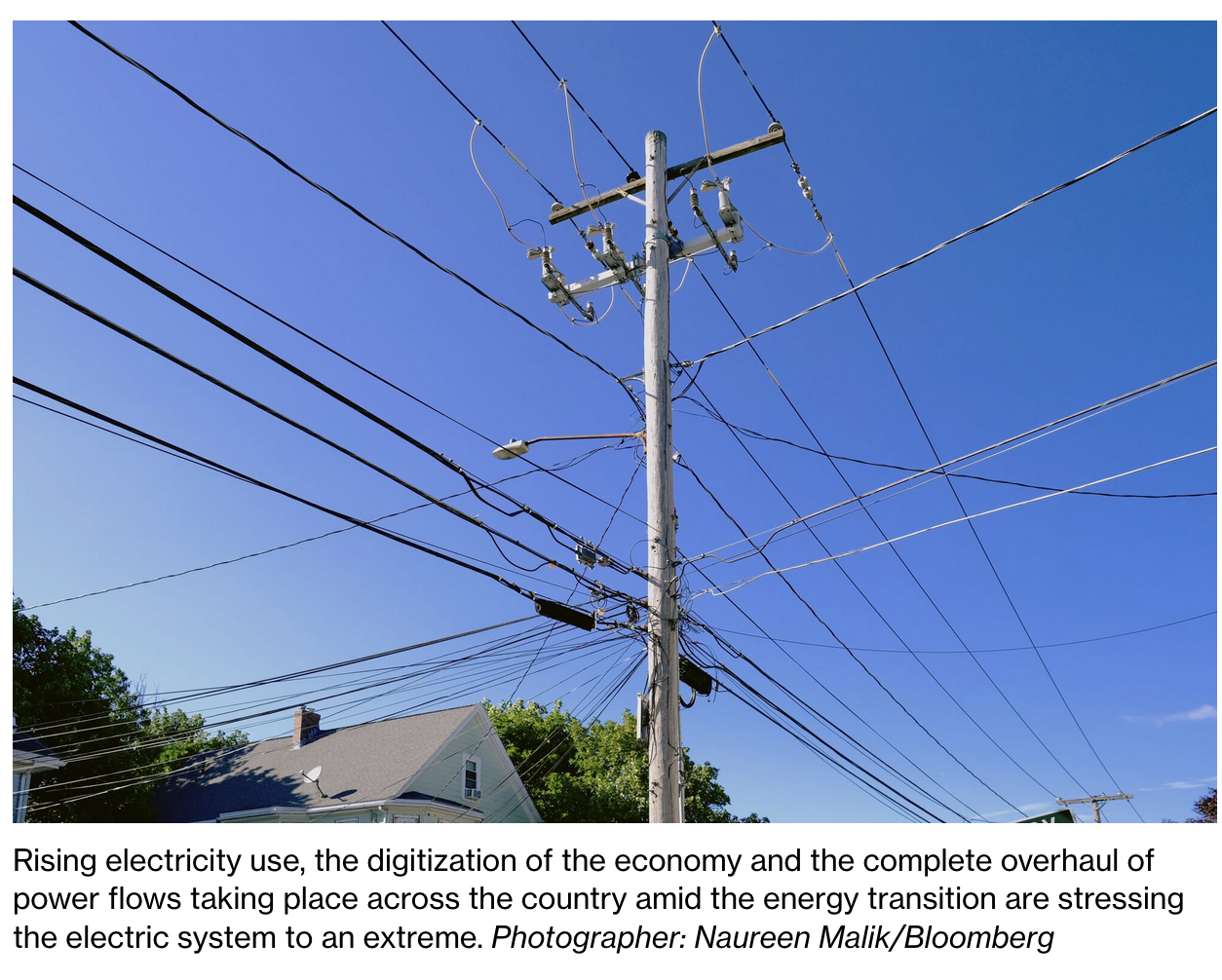
Beyond the threat of fires, power quality problems can also cause blackouts and brownouts.
Power outages lasting even a few hours create an “existential threat” to businesses, said Philip Krim, the co-founder and former CEO of Casper Sleep Inc.
He cited the example of restaurants that lose customers and have food that spoils and manufacturers that can potentially lose millions if production lines have to shutter.
In the coming months, Krim is launching a new insurance company providing coverage to small businesses specifically to cover losses from power outages through a recently formed incubator called Montauk Ventures.
Operators and utilities need to plan ahead to create a more resilient grid, said Allison Clements, a member of the Federal Energy Regulatory Commission. She cited new technologies that help to resolve some of the issues and the need for increasing transmission capacity.
Solar and storage have also started to play “a huge role” in keeping grids stable, Clements said, adding: “Are they the magical solution? No, but they’re a critical component of getting through these new challenging weather events.”
The technology exists to track grid faults that pose a danger, but it’s “not properly used to take into account this extra data set, which costs extra money or requires investment,” said Saifur Rahman, a professor at Virginia Tech who served as the president of the Institute of Electrical and Electronics Engineers in 2023.
“Until that regulation exists, the power company will not pay any attention to this.”
For years, Kali Patrick, who moved to Waltham in 1999, would’ve said that electricity was reliable in her town. “We always had great service,” even when other areas nearby lost power, she said.
She saw the lights flicker at her home about a mile and a half way from the fire during the June power-quality problem. She and her husband, who both work from home, had just spent about a couple thousand dollars days before the October 2022 surge to upgrade the electric panel on their 1920 Dutch Colonial home.
A week later, they spent another $700 to replace the surge protector and all of the breakers in the house at the advice of their electrician. Still, after the June fire, the thought of future surges has her on edge.
“Talk about losing sleep,” she said.
Related Articles:
California’s Privileged Use Private Fire Departments To Save Their Homes (#GotBitcoin?)
My Idea Of How To Finance The Management Of Wildfires
California’s Largest Utility Pummeled By Wildfire Risks (#GotBitcoin?)
California Utilities Plummet On Wildfire Fears (#GotBitcoin?)
Trump Is Responsible For Deaths In California Wildfires
Poll: The Cause Of California’s Wildfires Is Mainly Due To:
Your questions and comments are greatly appreciated.
Monty H. & Carolyn A.
Go back
Leave a Reply
You must be logged in to post a comment.